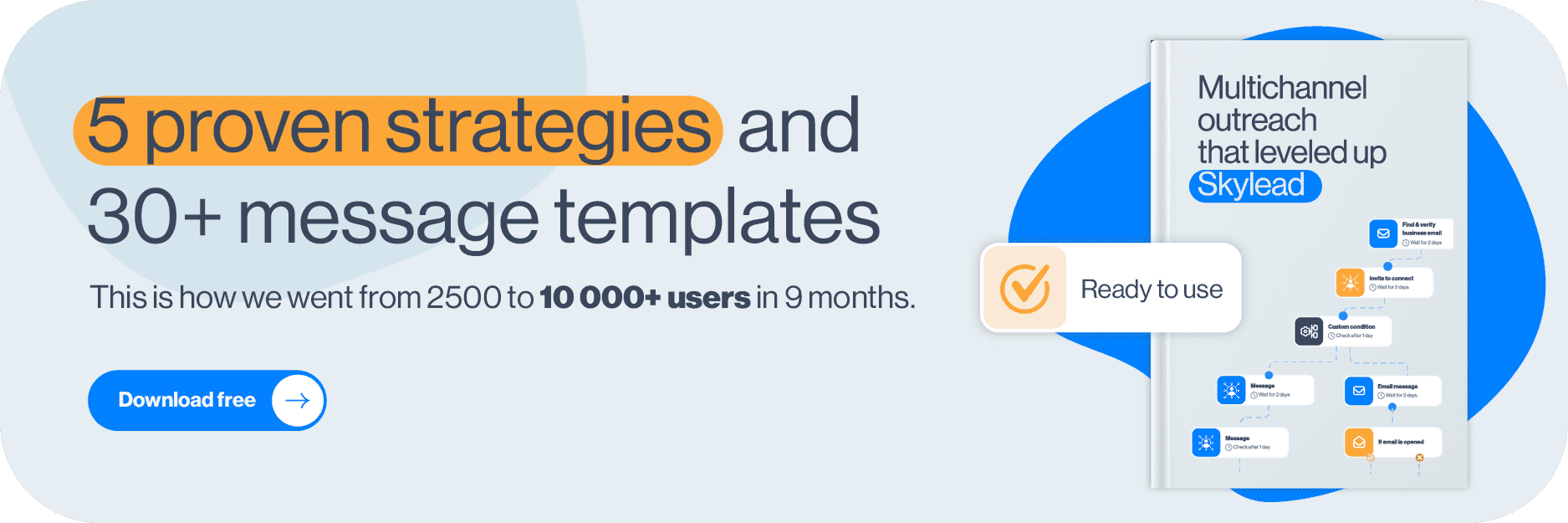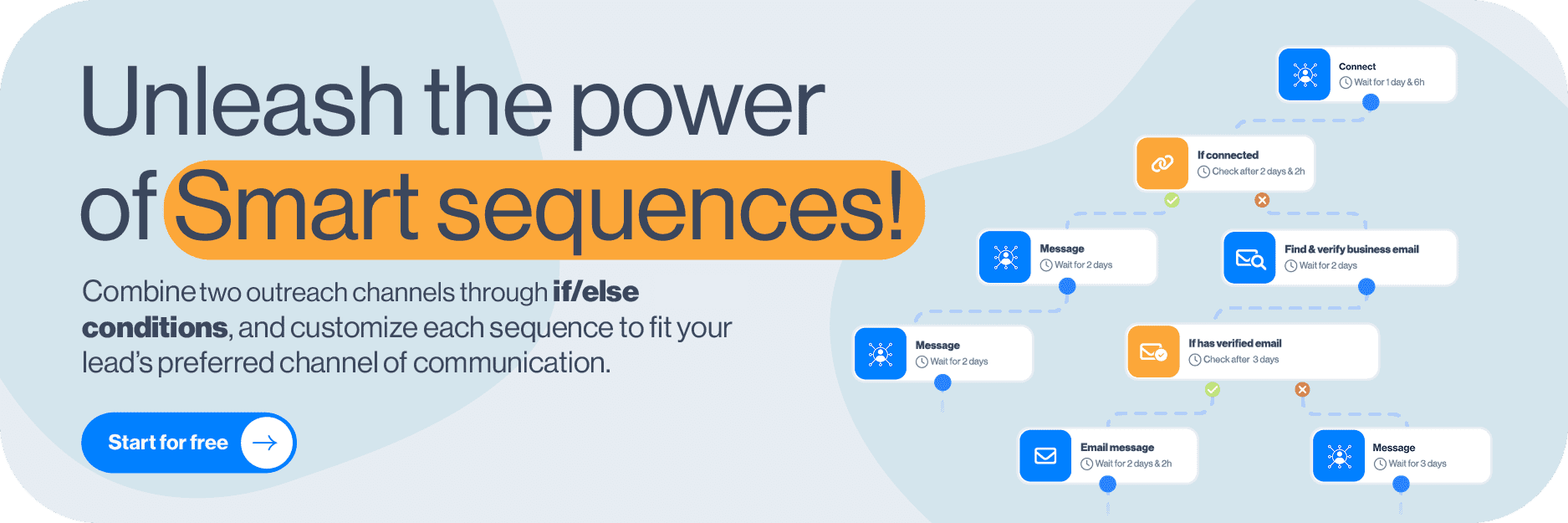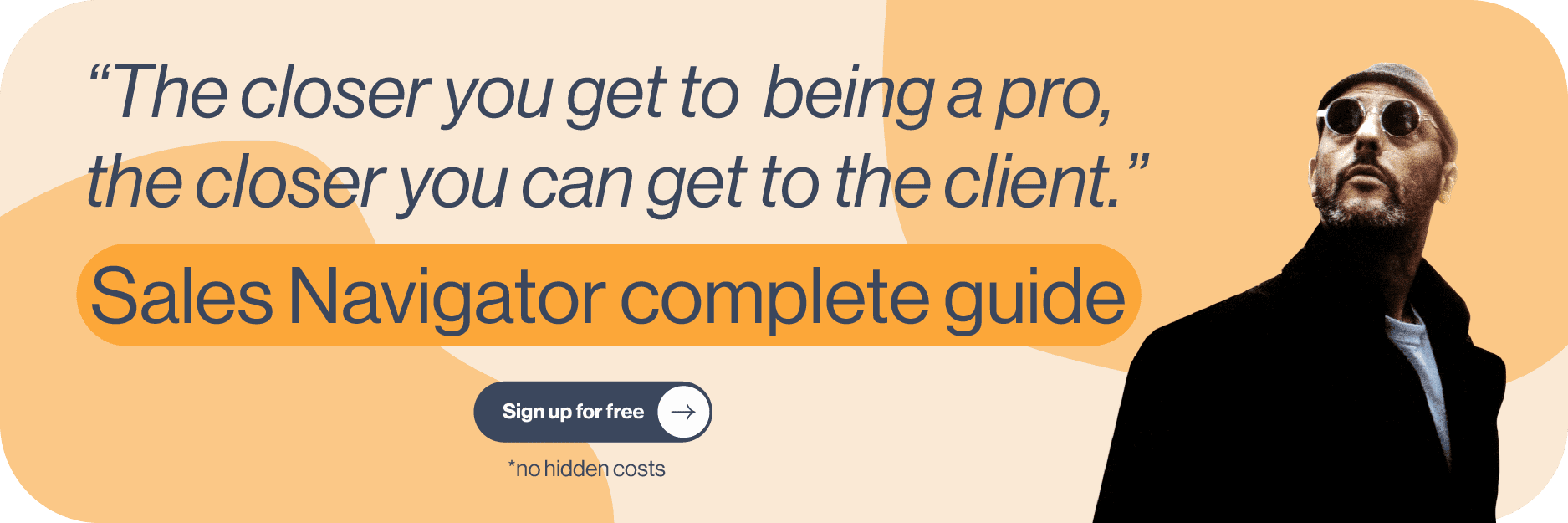In B2B sales, prospects rarely say ‘’I’m ready to buy’’ outright. They do, however, leave digital breadcrumbs, drop verbal hints, or show signs in their behavior that tell you exactly where they are in their decision-making process. These are called buying signals. Now, knowing they exist and what they are is one thing. But recognizing them, not to mention acting upon them? That’s a whole different story.
Having been in the B2B space for years, we have analyzed thousands of buying signals. Some were loud and clear - a demo request or a pricing inquiry. Others were more subtle, like a prospect revisiting your LinkedIn profile or forwarding your email to a colleague.
What we’ve learned is this: recognizing buying signals in real-time is a skill. Acting on them the right way is a strategy.
Now, it’s time you picked up on both the skill and the strategy. Thus, we’ll be walking you through the different types of B2B buying signals, both obvious and those not-so-much, and show you how to interpret them the right way. You'll also learn how to respond to them appropriately and how to make them work not just for new leads, but for nurturing existing customers too.
What are buying signals and why do they matter?
A buying signal is any action, behavior, or cue that suggests a prospect is considering a purchase. While there are different ways to categorize these signals (by type, channel, or funnel stage), they’re most commonly grouped by strength: strong, medium, or weak. This is usually based on 2 things: how directly the action indicates intent (e.g., booking a demo vs. liking a social post), and how close the buyer is to making a decision.
Now, why bother studying them? Because 77% of B2B buyers do their own research before talking to a sales rep. Which means that, by the time they get in touch, around 70% of the buying process has already unfolded. That said, if you’re waiting for them to raise their hand, you're already behind.
Buying signals help you act before that. They let you spot intent early, prioritize high-interest accounts, and personalize your approach to meet prospects exactly where they are in their decision-making process.
That said, buying signals aren’t just for new leads. They also show up in your existing customer base, for example, when someone starts exploring an upgrade, revisits your pricing page, or goes quiet after regular engagement. In all cases, knowing what to look for - and what to do when you see it - is what sets great reps apart.
Types of B2B buying signals
Not all buying signals are created equal. But all of them serve the same purpose: to show you where a buyer stands and what they might do next.
We’ve already mentioned that they can vary in strength. But another useful way to categorize them is based on how and where they show up during the buyer’s journey.
Broadly speaking, there are 4 core types of these buying signals:
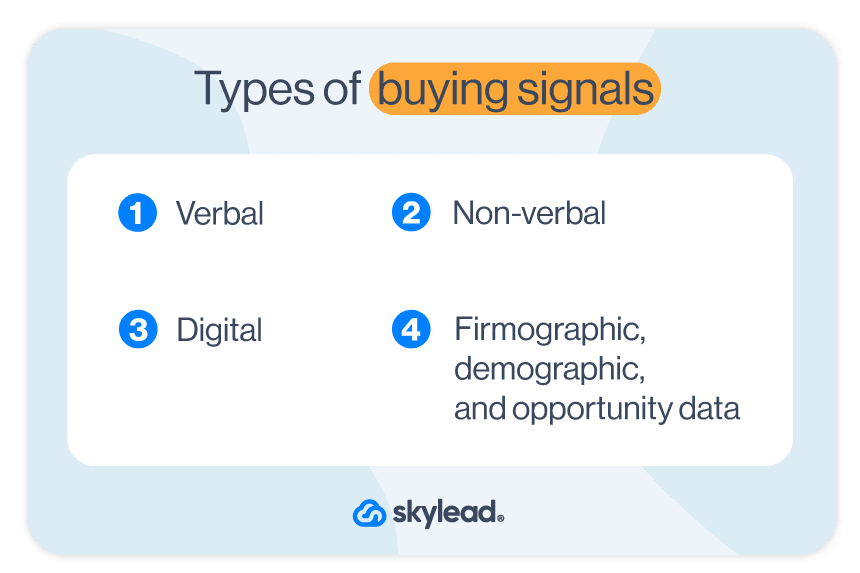
1. Verbal buying signals
If you couldn’t guess by their name, these happen during live or chat conversations, such as in meetings, calls, or via email. You’ll hear them when a prospect asks things like:
- How long does implementation take?
- Do you offer integrations with XYZ tool?
- What happens if we outgrow this plan?
What makes these so powerful is how explicit they are. A prospect who’s asking detailed questions is already thinking beyond discovery. Rather, they’re evaluating how your product fits into their world.
2. Nonverbal buying signals
These are trickier to catch but just as telling - especially on video calls or in-person meetings. They include body language cues, such as nodding, leaning in, taking notes, spending extra time reviewing your screen during a demo, etc.
While subtle, these behaviors often indicate interest, curiosity, or agreement. That said, a silent or still prospect isn’t necessarily disengaged. But it does take an observant seller to read between the lines.
3. Digital buying signals
You can find these by analyzing your website traffic, email engagement, content interaction, and other online behaviors that indicate growing interest.
Examples include:
- Repeated visits to your pricing or demo page
- Watching a full product video
- Clicking your CTA in a cold outreach email
- Visiting your LinkedIn profile multiple times
The upside here is scalability. Digital signals can be tracked and scored, giving your sales team constant insights on which leads are heating up and which ones need nurturing. Even better, they can help you actively move prospects down the funnel. For example, if someone keeps visiting your pricing page, your marketing team could place a banner prompting them to book a call, thereby sending warmer leads straight into your sales pipeline.
4. Firmographic, demographic, and opportunity data
These don’t come from the buyers themselves, but rather from the context around them. For example:
- A new VP of Sales joins your target account
- The company raises a Series B round
- Their team starts hiring aggressively
- Their current provider just got acquired
While these don’t scream buyer intent, they mean internal changes are on the horizon, and with them, a renewed interest in solving problems. That’s your cue to step in early, while competitors are still blind to the changes.
18 Buying signals to watch for [+ examples, strength indicators & what to do]
Now that we’ve covered the types of buying signals, let’s talk specifics.
Below are 18 real-world examples of signals your prospects might show. We have also included examples of what they might say or how they might act, along with how strong each of the signals tends to be. As a bonus, you’ll also find tips and tricks we found extremely useful for pushing your prospects further down the sales funnel.
In terms of signals, we’ll rank them as:
- Strong: Clear indicators of purchase intent. Typically happens late in the funnel.
- Medium: Suggest the buyer is actively evaluating, but might need more nurturing.
- Weak: Indicate early interest or surface-level engagement; not enough to act on just yet, but worth monitoring.
| Buying signal | Example or behavior | Signal strength | What to do to push prospects further down the funnel |
| Signs up for a free trial | Evaluating your product hands-on | Strong | Provide onboarding support to set new users up for success and reduce churn. |
| Requests a demo or pricing information | ‘’Can we walk through the pricing together?’’ | Strong | Book a call ASAP. Come prepared with pricing options and ROI arguments. |
| Books a meeting through your calendar link | Schedules time without being asked | Strong | Treat them as high-priority. Personalize your pitch using info they’ve already engaged with. |
| Asks detailed product or implementation questions | ‘’How long does onboarding take?’’ | Strong | Adjust your response based on their use case and offer to show how others onboarded. |
| Mentions internal urgency or timeline | ‘’We need to decide before Q4 starts.’’ | Strong | Match their urgency with clear next steps and time-sensitive offers. |
| Requests a custom quote or proposal | Asks for budget-specific documentation | Strong | Provide a custom quote and ask about decision-makers or approval processes. |
| Brings additional stakeholders into the conversation | Looping in the CEO mid-deal | Strong | Send a recap to all parties and address each stakeholder’s priorities. |
| Mentions dissatisfaction with a current solution | ‘’Our current tool isn’t doing the job.’’ | Medium | Position your product as the better choice without bashing competitors. Share relevant case studies or a comparison page with CTA. |
| Repeated visits to pricing, demo, or case study pages | 3+ visits within a week | Medium | Trigger an automated CTA or retargeting ad to book a call. |
| Downloads a product-focused resource | Grabs a case study or a product guide | Medium | Follow up and offer help with a product or a service resource. |
| Engages with outbound (positively) | Replies to a cold email or a LinkedIn cold message | Medium | Ask about their goals and pain points to deepen the conversation. |
| Mentions a recent job change or new role | New business decision maker in your ICP | Medium | Congratulate them and ask if they’re exploring new tools for the team. |
| Researches you on review platforms | Active on G2, Capterra, etc. | Medium | Offer to answer questions or share relevant success stories. |
| Downloads top-of-funnel content | Gets an eBook | Weak | Add them into a nurturing sequence with more product-focused content. |
| Likes or comments on your LinkedIn post | Light engagement with your brand | Weak | Send a soft LinkedIn DM with a resource or ask a light question. |
| Revisits your LinkedIn profile | Multiple views over time | Weak | Connect with a friendly note and offer to chat if exploring solutions. |
| Clicks a CTA in your email or ad but doesn’t convert | Visits a landing page, no action | Weak | Send a follow-up email asking if they need help or have questions. |
| Fills out a generic form without context | Signs up for a newsletter | Weak | Add them to a nurturing sequence and offer a helpful resource in the next email. |
📝 Note: A single signal rarely tells the whole story. Look for clusters of behavior. One visit to your blog? Weak. One visit plus a case study download plus a LinkedIn view? Now we’re talking!
Are objections buying signals?
Yes, sometimes objections are buying signals, rather than signs of rejection. In many cases, when a prospect objects, it means they’re seriously considering your solution - enough to start poking holes in it. That’s a good thing.
Just think about it. Someone who says ‘’I’m not sure this will integrate with our CRM’’ isn’t telling you no. They’re already imagining how your product would fit into their workflow. The same goes for concerns about pricing or timing. If they weren’t interested, they wouldn’t bother raising questions at all.
So don’t treat every objection as a roadblock, as some are actually proof that you’re doing something right. The point is to know when to clarify, when to reassure, and when to dig deeper, which is exactly what effective objection handling is all about.
How to identify and interpret buying signals
Spotting buying signals is part instinct, part process. Yes, some reps are naturally good at reading between the lines. But there are also practical ways to get better at it.
1. Listen actively and observe carefully
A lot of intent hides in plain sight - in how a prospect phrases something, where they pause, what they emphasize. You’ll notice it if you’re actually listening, not just waiting for your turn to speak.
The same goes for nonverbal cues on calls, video, or in person. While you can’t listen to them, you can pay attention to your prospects’ behavior. It will often tell you even more than words.
2. Use lead tracking/analytics tools
When it comes to digital signals, you won't catch them unless you're tracking what matters. Think: email open and click rates, LinkedIn profile visits, return sessions on your pricing page, content downloads, etc. Tools like Mixpanel, Leadfeeder, or Clearbit can show you who's engaging, how often, and in what way.
3. Ask open-ended questions to clarify intent
When something feels like a signal, don’t assume it is. Rather, ask.
Say a prospect brings up integrations. You could follow up with:
- Are you currently comparing tools?
- What would the ideal setup look like for your team?
Make sure your questions are open-ended instead of them being simple yes/no prompts. That way, you can test for real intent without sounding pushy, and give your prospect room to open up, which helps you qualify faster.
4. Look for patterns and validate with feedback
One action might be a fluke. Meanwhile, a cluster of actions? It’s a pattern. If a lead revisits your demo page, downloads a case study, and opens 3 emails in 2 days, there’s probably something going on. Combine behavior data with direct feedback from your calls or emails to confirm the signal before you act, though.
5. Use LinkedIn Sales Navigator Buyer Intent feature
If there were ever a cheat sheet to identify buying signals, it would have to be Sales Navigator’s Buyer Intent feature, currently available to Sales Navigator Advanced and Advanced Plus users.
This feature helps you identify not only which accounts are showing interest, but also exactly who at those accounts is engaging, and how. Not to mention, the feature is fully native, meaning you don’t need a separate intent platform or even a CRM sync to use it.
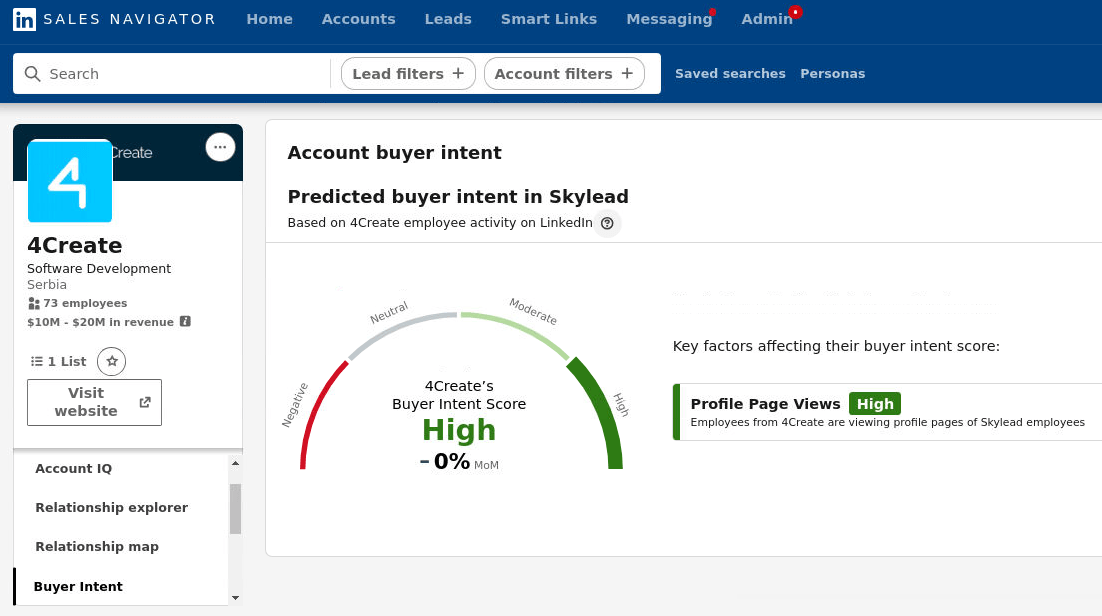
That said, here’s what it tracks and what you can see:
| Category | Buyer activity | What you see |
| Company engagement | Follows your Company Page | Profile of the person who followed your company page |
| Visits your Company Page | Profile of the person who visited your company page | |
| Employee interactions | Views your profile | Profile of the person who viewed your profile |
| Sends you a connection request | Profile of the person who sent you a connection request | |
| Connects with someone else in your company | Profile of the person who connected with someone in your company | |
| Views seller or leadership profiles at your company | Profile of the person who visited those profiles | |
| Ads engagement | Submits a LinkedIn lead gen form | Profile of the person who submitted the form |
| Clicks or engages with a LinkedIn ad | Profile of the person who engaged with the ad | |
| Outreach response | Accepts an InMail from someone on your team | Profile of the person who accepted the InMail |
| Website visit | Visits your official website (via LinkedIn tracking) | Profile of the visitor |
Now, where is the Buyer Intent feature hiding?
Well, you can access it via:
- The Account Hub dashboard (for saved accounts showing new activity)
- Lead and Account Pages (to see specific people/accounts and their actions)
- Homepage Highlights & Sales Navigator Alerts
- LinkedIn Sales Navigator filters, specifically the Buyer Intent filter and Product Category Intent (for filtering people who are interested in your category, not just your company)
All of this gives your team the context to act fast, prioritize the right people, and reach out when intent is at its peak.
Buying signal or false positive? How to tell the difference
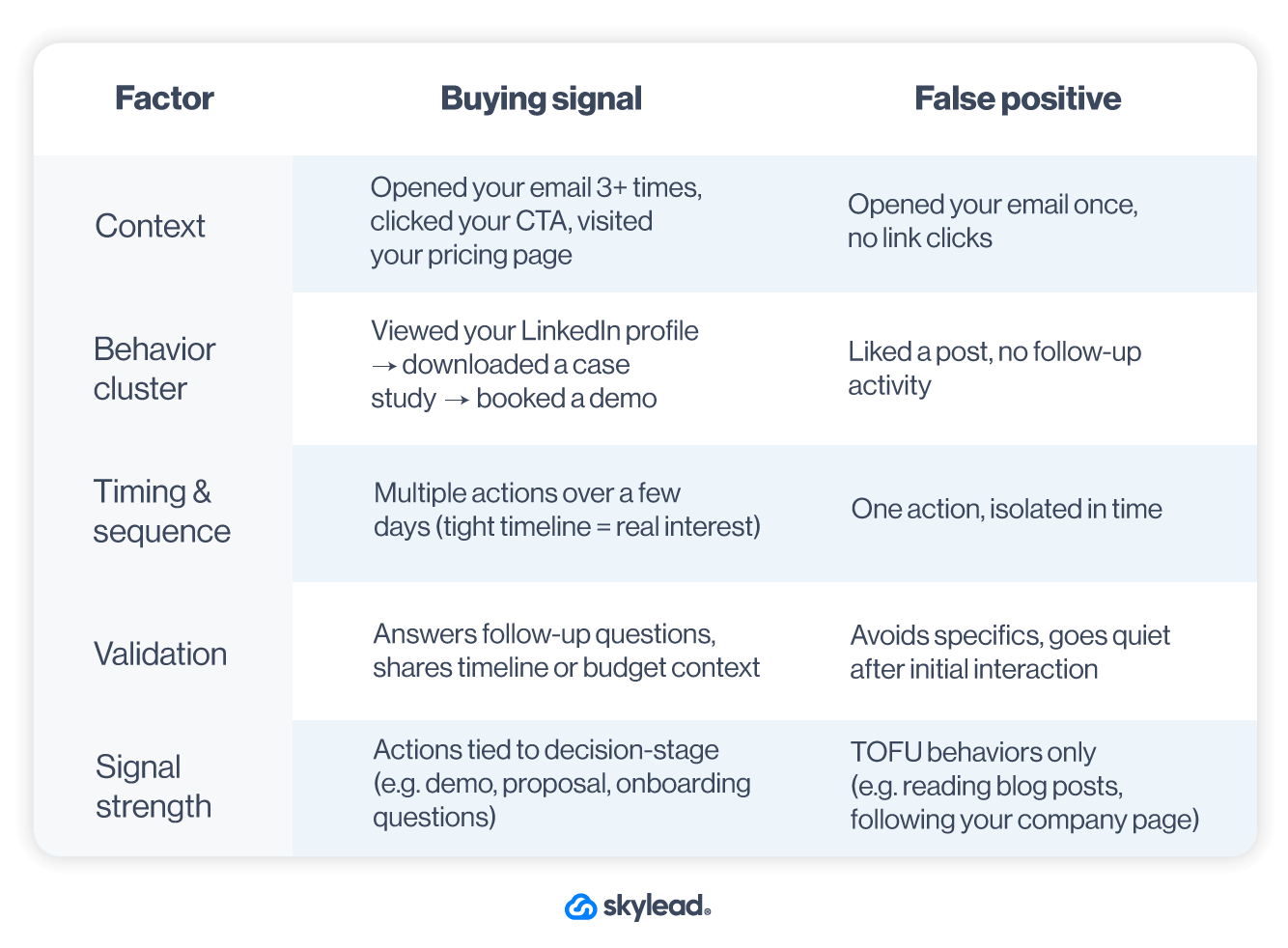
How to respond to buying signals
Spotting a buying signal is only half the job. What you do next? That’s where the deal is won or lost.
Here’s how to respond the right way:
1. Identify the signal quickly
The window of opportunity doesn’t stay open for long. The sooner you notice and interpret the signal, the higher the chance you'll meet them while they are in decision mode. Wait too long, and that intent can fade or shift to a competitor.
2. Personalize your response based on the signal
Not every signal warrants the same playbook. A pricing inquiry? Speak about ROI. A case study download? Reference similar customers. If they watched your product video, ask what stood out.
In other words, adjust your response and sales tactics to reflect what they just did or said. That way, your message feels like a continuation of the conversation.
3. Address concerns and offer help
If the signal is mixed, like a pricing objection or hesitation about fit, that’s not a red flag; it’s a conversation starter, so don’t dodge it. Instead, acknowledge the concern and provide help. You could pull in a case study, loop in a colleague, or simply ask them if they want you to walk through how other customers have handled the same issue.
4. Create slight urgency
No one likes being rushed - but no one wants to miss out either (hence the FOMO). That’s where subtle urgency comes in. You can mention onboarding timelines, expiring offers (only if real), or limited capacity, but keep the tone helpful, not hungry. Urgency works best when it sounds like guidance rather than desperation.
5. Guide the prospect toward the next step or close
Every signal should move the deal forward. Your job? Make that next step clear and easy. That might mean scheduling another call, sending a proposal, getting feedback from other stakeholders, or confirming implementation timelines. Whatever it is, don’t assume they’ll take the leap alone - lead them there.
Taking advantage of buying signals
Spotting a buying signal is all fun and games. But you still need to act on it. The good news is you can do that through Skylead - your ultimate multichannel outreach tool and sales engagement platform.
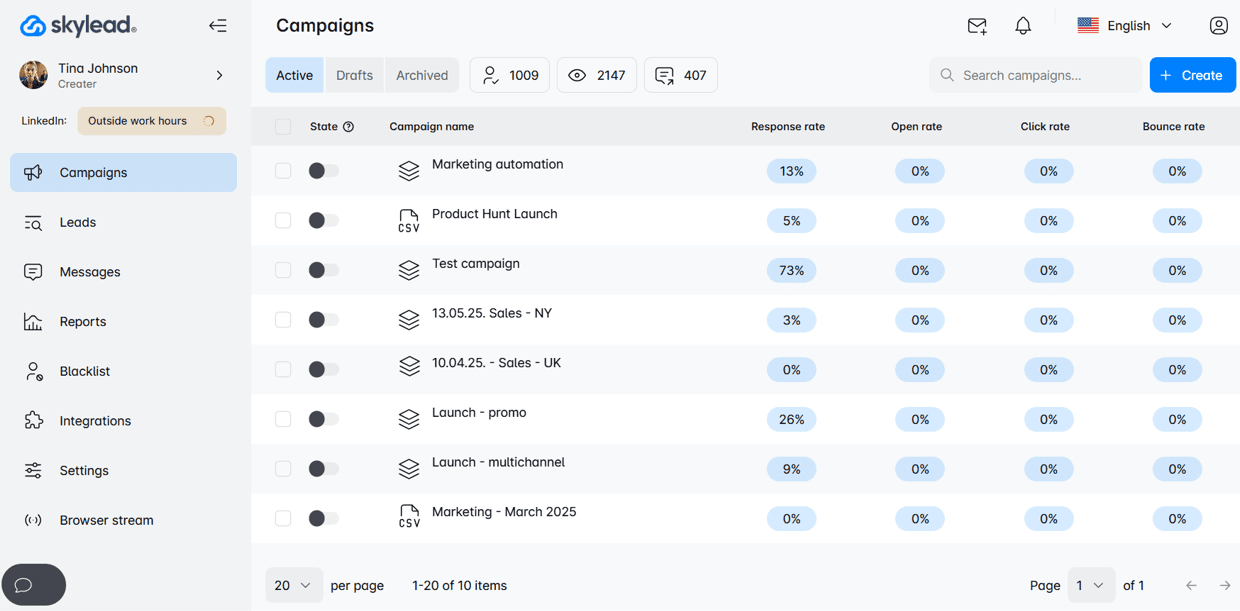
Skylead is best known for Smart sequences, a.k.a. smart outreach sequences that combine if/else conditions with outreach actions. Smart sequences help you react based on your lead’s behavior, helping you reach them through the fastest possible route.
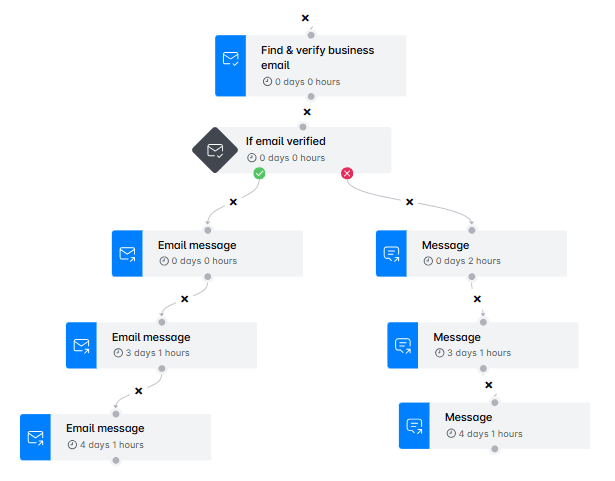
Now, what’s good about these sequences is that they let you structure your outreach in a way that:
- Recognizes buying signals
- Responds to them
Here’s what that might look like in practice:
Scenario 1: Prospect opens your email
Say you want to address a buying signal where your prospect opens your email but doesn’t reply.
Start by adding an Email step to your sequence. Then, right after it, insert the “If email opened” condition.
Now, say the lead opened your email but didn’t respond. Then, you can add a new path with a follow-up email after no response - one that’s more direct or designed to re-engage interest.
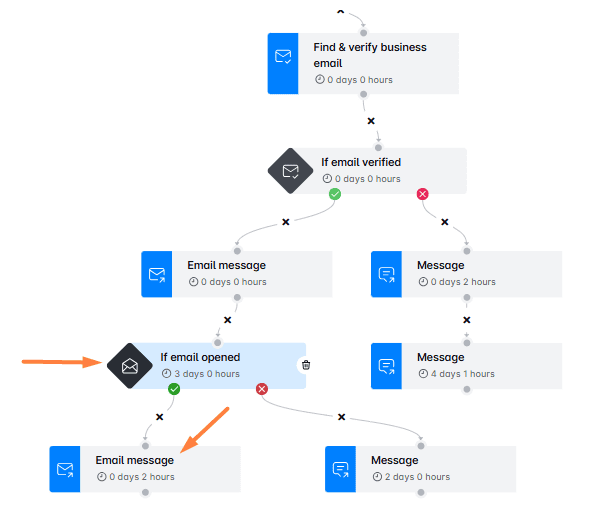
Scenario 2: Prospect clicks your meeting link
Now imagine your first email includes a link to book a call. After that step, you add the “If email link clicked” condition.
If they click but don’t respond, just plug in another Email step to the “yes” path. In this message, you can offer alternative time slots or ask if they need more info before booking, making it easier for them to take the next step.
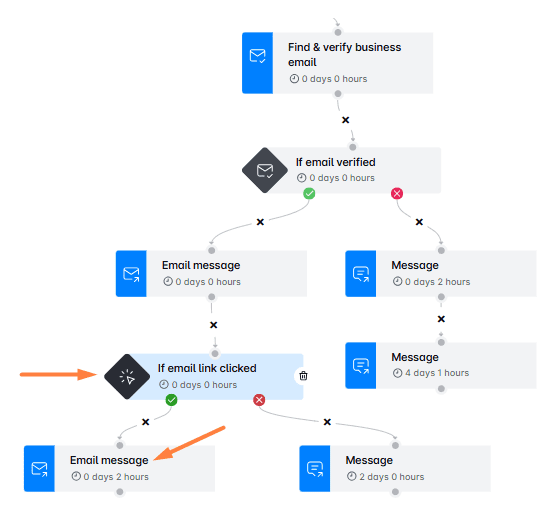
Not sure which message will work best? Run an A/B test with up to 5 versions to see what resonates.
Want to make it personal? Add variables (or define your own custom variables) to your message to make it feel custom-made.
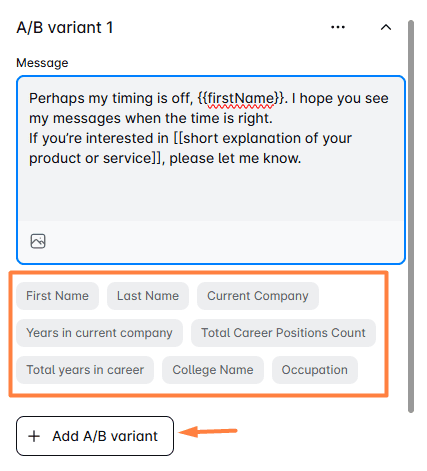
And if you really want to stand out, use Skylead’s native Image & GIF personalization feature. You can add names, pictures, logos, or custom text to your visuals and see your reply rates jump by up to 76%.
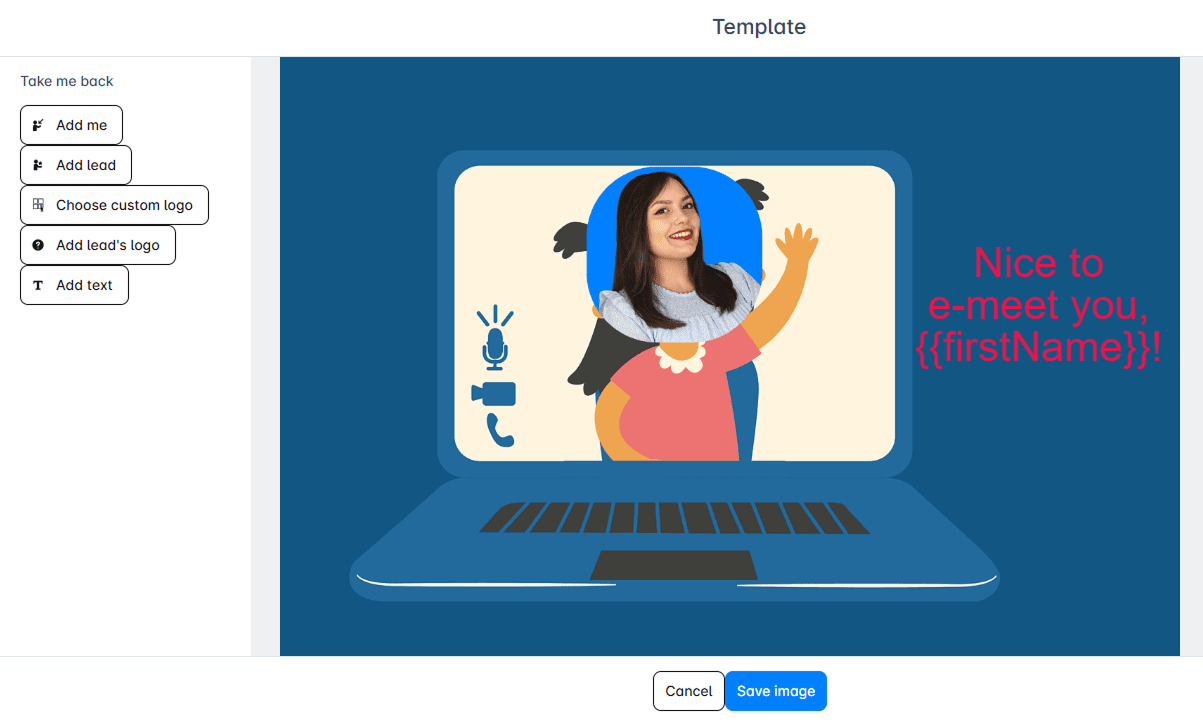
Even better, there’s no cap on how far you can scale this. In fact, you can:
- Connect unlimited mailboxes to send tens of thousands of emails per month, all at no extra cost.
- Warm up infinite mailboxes through our partnership with an email warm up tool, InboxFlare, so your emails land in the primary inbox, not spam.
And if you don’t have your leads’ emails yet? No problem. Just add a “Find & Verify Email” step to your Smart sequence. Skylead will discover and double-verify each email before sending anything, so your outreach keeps flowing without interruptions.
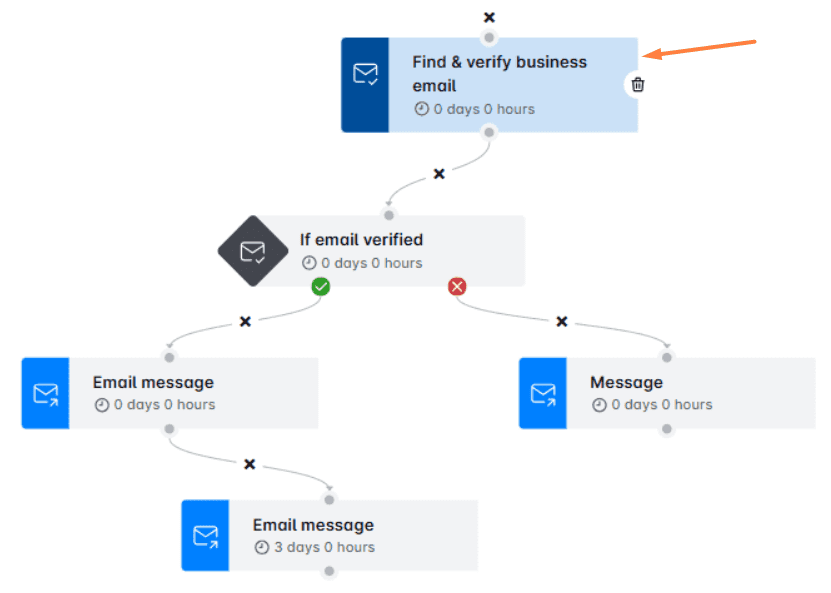
Frequently asked questions
What’s the difference between a sales trigger and a buying signal?
A sales trigger is an external event that creates an opportunity to sell, like a company raising funding, hiring new leadership, or launching a new product. It’s a sign that something’s changing inside the business. A buying signal, on the other hand, is a specific action or cue from the buyer that indicates interest or intent, like watching your product video, asking about onboarding, or replying to a cold email.
Can you automate buying signal detection?
Yes. Most sales and marketing platforms now offer behavioral tracking that can detect buying signals in real time. These tools often integrate with CRMs for sales and sales outreach tools, thereby helping you act on signals as well.
Are buying signals useful for cold outreach?
Absolutely. While buying signals are often associated with warm leads, they’re just as powerful in cold outreach. That’s because, even in cold outreach campaigns, prospects show intent by opening emails, clicking links, replying with questions, etc.
These micro-signals help you:
- Prioritize the right leads
- Adjust your messaging
- Know when it’s time to follow up or try multichannel outreach
What if I misread a buying signal?
It happens. Not every action means a prospect is ready to engage. But if you misread a signal, the point is to remain helpful and keep it low-pressure. You can send a follow-up that adds value or asks a clarifying question, as it won’t hurt the relationship. In fact, it might even uncover real intent you didn’t see at first.
Deals go to those who notice the buying signals
Prospects rarely come out and say, “I’m ready to buy.” But their actions? They give you all the clues.
Spotting those buying signals and reacting fast is what makes the difference - and Skylead helps you do both!
Try it free for 7 days and start turning silent signals into booked calls, more replies, and 3x more deals.
Disclaimer: Skylead is not affiliated, endorsed by, or connected with LinkedIn in any way.
LinkedIn is the perfect place to connect with colleagues, school alumni, and like-minded individuals. But have you thought about using LinkedIn for B2B marketing?
If you haven’t yet, it's time you did!
After all, it would be a shame not to tap into its massive pool of 1 billion users and counting, especially when LinkedIn’s own stats suggest that 80% of them participate in the decision-making process.
Not quite sure where to start? This blog is for you!
Stay tuned, and we’ll show you everything from whether—and how—LinkedIn works for B2B marketing to how to use it to your advantage.
Is LinkedIn good for B2B marketing?
LinkedIn is not only good for B2B marketing, but it’s also the preferred place to engage in it.
In fact, a whopping 96% of B2B marketers have recognized the power of this platform and have chosen to make it their marketing ground base.
Meanwhile, 84% of them reported that, out of all social media outlets, LinkedIn was the place where they found the most success.
Diving deeper into statistics, 40% of B2B marketers say that LinkedIn is the most effective channel for lead generation. This is because it contributes to the acquisition of higher-quality leads that are 6x more likely to convert.
No wonder LinkedIn’s B2B advertising revenue for the current year alone is 4.56 billion dollars!
Why use LinkedIn for B2B marketing?
Surely, you can use Facebook, Instagram, X, and other social media channels for advertising purposes. But what makes LinkedIn a game-changer for B2B marketing is the type of crowd it attracts: professionals. The majority of whom are decision-makers, nonetheless!
Here, you won’t typically find the casual chatter or viral videos common on other networks (though the occasional office humor does pop up!).
Instead, it’s the platform that encourages individuals to connect with one another and engage in industry-focused conversations that help companies:
- Increase brand awareness
- Establish authority and credibility
- Drive engagement
- Accelerate lead generation
- Boost conversions
So, if you're in B2B, not using LinkedIn for marketing is like leaving money on the table. It's where you gain access to big industry players and where your next big deal could be a connection away.
How to use LinkedIn for B2B marketing?
Now that you know why LinkedIn is a B2B marketers’ paradise, it’s time to discuss how B2B businesses use it.
And what better way to present the marketing use cases than to draw from our own experiences?
So, without further ado, here’s how other companies and we, the marketing team in Skylead - a leading sales engagement tool - use this platform to rock B2B marketing. And it’s how you can use it as well!
Expand your network to mingle and supercharge your LinkedIn for B2B marketing
LinkedIn is as much about who you know as it is about who your connections know.
The more people you are connected with, the higher your reach and the chance that another business will notice yours.
That said, for successful and organic B2B marketing on LinkedIn, it’s important to work on expanding your network. It’s what we did.
However, we didn’t and neither should you add just about anyone to your connections! Instead, engage in some quality LinkedIn prospecting and target individuals relevant to your industry who can help you scale your business.
Of course, once they are in your network, your work doesn’t stop. It’s your job to mingle to build those relationships. Like their posts, share them, and comment on them. This will keep you on their radar and increase the chances of your content and your company being seen by their connections.
Become a thought leader
Thought leaders are seen as authoritative figures in the field. As such, they naturally attract more connections and business opportunities.
But, what is it that makes a thought leader…well, a thought leader?
Our CEO, Relja, is the perfect example of one.
He’s become influential on LinkedIn by following these steps:
- Sharing valuable content;
- Publishing original posts on LinkedIn that spark discussion and solve problems or address burning industry questions;
- Engaging with other people’s posts through likes, comments, and shares;
- Posting our company updates and sharing our mission and values;
- Hosting webinars and masterclasses;
- Staying updated with the latest industry developments and news.
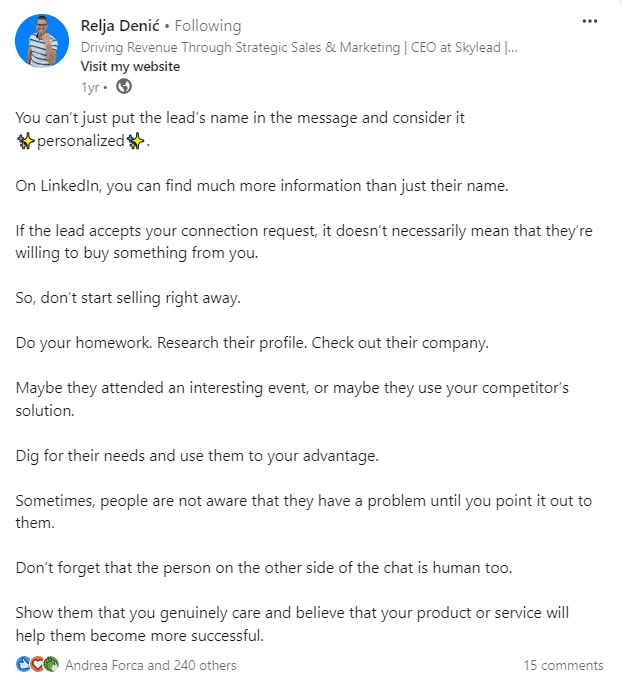
You won’t become a thought leader overnight. It’s an achievement that requires consistency, commitment, and genuine interaction with your community.
Nevertheless, if you follow the same steps we mentioned above, you’ll undoubtedly start to build a reputation on LinkedIn as a knowledgeable and respected professional.
Use LinkedIn to distribute content for B2B marketing purposes
When not working on new content or strategizing and executing marketing activities, you’ll typically find Skylead’s marketing (and sales) whizzes distributing our content on LinkedIn.
This is where having a wide network really pays off and often results in a dramatic increase in visibility and traffic.
To distribute the content, we use a mix of different post formats (regular posts, photos, short videos, etc.). We also encourage cross-team sharing and have found it does wonders for our reach!
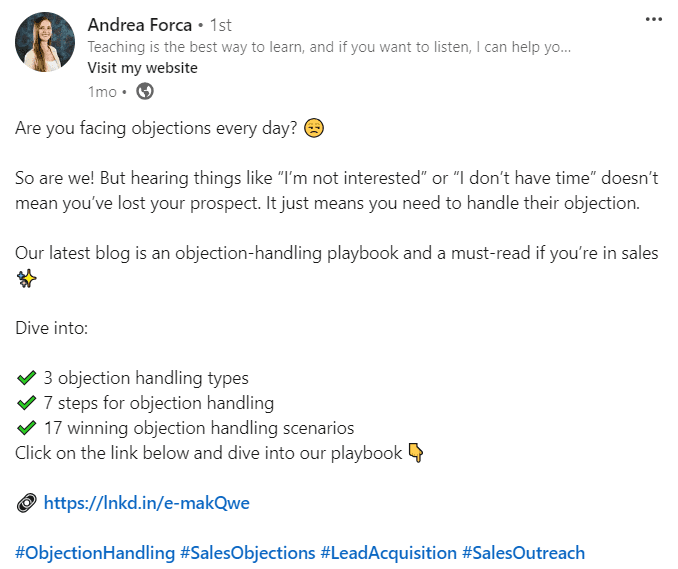
Of course, content distribution is all about timing. You can’t post something in the middle of the night and expect it to get the attention it deserves. So, take it from us and post when your audience is the most active for maximum engagement. These would be business hours on weekdays, though be wary of your audience’s time zone. From our experience, we can tell you that 4 PM is the best time to post.
Generate leads
People typically think lead generation is the responsibility of a sales team rather than marketing, but it’s really a joint effort. That’s why the great news for marketing experts is that LinkedIn is the #1 platform for B2B lead generation. It’s also where most of your B2B leads should come from!
The combination of personalized cold outreach and targeted ads work best for LinkedIn lead generation.
Speaking of LinkedIn outreach, our head of sales, Andrea, begins the process with a perfectly crafted LinkedIn connection message that increases the likelihood of acceptance and subsequent engagement.
As for running targeted ads on LinkedIn for B2B marketing purposes, you can use:
- Sponsored content to promote valuable resources to a broader and more targeted audience on their feed.
- LinkedIn’s native lead generation forms to collect qualified leads easily.
- Text and dynamic ads to target specific audiences based on job titles, industries, company sizes, etc. Dynamic ads also personalize the ad experience by including the viewer’s name or other profile information.
Find new backlinking partners
Let’s say you wanted to diversify your backlink portfolio to improve your website’s authority on search engines and drive more organic traffic. Where would you find the partners to exchange links with?
That’s right; on LinkedIn!
As for us, the process of finding new backlinking partners goes a little bit like this:
- We do the research to identify potential partners whose backlinks could add significant value to our site. LinkedIn search filters are of immense help here. However, we find that Sales Navigator search filters - since there are more of them - help us pinpoint potential partners better.
- Then, we do the outreach. If we don’t get a response after the first try, we don’t give up. Instead, we make it a habit to write a follow up email after no response.
- After landing a backlinking deal, we don’t let our partners go to waste. Rather, we work on maintaining a positive relationship with them for a lasting, mutually beneficial partnership.
Use LinkedIn for B2B marketing to help your Product Hunt launch
If you’re a SaaS startup or a tech company, launching on Product Hunt can be transformative. This platform boasts excellent exposure and hosts daily competitions where companies showcase their products or new features.
We successfully launched Skylead 3.0 on Product Hunt in October 2023 after a major redesign and introduction of the unlimited email accounts feature. Preparations lasted for 3 months, during which we worked hard on product and marketing copy, visuals, and video material.

Why discuss Product Hunt in the context of LinkedIn for B2B marketing, though? Because promoting your launch on LinkedIn can improve your chances of ranking high. As a result, you can get more clients and partnerships like we did.
We started by scheduling the launch early.
After scheduling it, we used LinkedIn for outreach and post-sharing to encourage clicks on the "Notify" button.
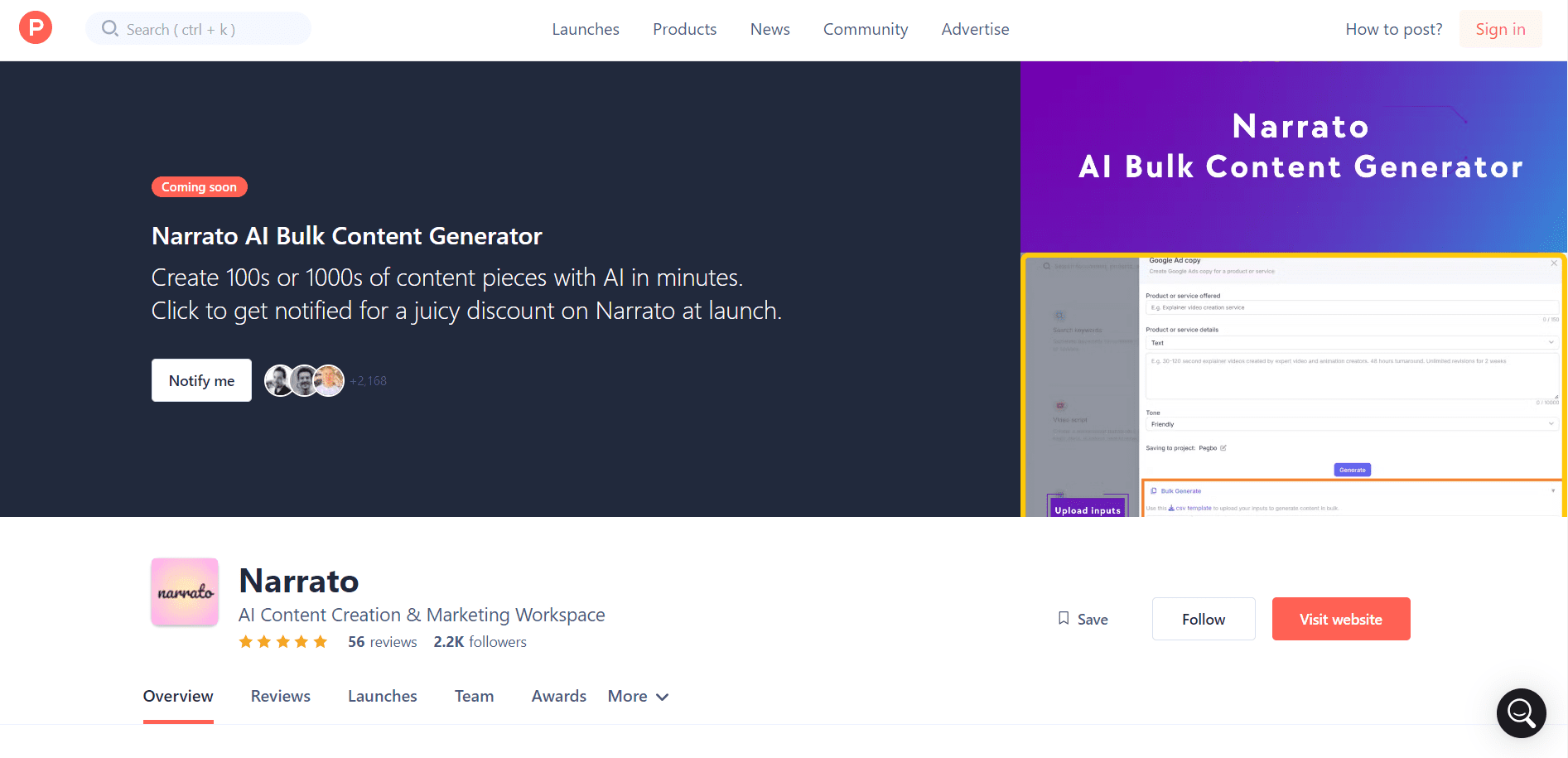
Leading up to the launch, we posted teasers on LinkedIn, including behind-the-scenes content, sneak peeks, milestones, and countdown posts.
We also used Facebook, Slack, and LinkedIn groups for Product Hunt promotion and actively engaged in the Product Hunt community.
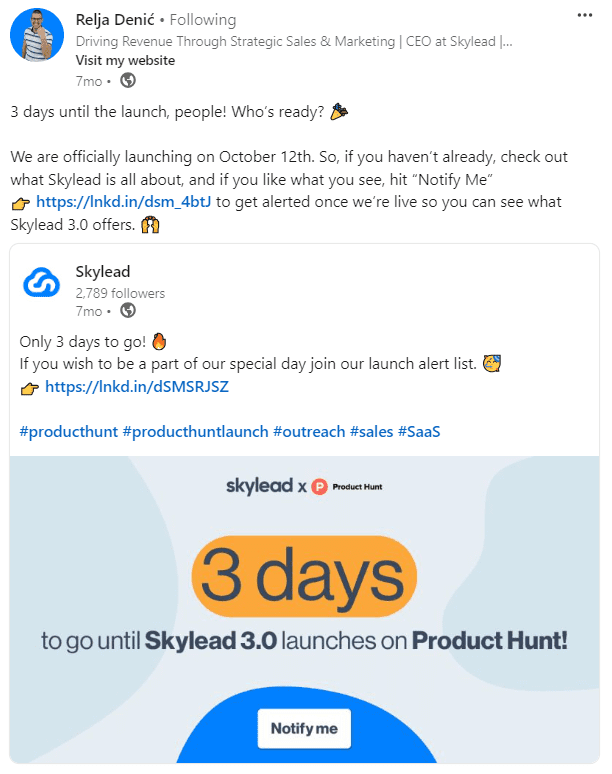
On launch day, we set up outreach campaigns yet again to remind people to vote. We also responded to every comment on Product Hunt!
This is just a speed run and a fraction of what we did, but as you can see, most of our Product Hunt launch marketing revolved around LinkedIn. And yes, we spent months preparing. But it’s that time and effort that got us 2nd place!
That same time and effort can bring you results if you ever decide to use LinkedIn to promote your Product Hunt launch.
Promote your community
You may not have a product launch to promote, but a community.
For instance, we use LinkedIn to reach out to different individuals and inviting them to join our Facebook community.
Of course, you may have a community on another channel to promote (e.g., a Slack group, subreddit, etc.). Regardless, you can use LinkedIn to promote it.
11 strategies to leverage LinkedIn for B2B marketing
As you can see, there are plenty of situations that warrant using LinkedIn for B2B marketing.
That said, let’s put the wheels into motion and teach you how to leverage the platform’s B2B marketing potential.
Define your objectives for effective B2B marketing on LinkedIn
You can’t go into B2B marketing on LinkedIn without having a clear goal in mind.
But before defining objectives, you need to think about what you wish to use LinkedIn for. Is it for content distribution? To generate leads? Or both?
Your ultimate goals will vary depending on the use case. However, some of the common ones include:
- Driving more traffic to your website
- Boosting conversion rates
- Enhancing brand awareness
You don’t have to limit yourself to one goal only. In fact, it’s preferable to have a few well-defined objectives that align with your overall marketing strategy.
Identify your ICP and buyer persona
For your marketing efforts to come to fruition, you need to know that the people you are targeting are the ones who will respond to your messaging.
So, after figuring out your goals, it’s time to understand who your Ideal Customer Profile (ICP) and Buyer Persona are.
ICP is a fictional representation of the company that would get the most value from your product/service and provide the most value to your business in return. Meanwhile, a buyer persona is an ideal decision-making individual in that same company.
If you don’t have clients, users, or customers, consider factors such as your target audience’s demographics, locations, job titles, industries, and company sizes when creating your ICP and buyer personas.
However, if you already have them, identify and analyze the best ones.
Create a striking company page
Your LinkedIn company page is your brand’s face on the platform.
That said, you need to make sure it’s compelling and informative.
Use a high-quality logo, a striking cover image, and a clear description of your business. Don’t forget to highlight your products/services and any unique selling propositions you have!
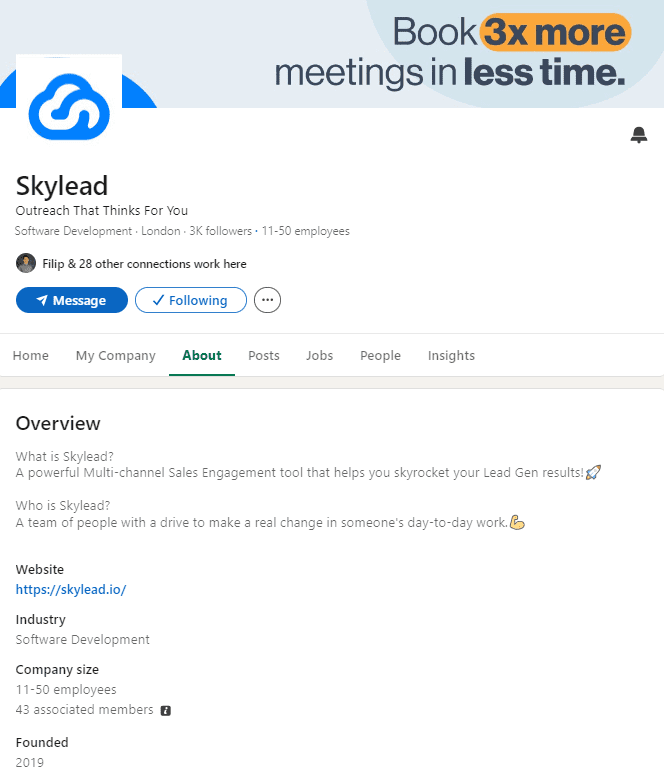
Once you’ve set it up, use your company page on LinkedIn for B2B marketing by sharing relevant content that your audience finds valuable.
Complete your LinkedIn profile with B2B marketing in mind
Your personal LinkedIn profile is as important as your company page, especially if you are in a decision-making role.
With that in mind, pay special attention to your LinkedIn headline. Why? Because it’s among the first things your profile visitors will notice — along with your LinkedIn cover photo and profile image.
You’ll want to optimize it with relevant keywords to increase visibility on LinkedIn search. The same goes for your LinkedIn URL.
Your LinkedIn summary section is also important. But bear in mind that without clicking ‘’...see more,’’ your visitors can see only around 300 characters of your summary. For that reason, you need to find a way to hook readers right from the start!
Include keywords here, as well, to make sure those who rely on Boolean search can stumble across your profile.
Create engaging content
Let’s say you managed to draw in a substantial audience using the strategies outlined above. However, now comes the real challenge: keeping them engaged over time.
Luckily, since the content is king on LinkedIn, it’s also your gateway to retaining the audience.
That said, it’s your job to share content that’s both interesting and informative.
Think of it this way: the better the quality of your content, the more success you will find with B2B marketing on LinkedIn.
To enhance it further, include relevant hashtags whenever possible. Our experience tells us that it’s best to keep hashtags to a maximum of 5, though.
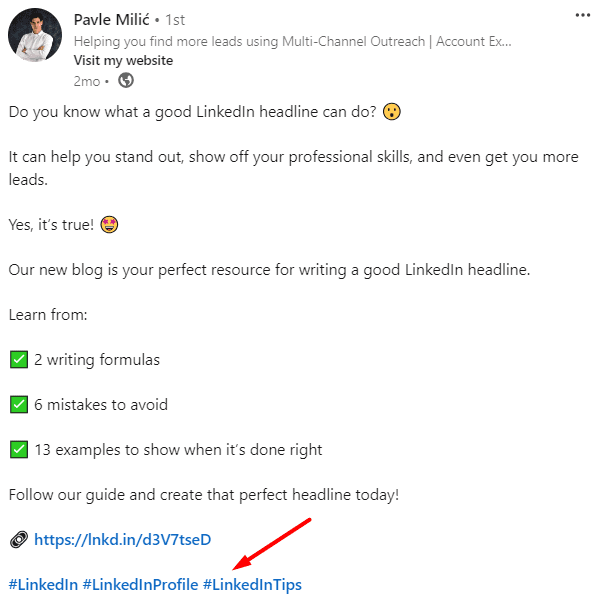
Adjust your tone of voice when using LinkedIn for B2B marketing
Your tone of voice on LinkedIn should be professional yet personable.
In fact, it’s that genuine and relatable communication that helps build trust with your network.
So, avoid overly formal language by all means and strive to be authentic and engaging.
Experiment with formats
People get tired of the same-old same-old type of content fast. That’s why you should diversify it.
Don’t be afraid to experiment with different formats, such as regular posts, images, videos, and native articles.
Variety keeps your audience asking for more and pleases those with different preferences for content consumption.
Create a posting schedule
You can’t expect to make a splash on LinkedIn with your B2B marketing efforts if you commit to posting every couple of months. Consistency matters a lot!
So, develop a posting schedule and stick to it. Regular posting keeps your brand top of mind and helps maintain engagement.
As for how often you should post, aim for at least 3-4 posts per week. To make scheduling easier for you, you can use LinkedIn’s scheduling feature to schedule all posts for that week.
Also, the time you post is as important as the frequency of posting. With that in mind, avoid doing it on weekends and during off hours, as most professionals aren’t browsing LinkedIn when away from work. Furthermore, adjust your posting schedule so it fits the time zone of your target audience.
Run retargeting ads
Those who have already visited your website are familiar with your brand. Chances are, they are more likely to convert and are, therefore, a perfect audience to target.
The question is, how?
Through LinkedIn retargeting ads.
However, before you create any ads, install LinkedIn Insight Tag on your website. The tag collects information about your website visitors that you can use to retarget these individuals through ads on LinkedIn.
But don’t run your ads as soon as you have added the tag to your website! Instead, we suggest waiting at least 2 to 4 weeks for it to collect sufficient information.
Retarget website visitors with LinkedIn Insight Tag
Wondering how to create an ad campaign on LinkedIn to re-engage past website visitors using LinkedIn Insight Tag?
Firstly, locate the ‘’For Business’’ menu in LinkedIn’s header section and click the ''Advertise'' button down below.

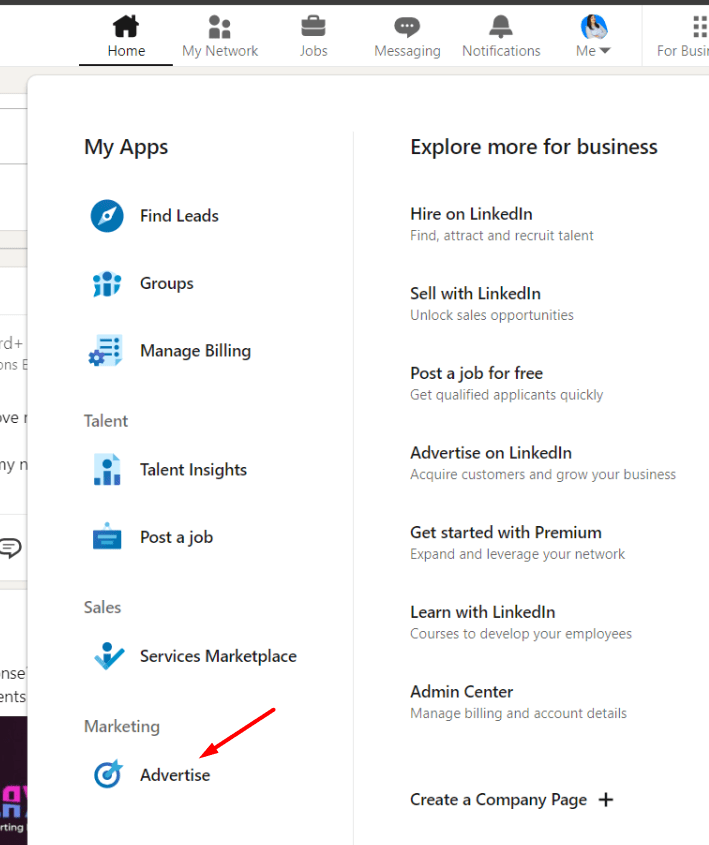
You’ll be taken to the Campaign Manager page, where you can create an account if you don’t have one.
Once you are in the campaign dashboard, however, hit ‘’Create’’ and select ‘’Campaign’’.
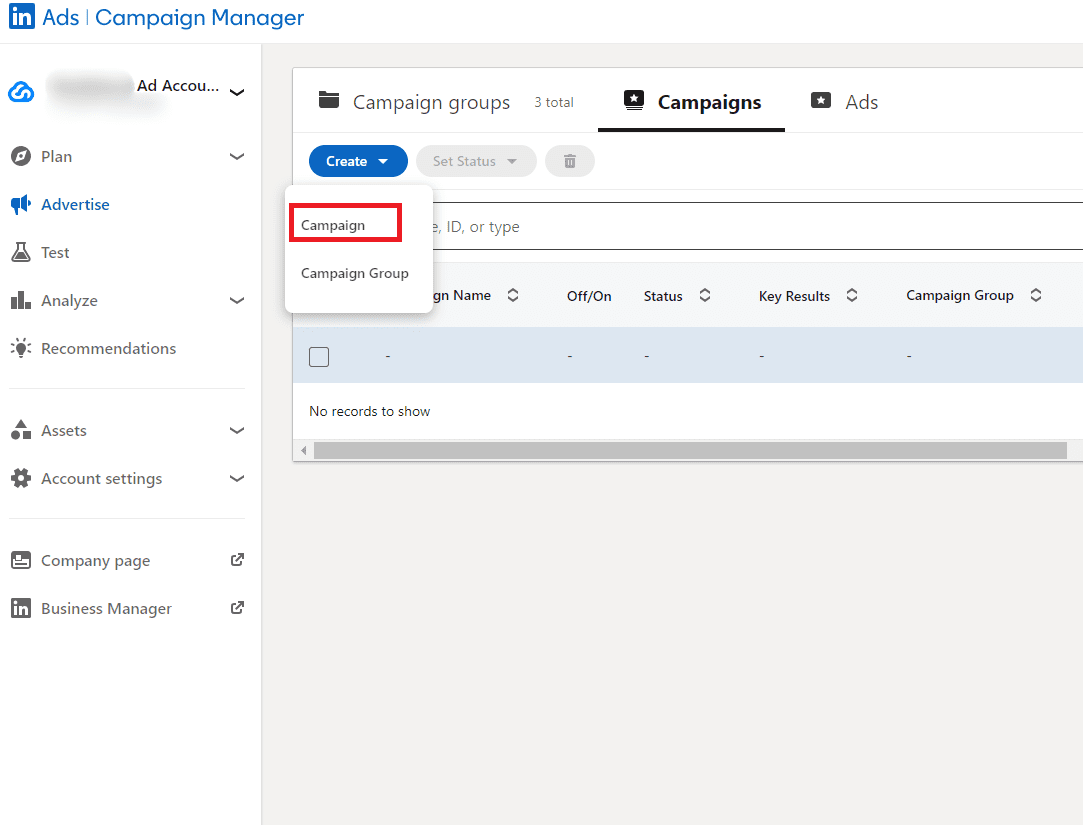
#1 Choose your campaign objective
To continue creating your ad, you need to insert the name for your campaign and choose your campaign objective.
As you can see, there are several objectives divided into 3 campaign categories:
- Awareness
- Consideration
- Conversions
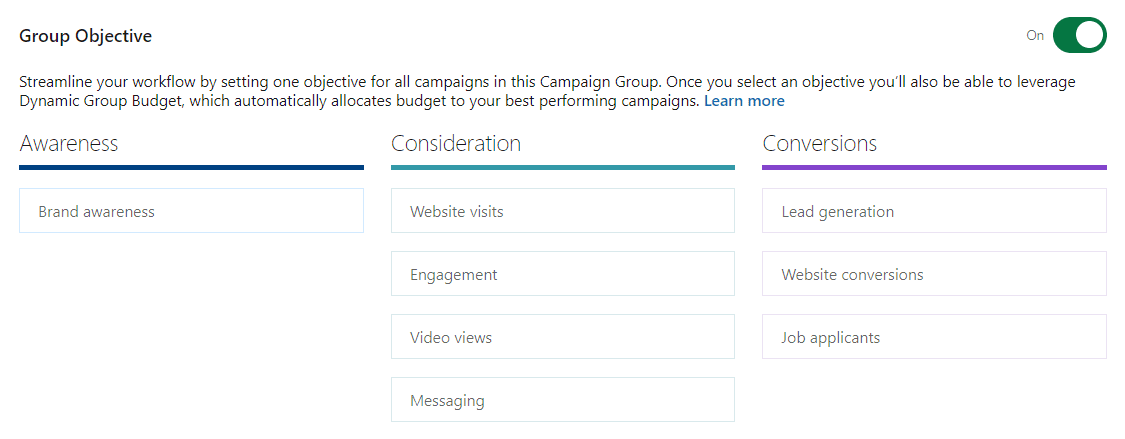
Here’s how to use each campaign type:
- Lead generation to get leads’ information. From our experience, the cost per lead is greater on LinkedIn than on any other platform.
- Engagement to increase interactions with your ad or get more Company Page followers.
- Increase video views.
- Messaging to start chatting with your leads.
- Website conversions to drive leads to perform a meaningful action on your website.
All these campaign types let you retarget your website visitors.
Nevertheless, for example purposes only, let’s assume you had a resource on your website you wanted them to revisit it for.
In this case, you’ll want to choose ‘’Website visits’’ as your objective.
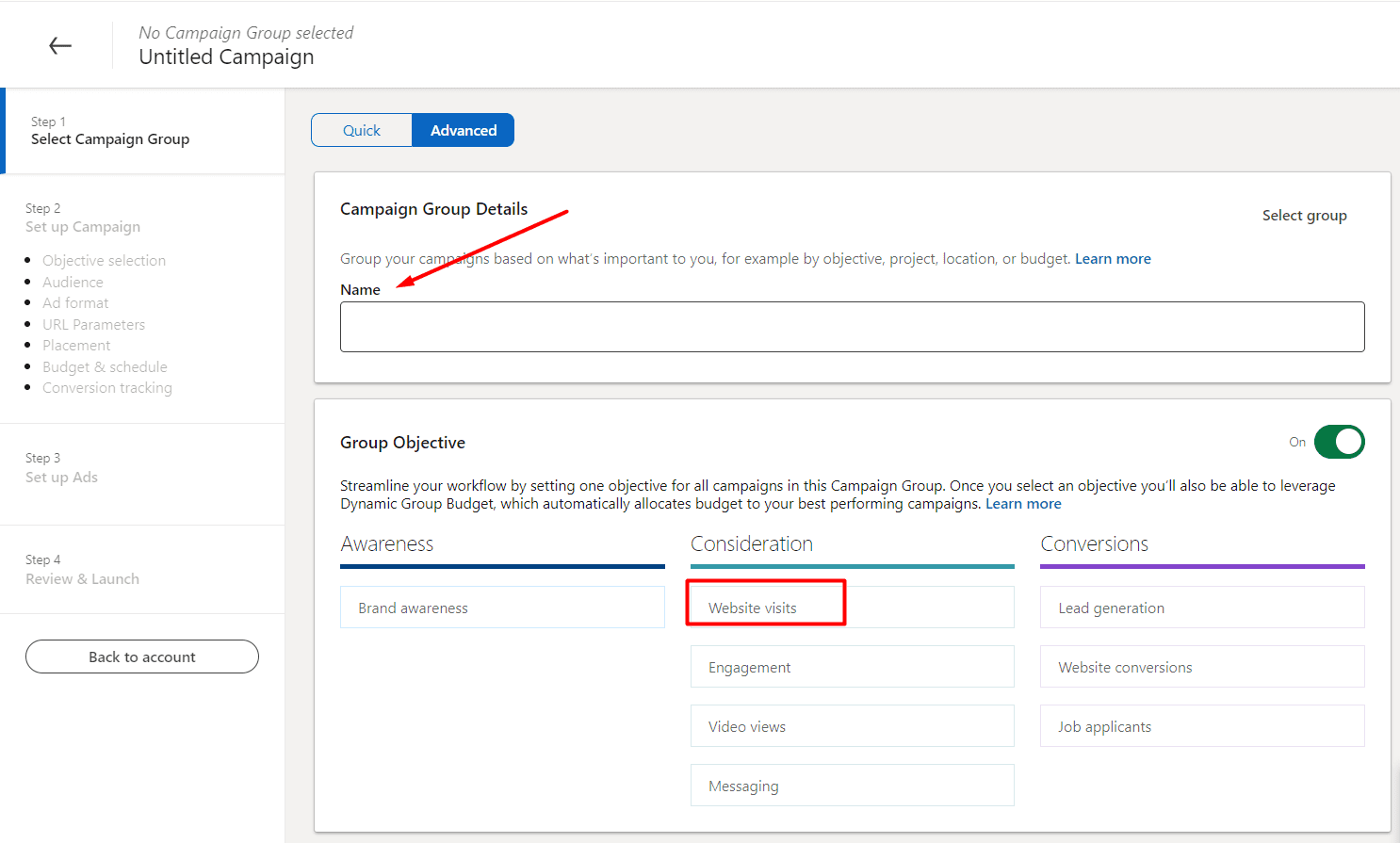
#2 Set up a budget and schedule for your campaign
If you are working with limited resources, you may want to set up a daily budget for your campaign. So, turn this option on or keep it off, depending on your preferences.
Also, don’t forget to set up your campaign schedule. Your campaign can be open-ended or have a clear start and end date.
Once you’ve decided on the optimal running time, click ‘’next’’.
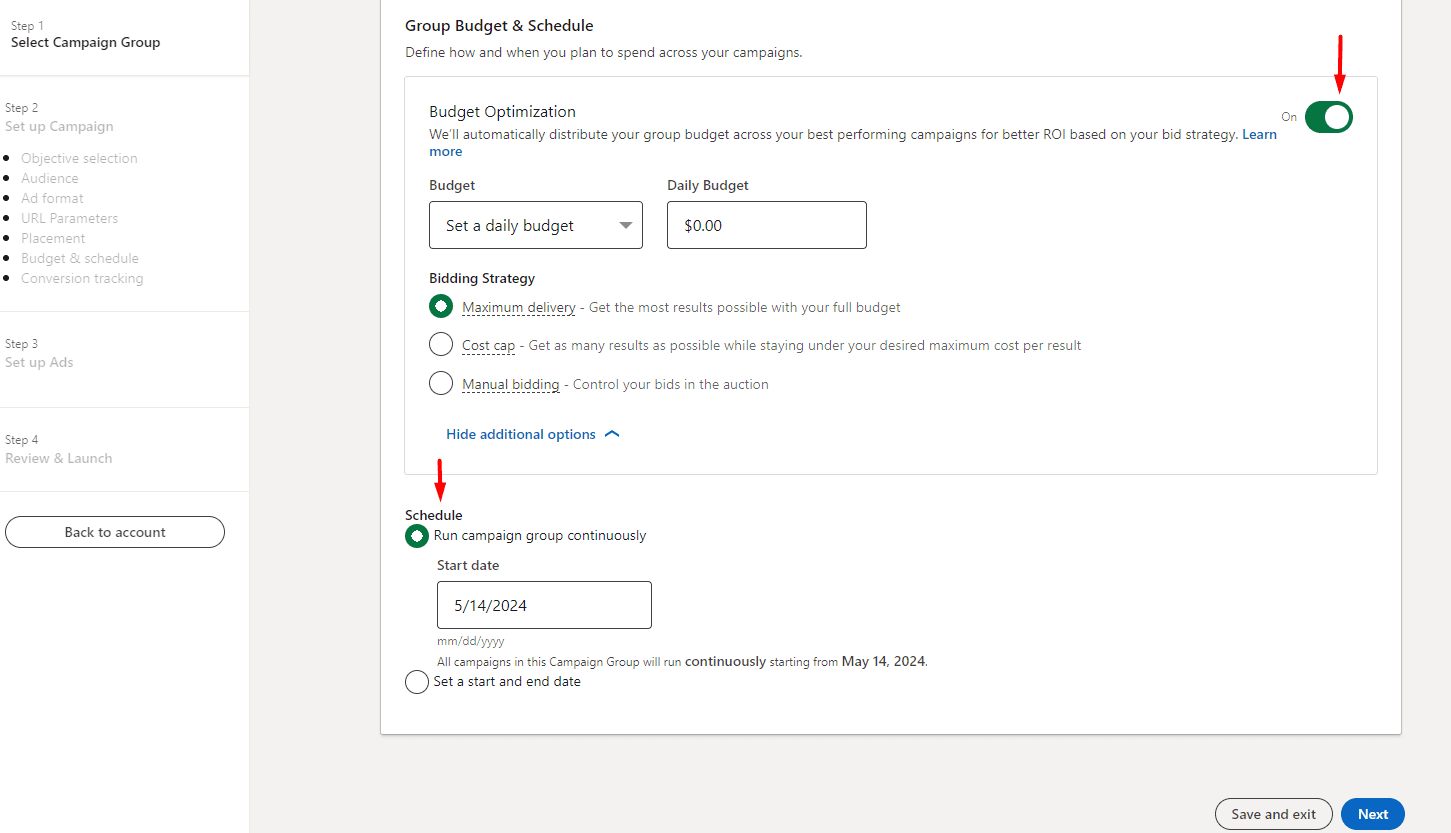
#3 Determine your audience
Now comes the time to configure your audience. Choose the ‘’Retargeting’’ option.
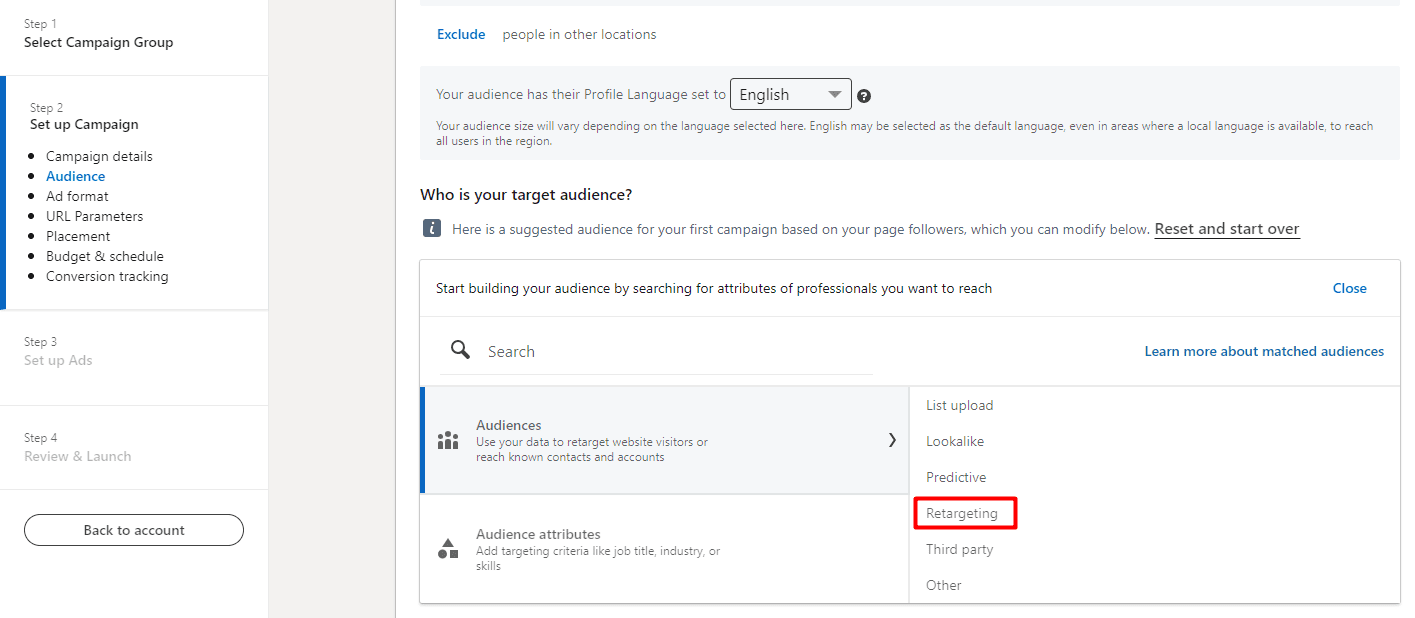
Next, choose ‘’Website’’ and select the audience of your website visitors that you already created.
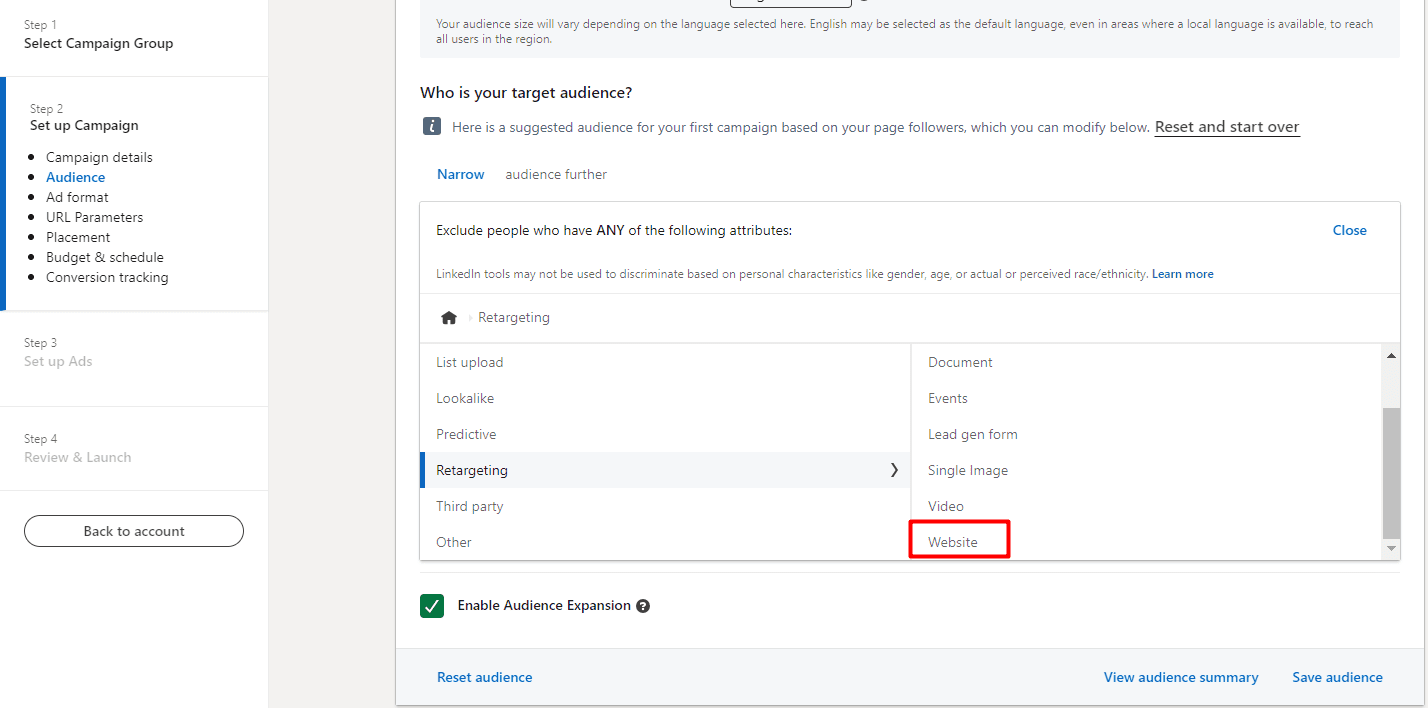
#4 Select the ad format and create your ad
After you define your audience, it’s time to create your ad. That said, select the ad format from the following options.
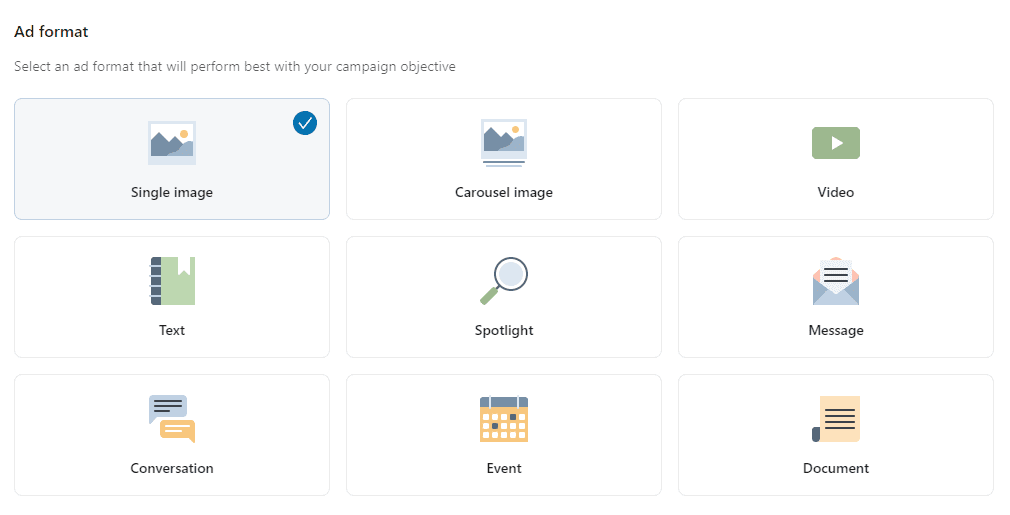
…and placements.

Depending on your goal, you can also set up URL tracking parameters and conversion tracking.
What we can tell you from experience, though, is that it's better to set them up. In doing so, you'll be able to track the results of your campaigns with the end goal.
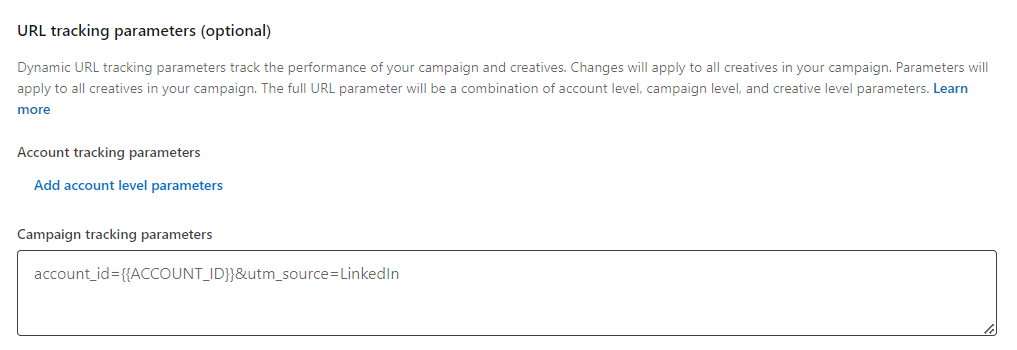

And now comes the fun part: ad creation.
To create one, click ‘’Create new ad’’.
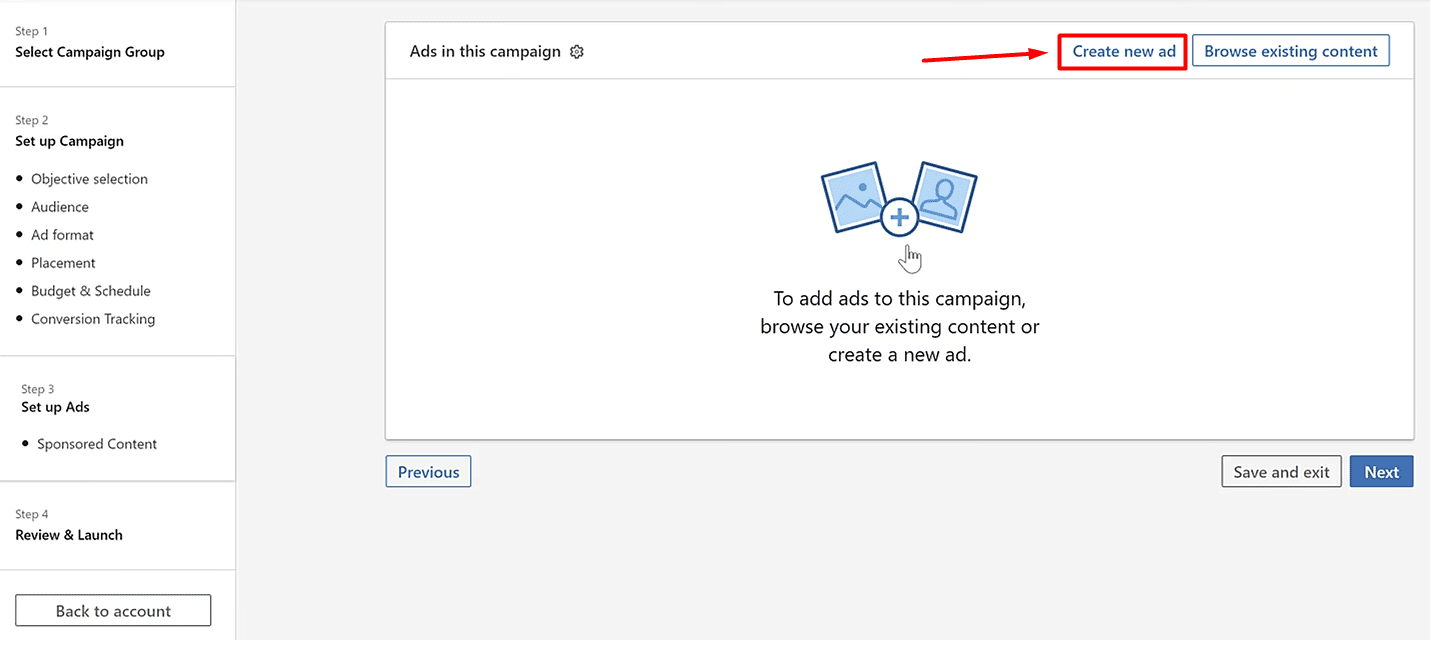
You’ll be taken to an ad builder page where you can input your message, website URL, visuals, etc. Just bear in mind that the interface (and options) will differ depending on the ad format you have chosen.
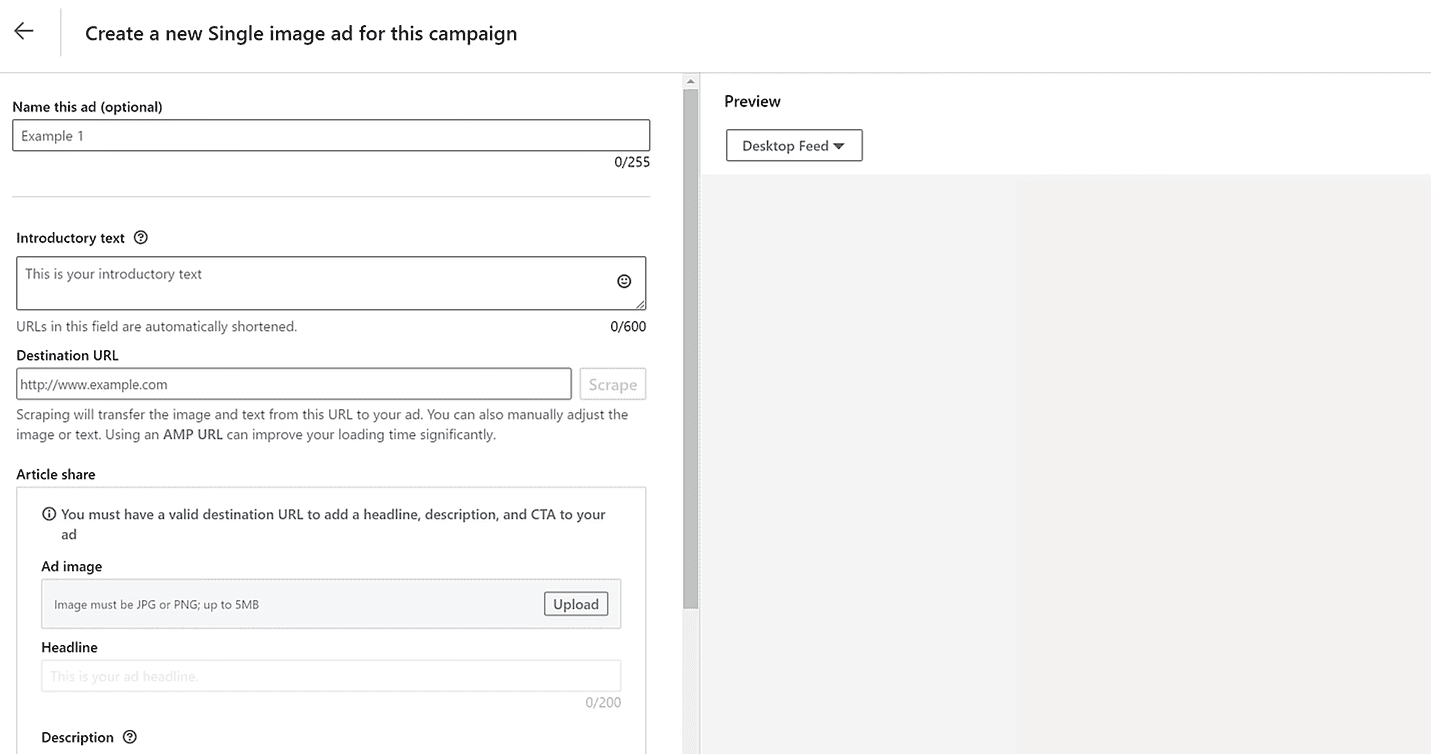
Build retargeting ads with emails
Did you know there was another way to expand your reach and get to people who are highly likely to convert? You just need to create a Predictive audience from the emails of people who have interacted with your brand.
The Predictive audience is somewhat of a hybrid between LinkedIn’s no longer-existing Lookalike audience and conversion-based retargeting.
It’s also the best type of audience in B2B marketing for reaching new, similar leads on LinkedIn and making your campaign worthwhile.
Skylead’s email discovery & verification can help you find the emails of your best leads, which you can use to create a Predictive audience!
1. Create your Predictive audience
Go to LinkedIn’s Campaign Manager. This is where you’ll want to create your audience first.
To do so, click ‘’Plan’’, and then ‘’Audiences’’ in the sidebar menu on the left.
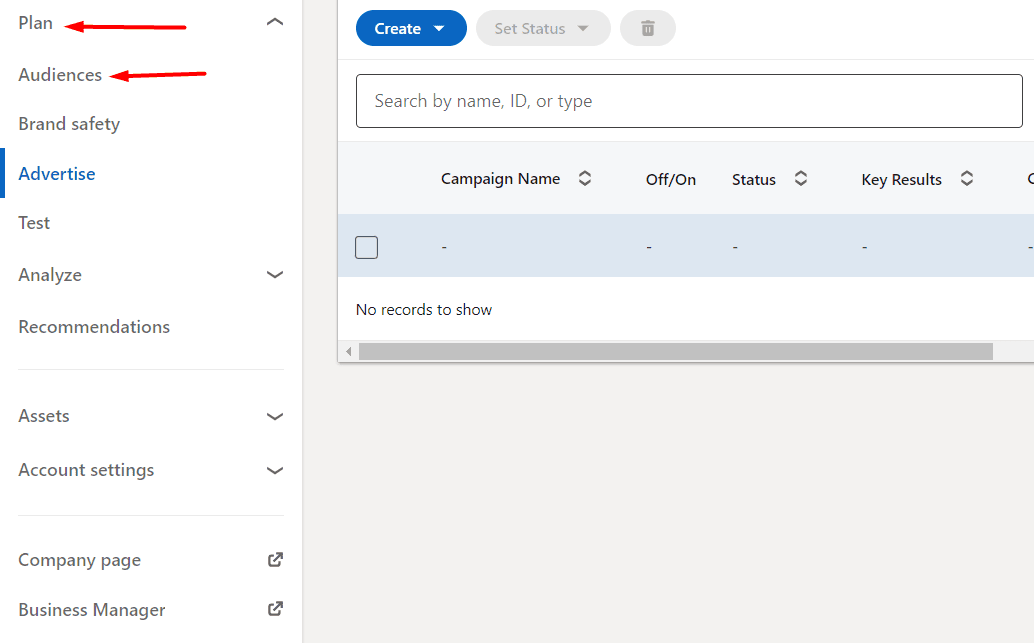
Once you're on the Audiences page, hit the ''Create audience'' button and choose ''Predictive''.
A new menu will pop up, and you'll need to name your audience.
After doing so, open the drop-down menu to select the source from which you’d like to create your audience.
Choose "Contact list'' and upload your list.
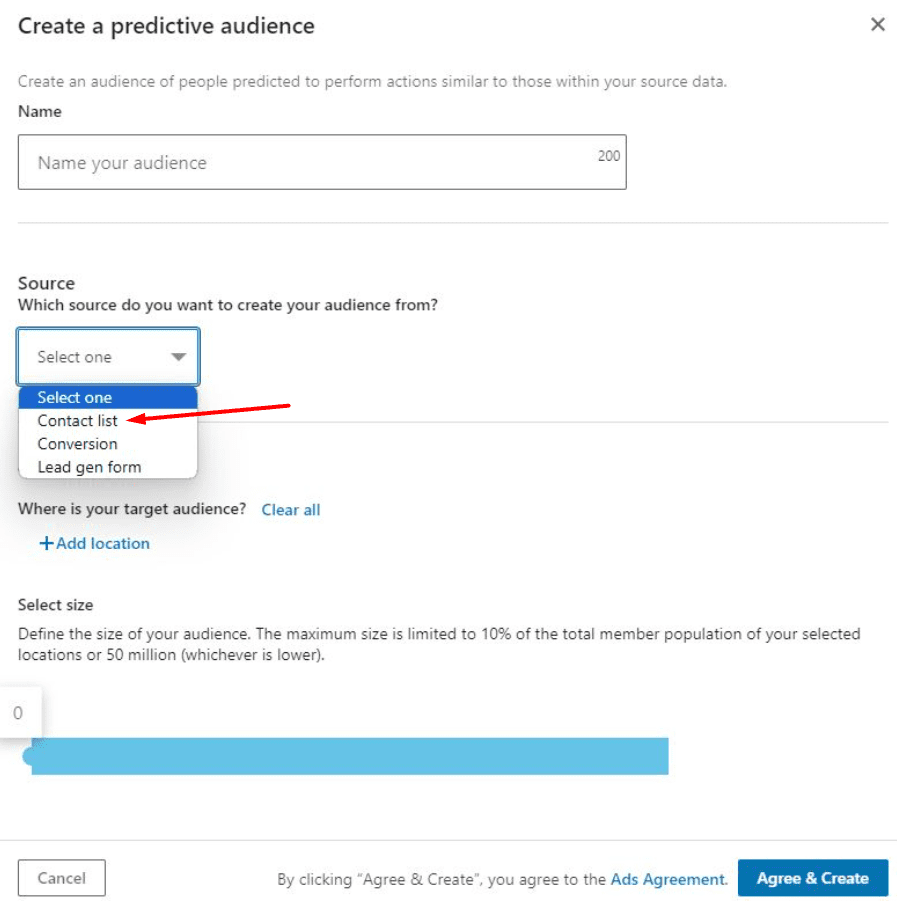
After that, choose the location of your target audience and use the slider to select its size.
Finally, click ''Agree & Create.''
📝 Note: Your list must have a minimum of 300 members and a maximum of 300,000. Otherwise, you can’t create a Predictive audience. Also, before hitting launch on your campaign, it’s best to let your audience populate.
2. Create your ad campaign
Once your audience is created, go back to the Campaign Manager dashboard to create your campaign.
Name it, choose the objective, and set up your budget and schedule just as you would with any other campaign.
However, when the time comes to define your audience, instead of the ‘’Retargeting’’ option, choose ‘’Predictive.’’ Then, select the audience you’ve previously created.
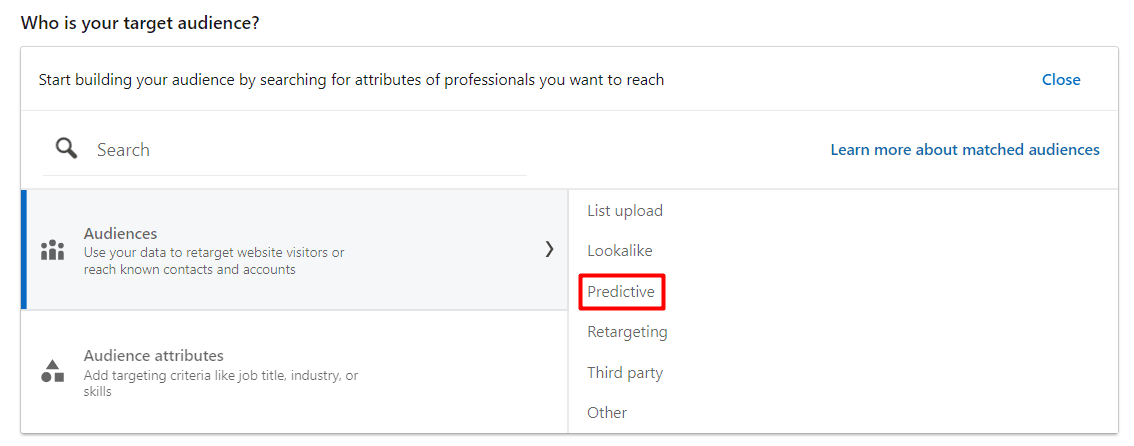
The rest of the campaign creation process follows the same steps we covered for retargeting website visitors with the LinkedIn Insight Tag.
So, go through them, work on your ad, and when you’re happy with everything, launch your campaign!
Personalize your outreach
Nobody likes receiving a generic message. So, if you want to leverage LinkedIn for B2B marketing in its full capacity, personalize your outreach.
Refer to your prospect by their name, mention a detail from their profile, a mutual connection, or anything else you like to make the conversation more engaging.
Frequently asked questions (FAQs)
1. How many B2B marketers use LinkedIn for B2B marketing?
A significant majority of B2B marketers use LinkedIn for their marketing efforts. Specifically, 96% of B2B marketers use it for content marketing, making it the leading platform for B2B content distribution. Additionally, LinkedIn is exceptionally effective in generating leads, with 89% of B2B marketers relying on it for this purpose.
2. How do you measure the success of LinkedIn B2B marketing campaigns?
To measure the success of LinkedIn B2B marketing campaigns, track metrics like engagement rates, conversion rates, and website traffic from LinkedIn. Use LinkedIn Analytics and Google Analytics to monitor these KPIs and adjust strategies accordingly.
3. How can small businesses with limited resources effectively leverage LinkedIn for B2B marketing?
Small businesses can leverage LinkedIn for B2B marketing by focusing on organic growth strategies, such as networking and sharing valuable content. They can also utilize free LinkedIn features and gradually invest in LinkedIn ads and outreach.
Don’t miss out on LinkedIn’s B2B marketing potential!
Congratulations! You've made it thus far!
And since you have, you are aware that LinkedIn provides an unmatched opportunity to connect with the decision-makers who can drive your business forward. You've also learned the strategies that can help you fully utilize LinkedIn for B2B marketing.
But theory alone won't drive results; it's the execution that makes all the difference. So, feel free to apply the learned to enhance your brand's visibility, form strategic partnerships, and ultimately scale your business.
If you want to level up your outreach, try Skylead. Sign up for your 7-day free trial as soon as today.
Disclaimer: Skylead is not affiliated, endorsed by, or connected with LinkedIn in any way.
Are you thinking of launching your first outreach campaign to reach out to your leads, book meetings, distribute content, or find new clients, ideal candidates, and backlinking partners?
We’ve got your back!
In this blog, we’ll take you through some crucial steps to prepare you for creating a solid outreach campaign.
We’ll even throw in some tips and tricks on achieving outreach success and cover use cases and outreach messages for every profession.
Let’s dive into it.
What is an outreach campaign?
An outreach campaign is a structured effort to connect with potential or existing clients across different channels. It can serve many goals — from generating new leads and nurturing relationships to increasing brand visibility or promoting content.
In the past, these campaigns were carried out manually, but today, specialized solutions for sales engagement, like Skylead, exist to make it easier to scale your efforts, helping you send and track personalized emails at volume while saving valuable time.
The benefits of setting up an outreach campaign
Outreach tools have revolutionized the workflow of countless people! Here’s why!
Firstly, there’s the time-saving aspect. Outreach campaigns can be real game-changers, saving you as much as 11+ hours per week . That’s an extra 6 days each month to focus on other tasks!
With these tools, you can even reach people you thought were unreachable before, as email enrichment features like Skylead’s email discovery & verification can be included in the campaign flow.
Yes, as your business grows, so will your outreach. But that’s not a reason to worry! You can launch multiple campaigns at the same time and scale without compromising quality.
Finally, outreach campaigns ensure no lead falls through the cracks. The system keeps things moving through personalized emails and consistent follow-ups.
Outreach campaign use cases
Salespeople
Sales professionals are often seen juggling multiple leads at a time. With so many leads to manage, little time is left for other tasks, plus the risk of missing important messages increases. Outreach campaigns streamline the process and ensure consistent communication across multiple channels.
Sales reps can continuously create campaigns with thousands of leads to keep their calendars consistently full.
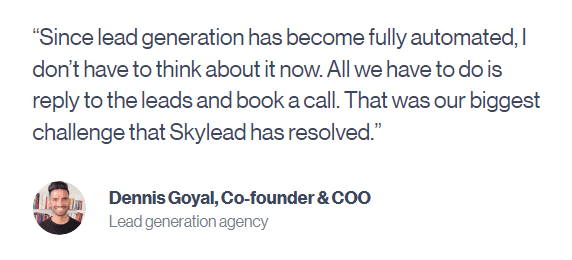
Why does this matter, though?
Because automating outreach tasks such as sending emails helps sales professionals save +11 hours a week—hours they can now focus on lead nurturing.
Lastly, outreach campaigns permit salespeople to A/B test their messages. This allows them to see what works and what doesn’t, which in turn helps them optimize their campaigns for better results.
Marketers
When it comes to marketers, they can use outreach campaigns to:
- Generate leads for their sales teams;
- Find backlinking partners faster;
- Distribute content and reach wider audiences;
- Increase conversion — Marketers can leverage Skylead’s email discovery and verification feature to find their leads' email addresses. Once the tool finds and verifies emails, they can use them to create a lookalike audience on LinkedIn, Google Ads, and/or Facebook, which will result in better targeting and increased conversions;
- Expand their network and become thought leaders.
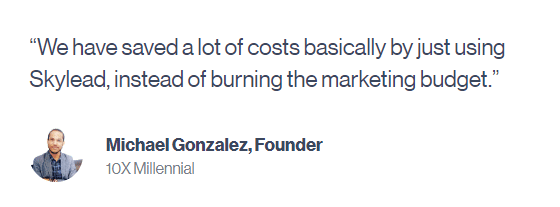
Recruiters
Manual cold outreach can be time-consuming for recruiters who are constantly scouting for the best talent. Thankfully, outreach campaigns simplify candidate engagement.
That said, recruiters can set up campaigns to:
- Generate a large pool of candidates and pick the best from the crowd;
- Speed up the hiring process;
- Target individuals attending specific job fairs;
- Personalize outreach to keep candidates’ interest high.

Company founders and agency owners
Company founders and agency owners typically have a full plate of managing daily operations, strategizing business development, ensuring financial health, and more. Outreach campaigns lighten the load and accelerate revenue growth.
If you are a company founder and have a B2B product or service to sell, outreach campaigns can help you reach out to a wider pool of leads and find clients faster on autopilot.
Meanwhile, if you are offering lead generation services as an agency, you can often white-label the tool used for campaign creation and thus help yourself to another stream of income. Moreover, outreach campaigns can also help you generate new leads for yourself and your clients!
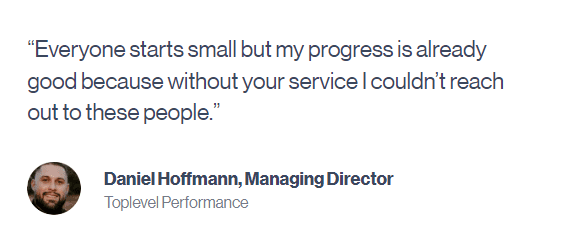
How to conduct an outreach campaign: Step-by-step guide
Now that we’ve covered the basics, it’s time to launch your first campaign! We’ll use our own tool, Skylead, to show you how you can use outreach tools to create one.
When you find your leads that match your target, you can import them through:
- API,
- And a CSV file.
This is where Skylead's email finder & verifier comes in, as it helps you find your leads' emails. That said, here’s how to start creating your outreach campaign.
#1 Target your audience
This is where defining your Ideal Customer Profile (ICP) and buyer persona comes in handy.
Your ICP is the type of company that would benefit most from your product/service, and your buyer persona is a fictional representation of your ideal customer within that company, as informed by market research and actual customer data.
That said, define your ICP and buyer persona first and use the platform of choice to source your leads and their emails!
#2 Import your leads
You’ve completed the manual part of prospecting and carefully chosen your audience. They're now in CSV file. What now?
You proceed to build an outreach campaign!
To do so, firstly, go to your Skylead dashboard and locate the Campaigns page.
Once there, click ‘’Create new campaign’’.
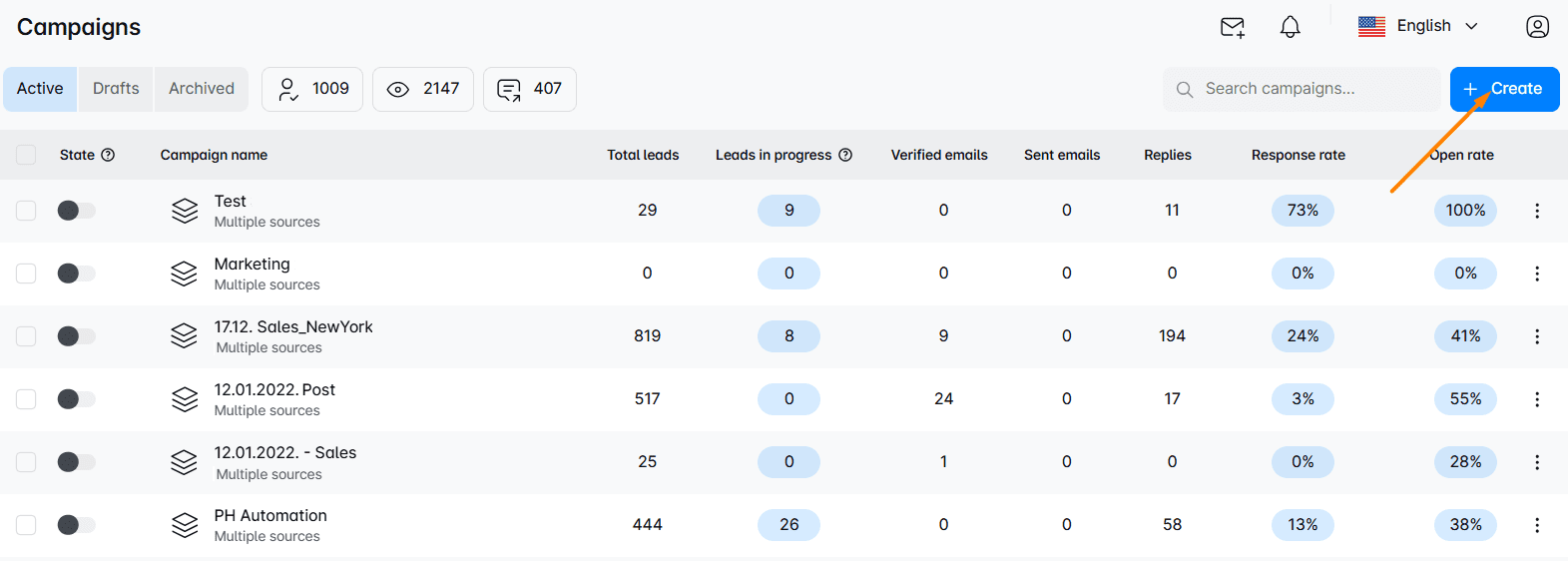
Return to Skylead, insert your campaign name, and import the CSV file you've created.
Now proceed to create your campaign, by creating a Smart sequence - a combination of if-else conditions and outreach actions that help you send part of your messages based on your leads' behavior. Adjust it until it's fine-tuned for your leads and watch how Skylead takes care of some of the workload, while replies come in and you get to manage and maintain relationships.
Tips for a successful outreach campaign
Now that you know all this, you yet have to learn how to make the most of your outreach.
Personalize your messages
People are more likely to respond to personalized outreach messages that feel relevant to them. So, take the time to customize your messages based on the information you have about your leads.
With Skylead, you can reach a whole new level of personalization in cold outreach. Use pre-defined variables, add custom ones if using a CSV file as a lead source, and don’t forget to take advantage of our image & GIF hyper-personalization feature. They can increase your response rate up to 63%!
Feeling uninspired? Head over to our blog to explore personalized image and GIF templates that improve response rate!
Follow up in due time
Don’t be discouraged if you don’t get a response right away. Sometimes, all it takes is a well-timed follow-up message. However, be mindful of the frequency of your follow-ups to avoid coming off as spammy. The golden rule is to wait between 2 and 5 days from the initial message. And if you aren’t sure how to write a follow up email after no response, we have a handy guide to help you out!
Outreach campaign examples and templates for each role
Remember how Skylead came with the premade templates for you to use? Here, we’re sharing some of the best-performing sequence and message templates applicable to each role and different situations.
Sequence for sales professionals
If you want to target someone in an alternative way, why not use a viral LinkedIn post that your target audience has commented on?
In that case, you can use the template below to reach out to leads who have engaged with it.
We tested it out, and our results were:
- 76% acceptance rate
- 35% reply rate
- 85% open rate
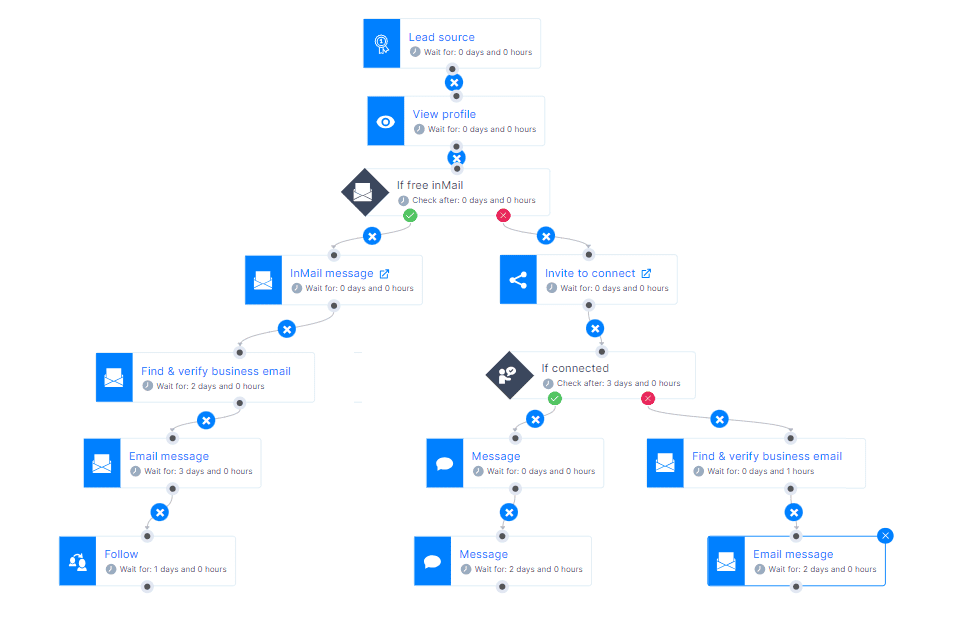
Outreach campaign template for marketers
Feel like targeting your website visitors? You might like this sequence template, which aims to do precisely that!
For this one, we had a whopping:
- 23% reply rate
- 71% open rate
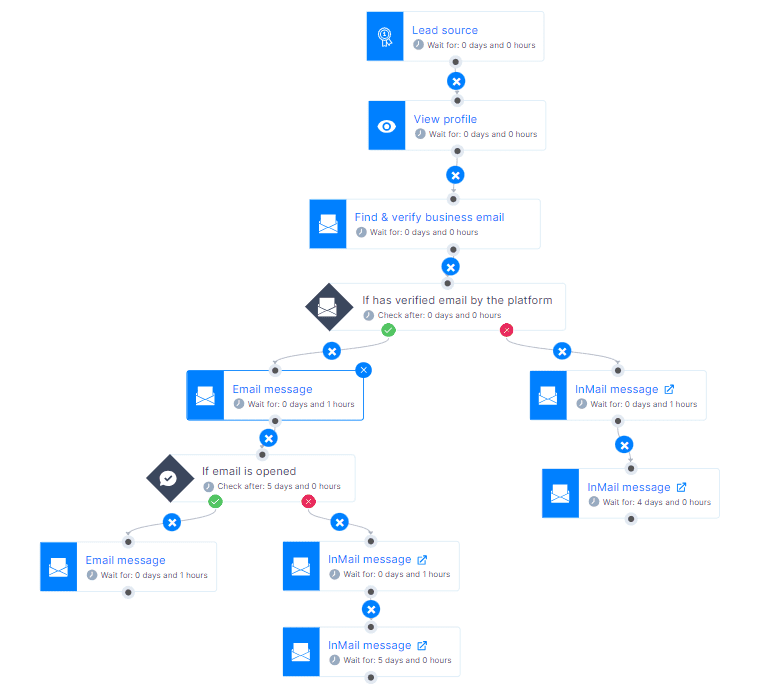
Template for company founders and agency owners
Check out this template specifically designed for reaching out to B2B founders.
We’ve run the numbers and found that, with it, our reply rate 29%, and open rate 82%!
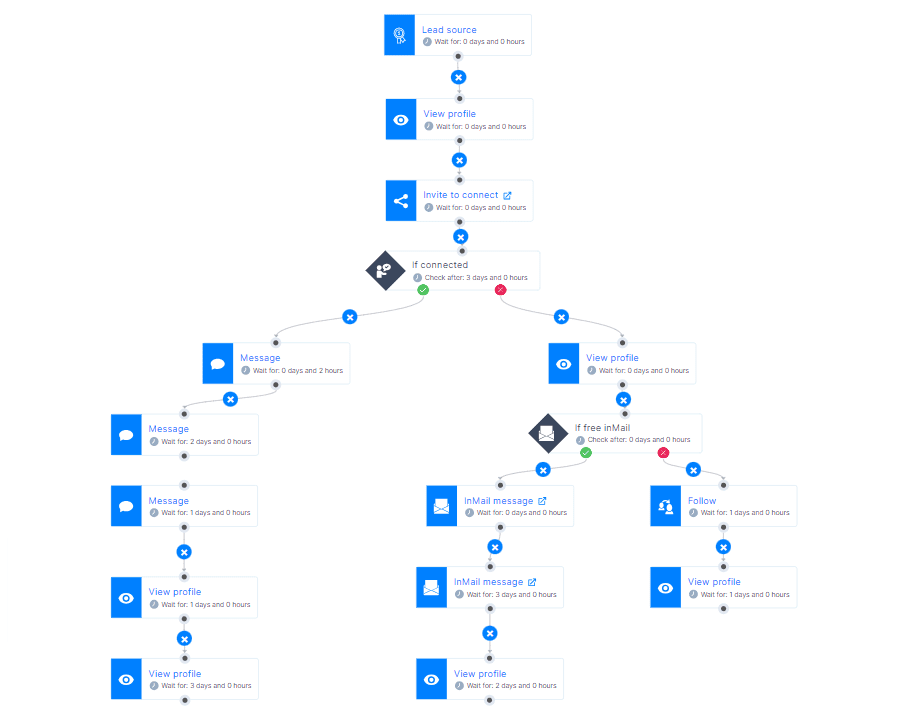
Frequently asked questions (FAQs)
1. What metrics or KPIs are most important to track the success of an outreach campaign?
Key metrics to focus on include response rate, conversion rate, and ROI. These indicators help gauge engagement, effectiveness in converting prospects, and the overall financial efficiency of the campaign.
2. How do you conduct an outreach campaign?
To conduct an outreach campaign, define your target audience and choose the appropriate channels. Create a structured plan, personalize messages, and use tools to help you out. Monitor important metrics to adjust strategies and follow up regularly to maintain engagement and improve response rates.
3. How can you segment the audience for different types of outreach campaigns?
For successful segmentation, you must understand and divide your audience based on factors like industry, job role, company size, and past interactions. This will ensure your messages resonate more effectively with each segment and will reflect positively on response rates and campaign relevance.
Ready to splash into outreach waters?
As our guide comes to an end, it marks the beginning of your cold outreach journey.
All it takes is that first outreach campaign to get you started, and it's just a couple of clicks away.
But remember, cold outreach isn't a one-and-done type of process. In other words, you can't just build your campaign, launch it, and be done with it. It's what comes after launch that actually matters.
So, in the aftermath of creating an outreach campaign, pay a close eye on the results it brings. But don't get discouraged if everything doesn't go as planned! Instead, observe the data, learn from it, and use it to improve your subsequent outreach efforts.
And you know what the best thing is? Skylead comes with a free 7-day trial period that you can use to test out the outreach waters. Create your account now, build that sequence, and watch as your outreach — and conversions — skyrocket!
Disclaimer: Skylead is not affiliated, endorsed by, or connected with LinkedIn in any way.
LinkedIn is a social media for professionals, and it’s classified as the number #1 choice for lead generation. This is because it now counts more than 900 million LinkedIn users. Moreover, according to the official LinkedIn stats, 4 out of 5 drive some business decisions. So no wonder that marketing, recruiting and sales teams make LinkedIn outreach part of their daily work routine.
LinkedIn outreach is a vast topic, and there are many misconceptions and good tips on how to do it. That is why we decided to create a detailed LinkedIn outreach guide that uncovers the following:
- Benefits of LinkedIn outreach;
- What medium is better to use for the outreach - LinkedIn or email;
- Strategies, rules, and methods that work best and those that do not;
- How to use LinkedIn for outreach in 4 easy steps and build positive relationships;
- Some of the best outreach message templates you can use;
- Answers to most burning questions about LinkedIn outreach.

What is LinkedIn outreach?
LinkedIn outreach is a process of sending connection requests and messages to your potential clients via LinkedIn. It’s the best way to expand your network, get in touch, warm up, and build positive relationships with your leads.
The 5 main benefits of Linkedin outreach
It’s not just about the ability to send LinkedIn connection requests, InMails, or other LinkedIn messages, but what you will accomplish with them. Here are the benefits you can expect if you use LinkedIn and every aspect of it in the outreach process.
1. Reach high-quality B2B leads with ease.
LinkedIn has over 900 million professionals from every industry in the world. So it's no wonder this audience has twice the buying power of the average web audience (LinkedIn). Therefore, sales teams can rest assured that with the right filters and top LinkedIn lead generation strategies, they can find the most qualified business-to-business leads for their business.
2. Increased reply rate.
LinkedIn is, first and foremost, a social media platform where you can find various information about your leads. That said, the secret to LinkedIn outreach is personalization and genuine conversation. By looking at your lead's profile, you can search for any information to personalize your message. Whatever you find, be it a mutual connection or a post they shared, you can reference that in your outreach message and thus increase your acceptance and reply rate.
3. Target B2B leads with more precision.
Marketers no longer need to struggle to find professionals on Instagram or Facebook. Instead, they can find and reach out to their potential leads easier with targeting and retargeting options via LinkedIn ads. Moreover, they can generate greater awareness for their product or service. LinkedIn marketer can also easily contact their target audience via sponsored InMail ads and experience 2x more conversions.
4. Find ideal employees.
One of the best perks of LinkedIn is that recruiters can publish job posts for free. However, they can also find the best employee for their business by tapping into a larger pool of talent and headhunting the ideal candidates directly.
5. Break the wall and reach out to recruiters.
By using job posting websites, you can’t get a hold of recruiters. However, LinkedIn allows you to find, send a connection request and reach out to the hiring managers in your ideal company. This way, you can explain why you are perfect for the job or get feedback on your application, all of which you cannot do on other platforms.
LinkedIn vs email outreach - Which one is better?
Both LinkedIn and email channels are used extensively for outreach. However, there is a "slight" advantage to LinkedIn.
The thing is, the social media nature of LinkedIn allows more genuine communication between its users. On the other hand, cold email outreach is distant and often perceived as spammy since, among other things, you cannot always see and find out more about the person behind the cold message.
And the end result can be measured shown in numbers.
For example, according to the official LinkedIn learning courses, InMails have an average response rate of 18 to 25%. On the contrary, cold emails have only a 3% average response rate, and this happens for a couple of reasons.
Firstly, LinkedIn outreach is more transparent since potential leads can see your LinkedIn profile, work history, bio, or posts. In other words, what they are all about.
Secondly, LinkedIn sends a couple of alerts and reminders when the prospect receives a message. In addition, if the leads have a LinkedIn app installed, they will also receive a notification on their phone. What's more, if you send a follow-up message, LinkedIn will send the same amount of alerts, making it harder for your prospect to forget to reply or ignore.
Lastly, if you use LinkedIn, you can find your ICP and people who work in it in the blink of an eye. This way, you can easily reach out to your potential customers without navigating multiple platforms.
However, with LinkedIn's power, we must recognize email as the outreach channel simply because some users prefer email communication or are inactive on LinkedIn.
That said, it's best to use both LinkedIn and email outreach for optimal results. So, we will discuss it in the LinkedIn outreach rules section below.
LinkedIn outreach methods
LinkedIn offers multiple ways you can use to reach out to your potential customers.
Connection requests
The first outreach action in line is a LinkedIn connection request. You can send a connection request to your 2nd and 3rd-degree connections along with your first message.
This cold message comes with a restriction of 300 characters, so try to keep your personalized message short and sweet. For example, you can reference a mutual connection or that you’d like to discuss the event they attended and wish to connect.
Direct messages
Once the lead accepts your invite, they become your 1st-degree connection, and you can send them a direct message. This message acts as both chat and email since it’s delivered straight to your lead’s inbox along with the notification. In addition, direct messages can be 8,000 characters long or somewhere between 1142 and 2000 words.
InMail messages
If your lead ignores your connection or leaves it pending for a long time, you can always send LinkedIn InMail. These InMail messages are structured as emails and can have up to 200 characters of the subject line and a body of up to 1900 characters. However, keep in mind that shorter InMails get a better response rate.
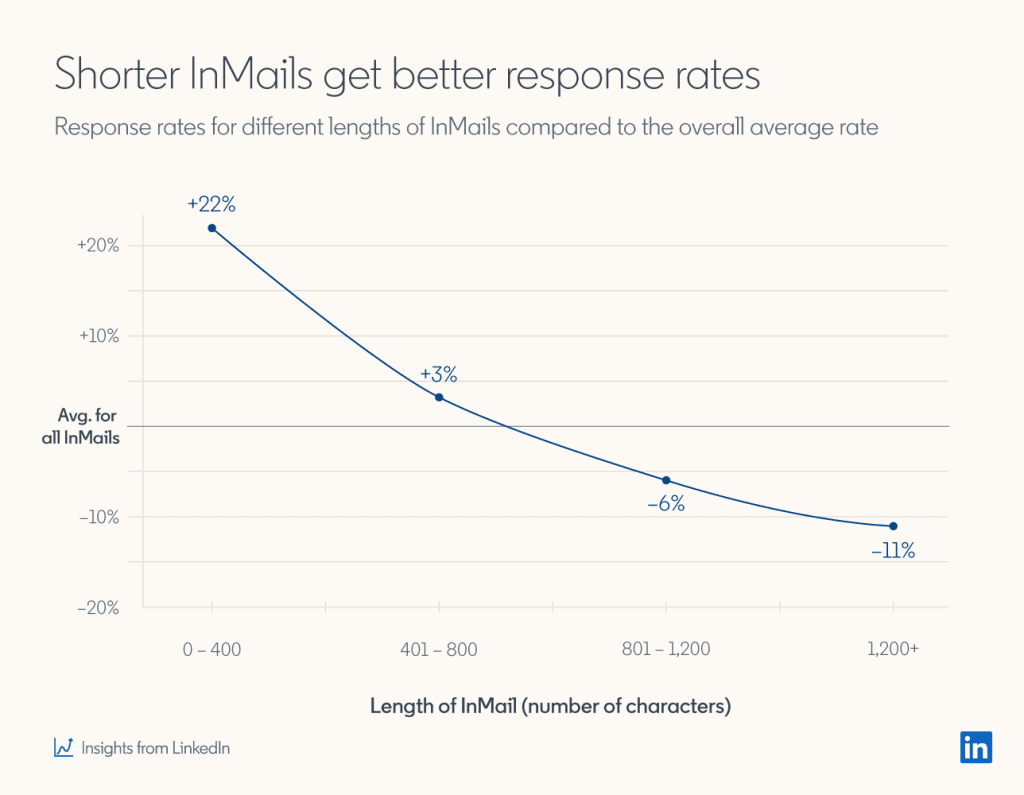
As mentioned before, LinkedIn InMail gets far better results than emails. Especially if you write a message that will generate a high response rate. If you are not sure how to write such messages, here are a couple of LinkedIn InMail examples with a 25% reply rate formula to get inspired, along with impactful LinkedIn inMail subject line examples..
You can send InMails to your 2nd and 3rd-degree connections. However, depending on your subscription plan, you will have different amounts of Inmail credits per month. For example, a LinkedIn premium subscription grants you 15 paid InMail credits. On the other hand, the Sales Navigator account offers 50 paid InMails per month. If you pay a Recruiter Lite subscription, you will have 30 paid InMail credits a month. Recruiter subscribers are also the only LinkedIn members who can purchase additional paid InMail credits.
Apart from paid ones, you can also send 800 free InMails per month. The trick is to find people with their LinkedIn profile set to Open. The easiest way to find people with an open profile is by going to your 2nd or 3rd-degree connection’s premium profile. Then click the Message button. If you see the text Free message at the bottom, that person has an open profile.
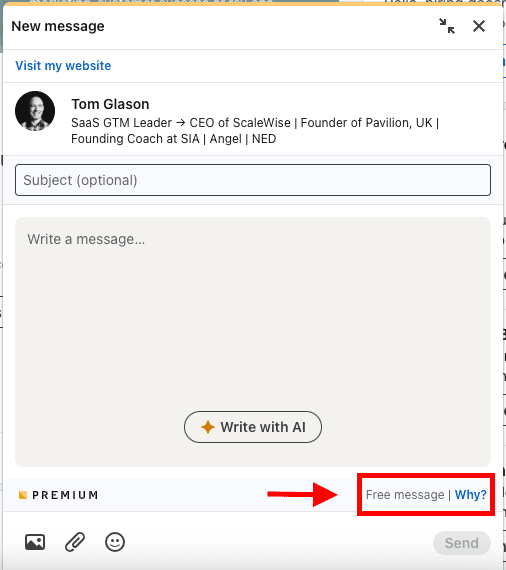
View profile and follow features
And if your outreach falls behind, you can always stop by your lead’s LinkedIn profile to view or follow them. The leads will receive a notification of whichever action you perform. In other words, it will almost always remind them of your message and give them a nudge to respond to you.
LinkedIn outreach in 6 easy steps
1. Define ICP and buyer persona
The first step to finding qualified prospects & leads is creating an Ideal Customer Profile and Buyer Persona.
These documents represent the aspects of your perfect leads and the company they work in. They are the basis for quality lead generation and usually contain specifications such as:
- Job titles;
- The industry they work in;
- Company size;
- Pain points, etc.
ICP and Buyer Persona are best created based on your current customer data, such as who:
- Has the shortest buying cycle;
- Keeps high retention rate;
- And refers your product elsewhere.
In addition, try to keep these documents actionable. In other words, create the specifications so you can use them either for:
- Your prospecting via LinkedIn, Recruiter, or Sales Navigator advanced search filters;
- Or for LinkedIn outreach messaging.
2. Find leads using LinkedIn search & creating lists
The next step is finding prospects that match your ICP and Buyer Persona.
If you use LinkedIn Sales Navigator or Recruiter for lead generation, you are probably familiar with various advanced search filters. Simply use LinkedIn Sales Navigator filters and import all specifications from your ICP or Buyer Persona documents. Then, save the search URL, or create a list of prospects for the next step.
If you don’t have a LinkedIn Sales Navigator account, no worries. You can still use basic filters to find your ideal leads. Or you can use some of these top LinkedIn lead generation strategies.
3. Craft your LinkedIn outreach message and outreach
LinkedIn outreach is all about how you craft your messages. So, here is a nifty hack for you. In general, every message, be it a connection request, InMail, or email, should contain one of the following:
- Your background;
- The purpose of your outreach;
- Personalized points;
- The hook;
- A solution to the pain point.
And aim for the following structure:
- Personalized intro;
- Context;
- Added value;
- CTA.
4. Nurture & engage
Once the lead responds, it’s your job to engage and nurture them to conversion. People skills play a significant role here, so here are a couple of pro tips that will help you:
- Be empathetic so you can understand their problem and how they feel about it.
- Don’t pitch first. Instead, ask them about their specific problem and customize your pitch.
- Be confident.
- Listen actively.
- Read between the lines.
- Understand body language and voice tones when you jump on a meeting.
- Be an expert at what your company does.
Top 9 LinkedIn outreach strategies
Less is more
When you write your outreach messages, it’s crucial to understand that people’s attention span is, on average, 8.25 seconds (The Treetop Therapy). That said, longer sentences and texts that cause TLDR are a no-go. So our first LinkedIn outreach strategy is approaching your leads with fewer words.
Try being straightforward with your LinkedIn messages and avoid fillers such as:
- Hope you are well;
- I was just wondering;
- Have you had the chance to;
- Just touching base;
- I’m following up on;
And so on.
Personalize
This is the essential LinkedIn outreach strategy. By writing personalized outreach messages, we connect on a deeper level with the people and remove any generic communication. This is a perfect base for social selling and securing the path for better response and acceptance rates.
You can personalize your LinkedIn outreach messages with their first name or job title. However, there are more detailed ways to do it, and we will mention them below.
Send free resource
Avoid pitching in your first message. Instead, start your conversation by asking about the lead’s workflow and pain points. Then send them a free resource that helps them solve the problem they mentioned.
If you start your sales engagement this way, you will have more significant success, as you do not appear intrusive. In return, you get the necessary information to tailor your pitch accordingly.
Leverage your connections
The more you have in common with your target audience, the more honest and reliable you appear. That said, how you seem to be can make or break your LinkedIn outreach.
One of the ways to bring similarity to your LinkedIn messages is by leveraging your mutual connections. For example, people are more open to accepting your invitation if you refer someone they know. Here is an example:
Hey {{firstName}}, {{mutualConnectionName}} sent me your profile as they think you are the right person to help me out in my research about {{Topic}}. So let’s connect and talk if you’re up for it.
Leverage LinkedIn Groups
Another way to discover leads for LinkedIn outreach is by leveraging groups. Even though they are not that active anymore, you can still use them to find and reach out to people who are still in these LinkedIn groups.
Find the LinkedIn group your leads are most likely a part of, and click Show all to see all members.

In addition, you can reference a LinkedIn group post in your outreach and ask them about their opinion about it.
Turn events attendees into your leads
LinkedIn lead generation lets you get creative with finding your most qualified leads. One of those creative ways is reaching out to event attendees.
You can find LinkedIn events that focus on the exact problem your company solves with a product or a service. This way, you can target people who are already warmed up for your outreach message.
To get to event attendees, search for the events and click the Attend button.
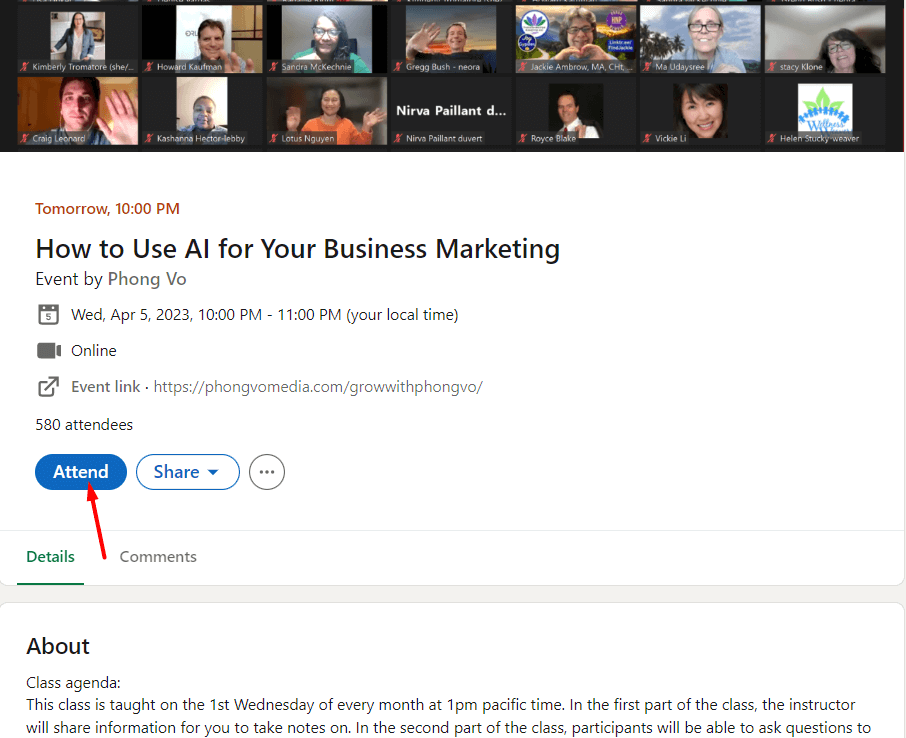
After you've attended, you can check for the list of LinkedIn users who attend this event by clicking Attendees.
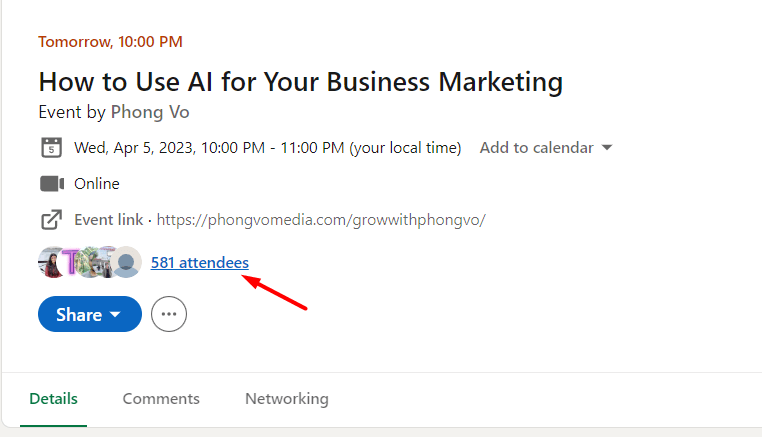
You can then go through the list and create leads in your CRM.
A true hack for LinkedIn outreach here is that you can write personalized messages such as this one:
Hey {{firstName}},
I’ve noticed that you attended {{eventName}}. What did you think about {{eventTakeaway}}? Let’s connect on this.
Contact companies that are hiring
Companies currently hiring or experiencing some change are more likely to be willing to test new products. In other words, these companies emit some buying signals.
Here’s how to find them for the LinkedIn outreach.
If you have a Sales Navigator, finding these companies is a piece of cake. Simply go to Account filters, and under Spotlights, select Job Opportunities.

LinkedIn Sales Navigator will then list company names. You can also narrow your search by selecting other filters, such as Company headcount or Technologies used.. This advanced search will help you find your ICP with the buying signals.
If you are a free or Premium LinkedIn user, you can find these companies by navigating to the LinkedIn search field. Type in the job title, select Jobs and use other filters to narrow your search. Then, go through company names and mark them down in your CRM to find key decision-makers later on.
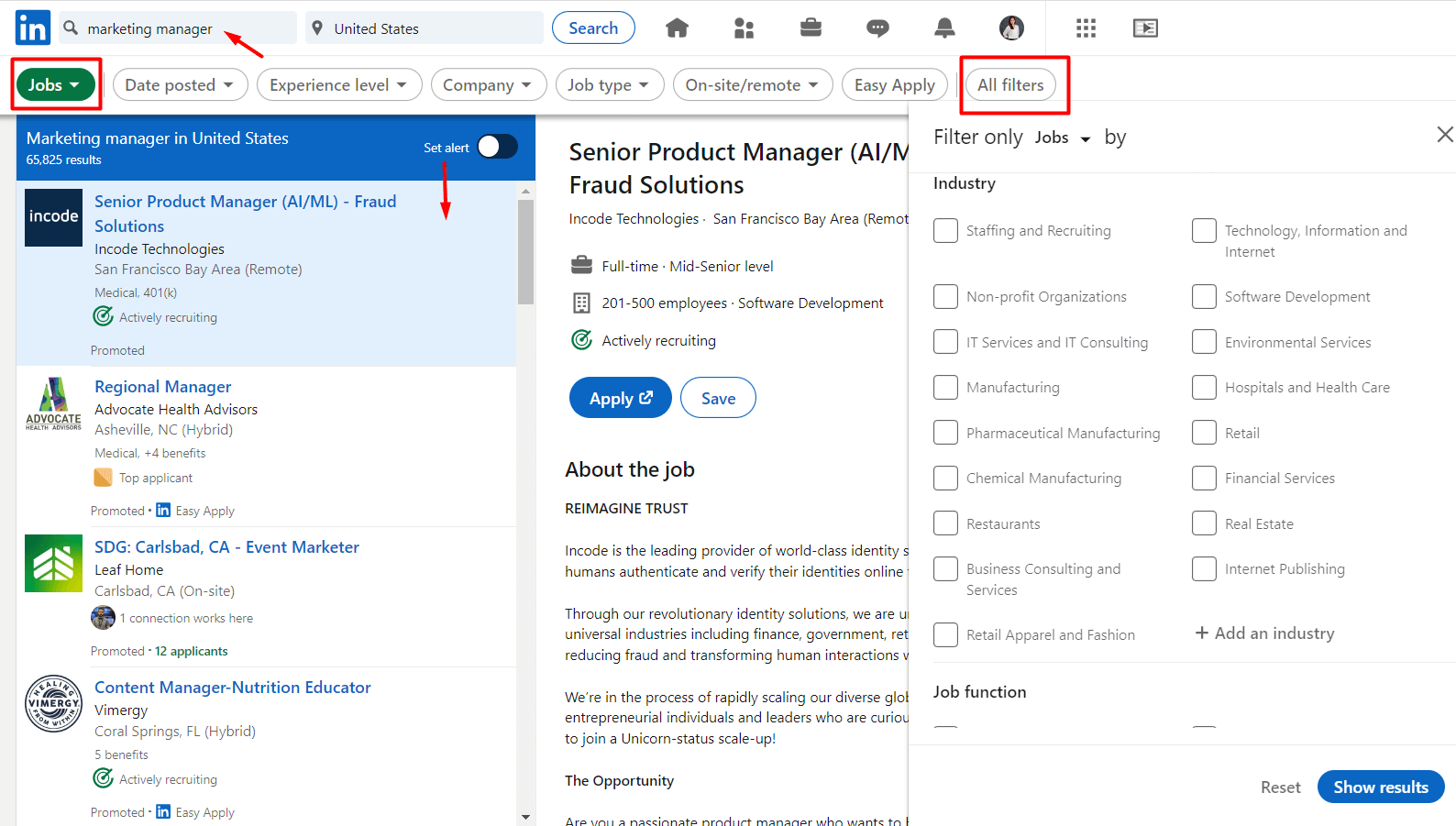
You can then reach out to the decision-makers in these companies by sending them a connection request such as this one:
Hey {{firstName}},
I noticed you are looking for a new {{Occupation}} in your company. Do you plan to change the workflow as well? If so, I have an idea that can help you improve your team's productivity and would like to connect with you.
Engage with people who reacted to a post
You don’t have to reach out only to the leads you found via LinkedIn search. If you find time, scroll through your feed or notifications and check reactions to posts. Then, whenever you see your potential lead engaging, take that opportunity to start the conversation. After all, this is one of the most natural ways to start building relationships with your network and leads.
Use AI to speed up your outreach processes
In just over a year, the integration of AI into our daily lives has transitioned from a futuristic concept to an integral part of our personal and professional routines.
When it comes to the LinkedIn outreach process, there are a few areas where you can use ChatGPT and AI-assisted tools to speed up processes. However, it is important to underline the importance of human intervention to make the AI-generated text sound as natural as possible and to adapt it to different leads and situations.
AI-assisted LinkedIn InMails
Due to their indisputable success rates, LinkedIn recognizes the importance of InMails and now offers AI-assisted InMail writing to its paying members.
All you need to do is open the InMail message window, click on the Write with AI button, and choose among the offered outreach scenarios.
You can ask AI to rewrite the message from scratch, or you can manually adjust some parts for greater impact.
Craft any message with AI-powered tools
In our blog post on how to use ChatGPT for sales, we provided detailed information on how to create prompts and inputs for ChatGPT to create any type of LinkedIn outreach message. In addition to ChatGPT, other AI-powered writing tools such as Grammarly, ProWritingAid, and Clearscope, for example, are also gaining popularity for increasing writing quality, improving grammar and style, and optimizing content for SEO. These AI tools offer valuable assistance in proofreading, editing, and optimizing written content for various purposes.
Use AI-driven content to post on LinkedIn
By consistently sharing valuable and informative content, you can establish yourself as a thought leader in your field, foster meaningful connections, and attract potential leads who resonate with your expertise and insights.
However, as we all know, writing compelling social posts takes time. On top of that, if you want to give value to your audience, every now and then you must additionally research certain topics. This is where ChatGPT and other tools for AI-driven can help you significantly speed up these processes and help you drive engagement on the platform.
7 LinkedIn outreach rules you need to consider
1. Have an optimized profile before you start
Before using your LinkedIn account for cold outreach, you need to sort out your LinkedIn profile and optimize it. In other words, setting up your profile includes:
- Picking the best profile picture and cover photo;
- Creating a catchy LinkedIn headline;
- Write your detailed summary;
- Fill in the experience section.
If you do it thoroughly, people will be more prone to accept your connection request or respond to your InMail message.
2. Think multichannel
Did you know that companies with omnichannel engagement strategies retain 89% of customers (invesp)? Then, don’t just stop at LinkedIn outreach; for the best results, include email outreach as well since it’s still an essential means of correspondence.
This way, you are showing your target audience that you care and that you are expanding your reach. What’s more, you increase the chances of getting a hold of your leads who are not active on LinkedIn. Or in case your lead leaves your invite pending for a long time.
3. Don’t be too salesy
Nowadays, LinkedIn prospecting and cold outreach can’t do anything if your approach is too salesy or spammy. In other words, don’t talk only about your company or a product. Instead, take a legitimate interest in your target audience, build the relationship first, and connect on a human level. It’s the only way without sounding too salesy and a part of the tremendous social selling. So always choose a more genuine approach to nurturing leads.
4. Provide value
Consistently provide value in the form of educational content or throughout the meeting. The pro tip here is to do it after you’ve asked your leads about their pain points. This way, you’re ensuring you are tailoring your value according to what they precisely need and want.
5. Follow up consistently
Leads often do not respond to your message, and it’s not always because they are not interested. Maybe they forgot or were busy at that time.
Suppose your prospect doesn’t respond to your LinkedIn outreach message or email. Send them a follow-up one. After all, if you do, you will increase your chances of receiving a response by 25% (invesp). So why waste it?
To help put your follow–up message together, check out our templates to send follow up emails after no response and get inspired.
6. Revoke old requests
One of the main rules people doing LinkedIn outreach stick by is canceling their LinkedIn invites.
There is a common fear that LinkedIn won’t allow you to send new requests if you accumulate unanswered ones. Unfortunately, the fear is legitimate, as quite a few people have experienced this restriction.
If the lead doesn’t answer the LinkedIn connection request or follow-ups in months, chances are they are not interested anyways. So be sure to lean up your LinkedIn invites regularly.
7 Best LinkedIn outreach templates [Our best picks]
Linkedin outreach message templates for sales
Sales outreach is about the initial impressions. That said, here are a couple of templates that demonstrate those exact points.
Acceptance rate: 34%
Reply rate: 17%
Template
Hey {{firstName}},
I came across your LinkedIn profile and was so inspired by your background in {{industry}} and your passion for {{workAreaOfInterest}}. I’d like to connect and exchange ideas in both areas.
LinkedIn connection request example
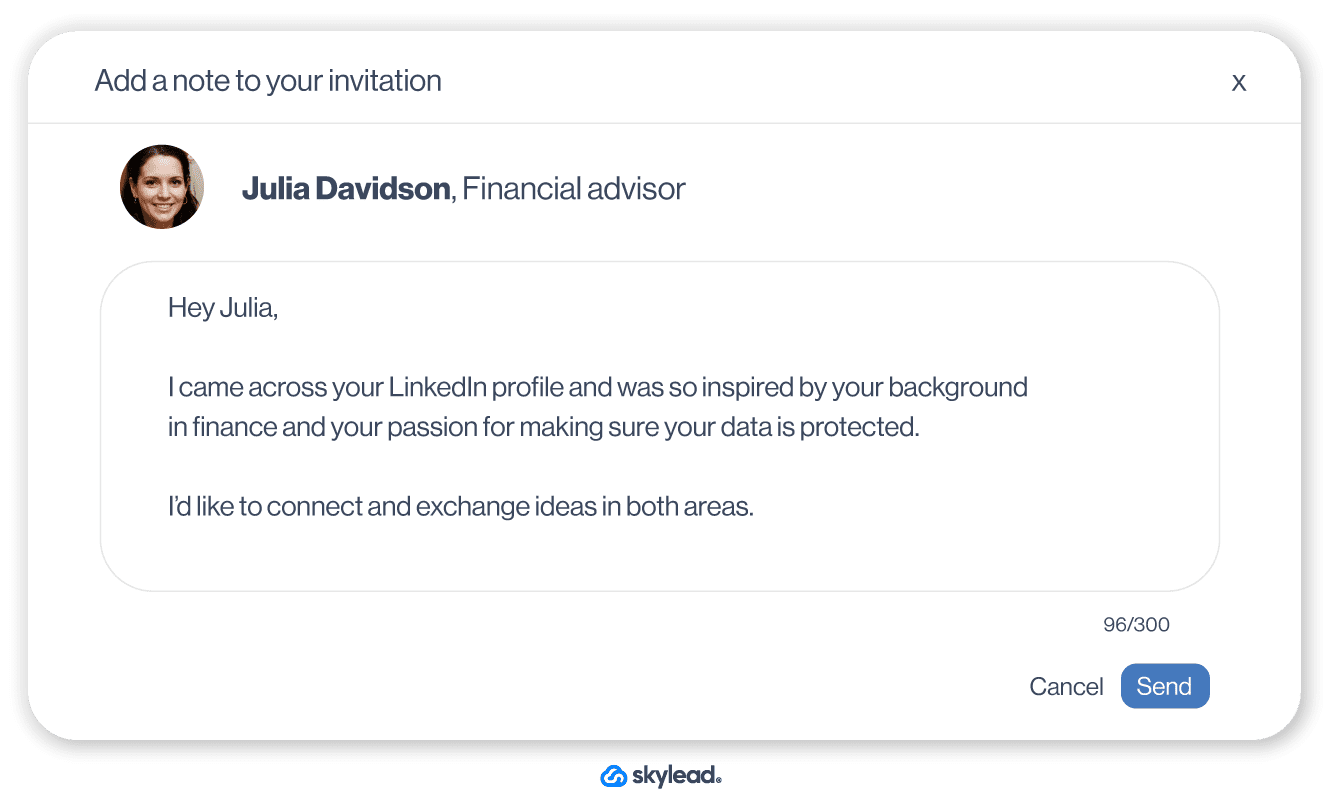
Bonus points if you can reference mutual connection. And if you feel like being humorous, you can spice up your invite with an industry-related joke, such as this one.
Acceptance rate: 53%
Reply rate 27%
Template
How many {{leadPositionTitle}} does it take to screw in a light bulb? None – they’ve automated it. 🙂 Just kidding, {{firstName}}.
But if you really wish to automate al part of your {{leadSectorName}} workflow, let’s chat. I’d like to show you something that would make your life easier. Let’s connect.
LinkedIn connection request example
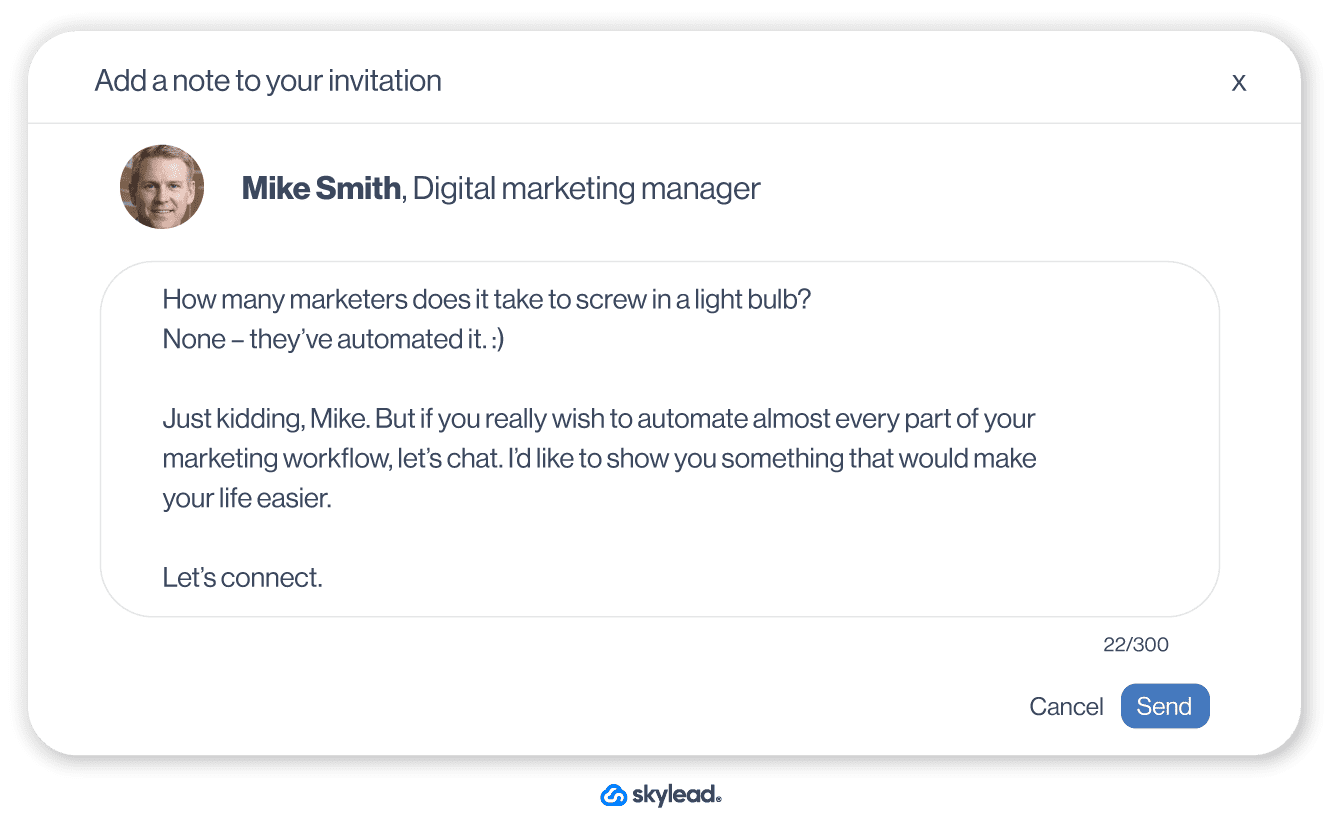
However, if all fall short and your lead doesn’t accept your invite, you can always send a LinkedIn InMail such as this one:
Acceptance rate: 43%
Reply rate: 23%
Template
Subject line: There is a key to solving {{painPoint}}
InMail message:
Hey {{firstName}},
My name is {{yourName}}, and I tried reaching out and connecting via LinkedIn invite. It appears that we didn’t get the chance to connect.
I was very much impressed with your LinkedIn profile. So, I believe your experience and dedication to {{workAreaOfInterest}} make you the perfect person to introduce you to our groundbreaking {{toolSpecification}} tool {{yourSoftwareName}}.
Our tool is created by {{leadPositionTitle}} for {{leadPositionTitle}} and it helps you:
1# {{Benefit}}
2# {{Benefit}}
3# {{Benefit}}
4# {{Benefit}}
I'd love to offer a personalized demo, so you can see hands-on how it works. Let me know if you're up for it, and we'll schedule a 15-minute call asap.
Best, {{yourName}}
InMail example
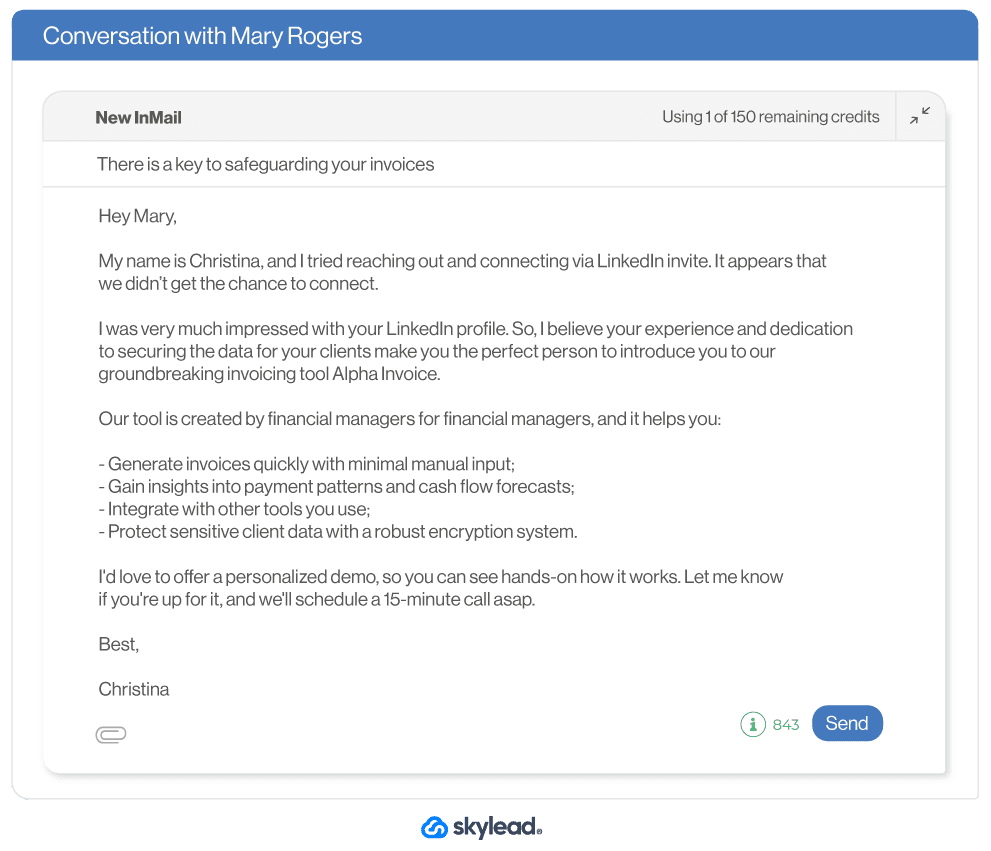
LinkedIn outreach message templates for recruiters
For example, let’s say you wish to reach out to your perfect candidate for the job in your company. Your LinkedIn connection request can sound like this:
Template
Hey {{firstName}},
My name is {{yourName}}, and we’re currently seeking a {{Occupation}}, and I truly believe that this role offers you a platform to leverage your skills and make a significant impact at our company. I’d be happy to share more details about the role and benefits we offer.
LinkedIn connection request example
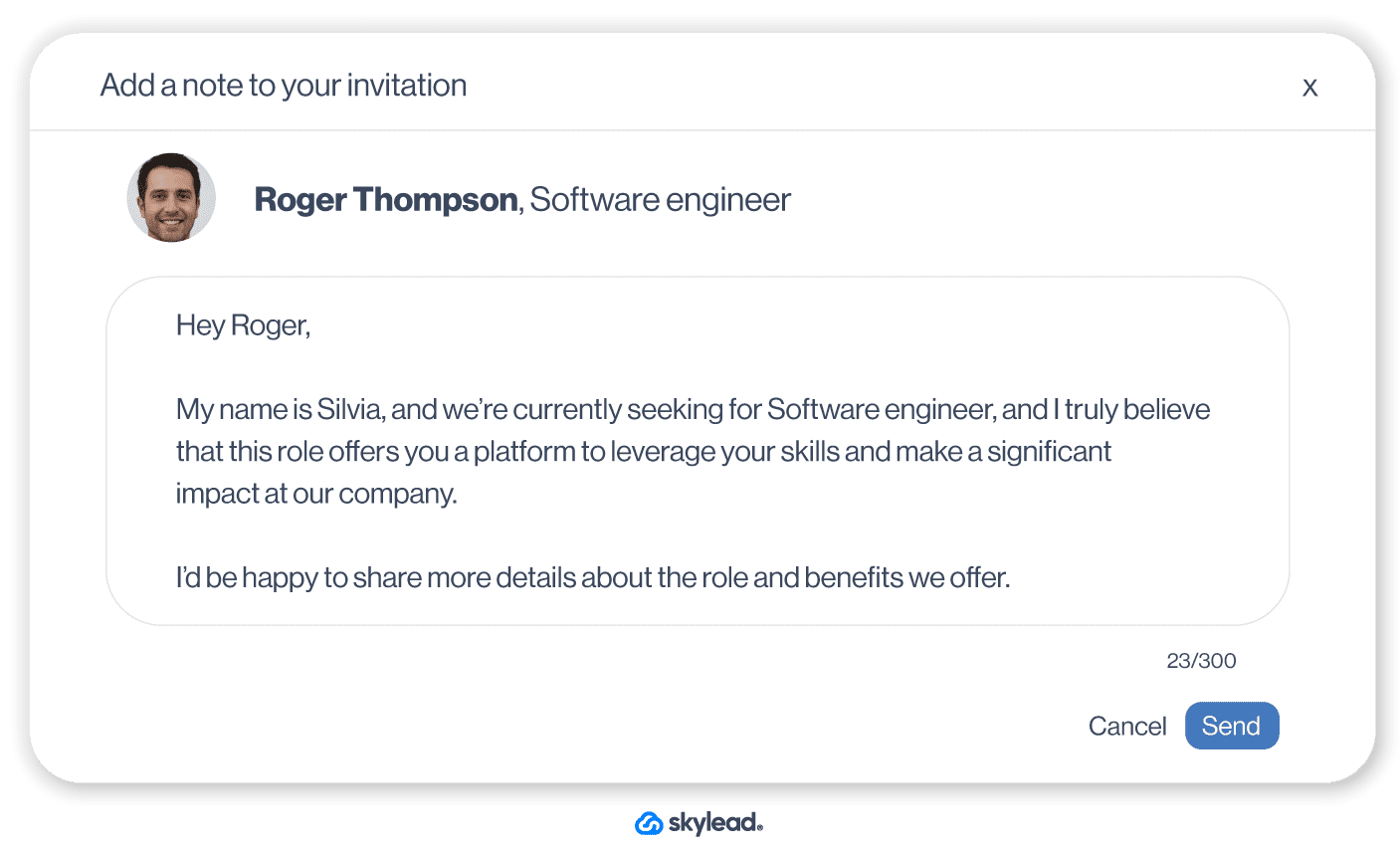
If, however, your ideal candidate doesn’t reply, use InMail format to land straight in their inbox.
Template
Acceptance rate 79%
Reply rate 46%
Subject line: Exciting job opportunity at {{yourCompanyName}}
InMail message:
Hey {{firstName}},
I understand that you may not be actively seeking new opportunities at this time. Still, I truly believe that this role provides you with a platform to leverage your {{Occupation}} skills and make a significant impact at {{yourCompanyName}}.
{{yourCompanyName}} is a {{shortDescription}}, where we take care of our employees and offer the very best, including:
1# {{Benefit 1}}
2# {{Benefit 2}}
3#{{Benefit 3}}
If this opportunity piques your interest, I would be happy to share more details about the role over the call. So let me know, and we can schedule an initial meeting at your earliest convenience.
I hope to hear from you soon.
Warm regards, {{yourName}}
InMail example
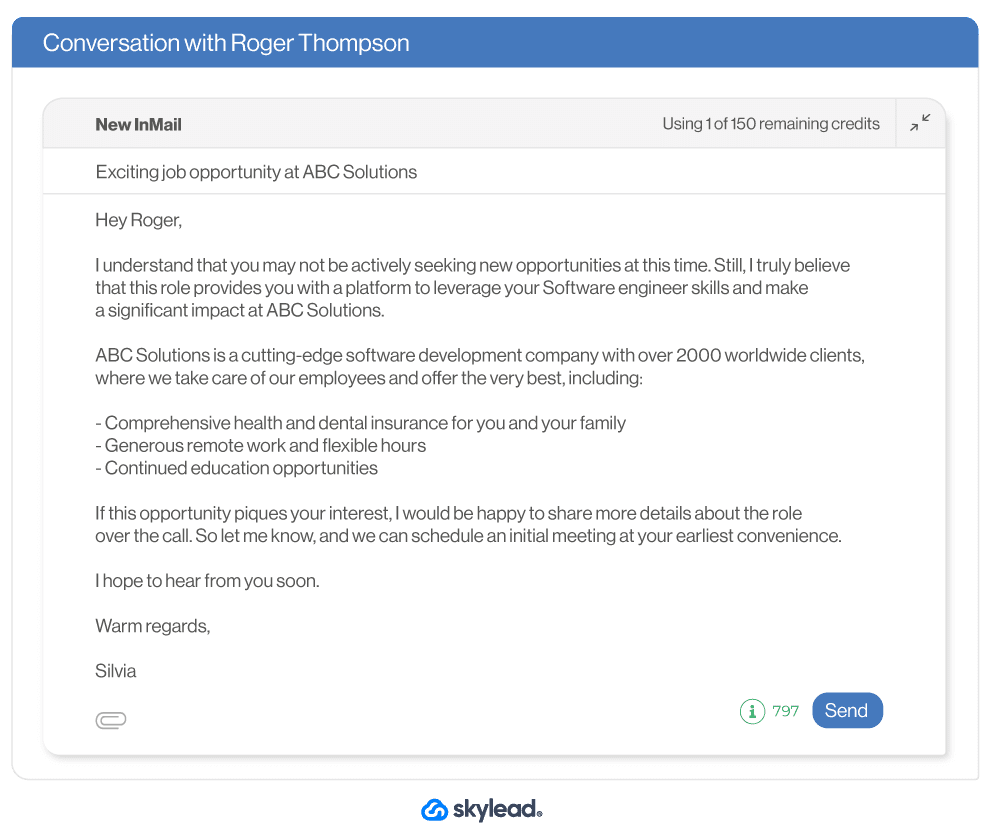
LinkedIn outreach message template for job search
We’ve all been there at one point - reaching out to companies and trying to get ahold of recruiters. Thankfully, you don’t need to search for their email addresses, as LinkedIn allows you to contact a recruiter from your ideal company directly. However, if you really wish to catch their attention, use this connection message template.
Acceptance rate: 67%
Reply rate: 32%
Template
Hello {{firstName}},
I have been following {{companyName}} and I’m impressed by your values, and dedication to innovation. As a skilled {{Occupation}} and enthusiast for {{companyIndustry}} I believe your company could benefit from my background. Let’s meet each other and talk about it.
LinkedIn connection request example
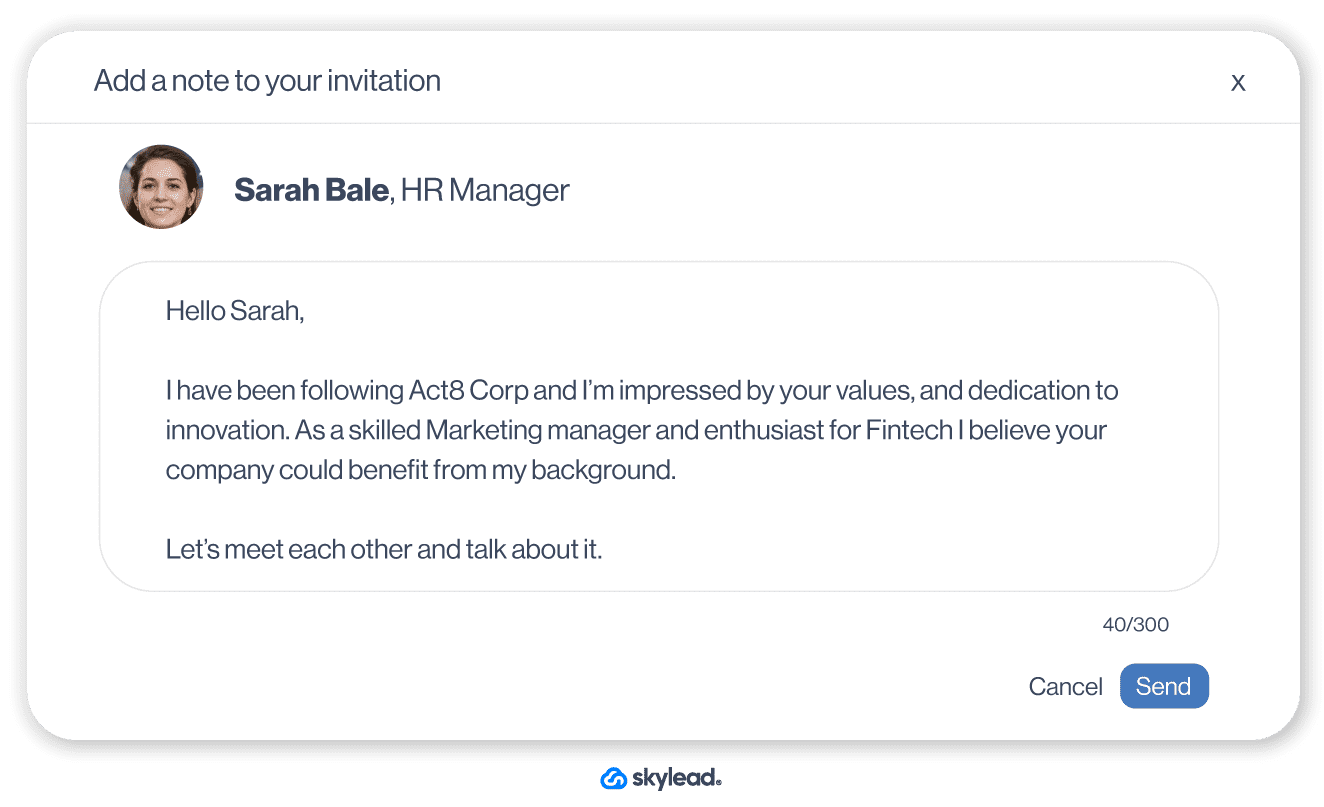
Moreover, if you have a LinkedIn Premium account, even better. You could send them an InMail that looks like this:
Template
Subject line: Proactive and passionate {{Occupation}} ready to make a difference at {{companyName}}
InMail message:
Hey {{firstName}},
My name is {{yourName}}, and I am a skilled {{Occupation}} with extensive experience in {{companyIndustry}}. I have been following {{companyName}} for some time now, and I am incredibly impressed by your {{Achievement}}, values, and dedication to innovation.
As someone really passionate about {{companyIndustry}}, I believe my background and skill set make me an ideal candidate to contribute to your team’s ongoing success.
I have achieved {{specificAccomplishmentOrResult}}, which has led me to {{quantifiable outcome}}. In addition, my expertise in {{specificSkill}} has allowed me to make a significant impact on my team’s performance and overall business growth.
I am excited about the prospect of bringing my skills and enthusiasm to {{companyName}}. I have attached my resume for your review and would be grateful for the opportunity to speak with you about how I could contribute to your team.
If there are any open positions or upcoming opportunities that align with my background, I would appreciate your consideration.
Thank you for taking the time to read my message, and I look forward to hearing from you.
Best, {{yourName}}
InMail example
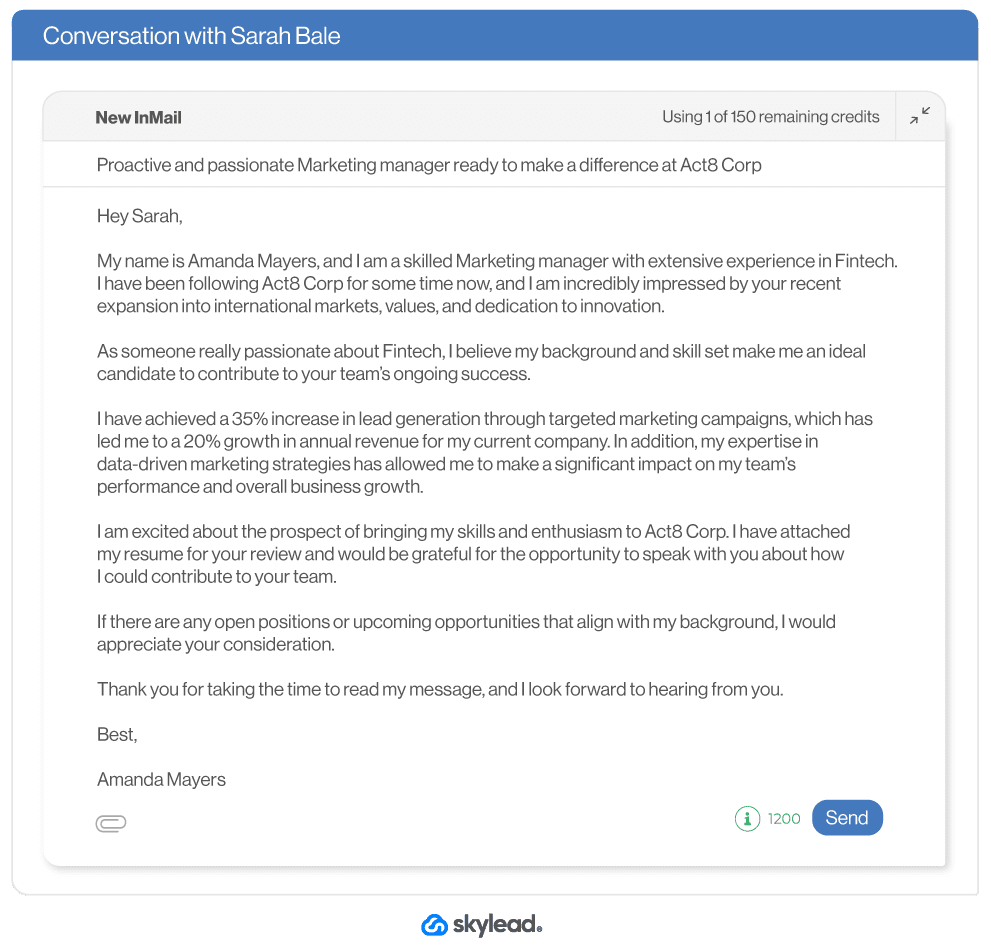
LinkedIn outreach stats
1. Users who have 70+ SSI have 45% more opportunities and are 51% more likely to hit sales targets. Moreover, it will grant you 20% more reach. (Tribal impact)
2. LinkedIn is 277% more effective for lead generation, far more than platforms like Facebook and Twitter. (HubSpot)
3. 92% of potential clients are willing to engage with an industry thought leader, making the thought leadership LinkedIn lead generation strategy very effective (CH Consulting Group).
4. Marketing managers experience up to 2 times higher conversion rates on LinkedIn. (LinkedIn)
5. Sending a personalized InMail will increase your response rate by up to 30%. (LinkedIn)
6. Lead conversion rates on LinkedIn are 3x higher than other ad platforms. (LinkedIn)
7. Audiences exposed to brand and acquisition messages on LinkedIn are 6x more likely to convert. (LinkedIn)
Frequently asked questions about Linkedin outreach
Those were some fascinating stats, ha? 🙂 Before we conclude this blog, let’s answer some frequently asked questions about the topics we didn’t get the chance to mention above.
Is prospecting on LinkedIn worth it?
Yes. LinkedIn prospecting helps you find your ICP and Buyer Persona with filtering options such as company size or industry. Moreover, the lead’s LinkedIn profile usually contains publicly available contact information, such as phone numbers or email addresses, that you can use to contact your leads outside LinkedIn.
What is the success rate of LinkedIn outreach?
LinkedIn outreach success rate depends on your goal and personalization level, but it’s usually high overall. For example, one of our sales team’s campaigns has the following result: out of 2782 connections sent, they experienced a 33% acceptance rate and 17% response. In some cases, the results go even higher.
What is a respectable number of LinkedIn connections?
You can have up to 30,000 connections, but the respected number depends on what you want to achieve. For example, for salespeople and recruiters, it’s essential to connect with as many people as possible to expand their network, thus reaching people outside of it and getting more leads.
Is it better to have followers or connections on LinkedIn?
Followers and connections are equally important, so it depends on your goals. For example, if you are a LinkedIn marketer and wish to focus on sharing content, gaining followers might be better for you. However, salespeople benefit better from the connections, as building relationships is the basis for successful selling.
Ready for LinkedIn outreach?
That’s a wrap-up for LinkedIn lead generation! This has been a wild ride.
Naturally, you can’t memorize everything from this article. Therefore, make sure to bookmark it, so you can return to it and remind yourself about best practices for LinkedIn lead generation.
And if you’re looking for a way to expand your outreach to email, try Skylead for 7 days for free, and experience firsthand how fast you can scale your business!

Disclaimer: Skylead is not affiliated, endorsed by, or connected with LinkedIn in any way.
Looking for leads? Ever heard of LinkedIn prospecting? It’s about time you do!
If we know that LinkedIn is the largest professional social media network in the world, with a staggering 1 billion users, of whom 65 million are decision-makers, then it’s safe to say that it is a place to be for prospecting. Our complete guide on LinkedIn prospecting will cover:
- the concept of LinkedIn prospecting
- why LinkedIn is the best place for prospecting
- how to get started
- the do’s and don’ts of prospecting on LinkedIn
- 18 best strategies
What is LinkedIn prospecting?
By definition, LinkedIn Prospecting is the practice where salespeople and recruiters leverage LinkedIn as a part of their social selling activity to identify and engage with potential customers among platform members. Their goal is to build professional relationships and offer products or services that best meet their needs.
What does LinkedIn prospecting mean?
LinkedIn is a professional network ideal for B2B (business-to-business) interactions, where salespeople can find and nurture potential business clients. It’s all about identifying the right target audience and fostering relationships with them, using the platform's features to manage the entire process.
But how does it work? LinkedIn helps you spot new prospects by providing insights into members' job titles, company information, and some personal information—key data for your outreach. Look at your prospect's LinkedIn profile as a gold mine of information, crucial for deciding if they're a fit for your product so you can plan and personalize messages and follow-ups.
Before reaching out, we believe that studying your prospect's profile is essential. Connecting is only the start; understanding how your product can help them and genuinely caring about their business is what can keep the conversation going. This process is gradual and involves patience, thoroughness, and constant optimization.
Now that you’ve found and studied your target audience, we get to initial contact. Cold outreach on LinkedIn involves contacting potential clients you haven't met before, aiming to pitch your product or service. But it's not just about the pitch; it's about building relationships and understanding their needs.
Remember: LinkedIn prospecting isn't a one-size-fits-all formula. It's complex, demands a solid strategy, and depends on many factors. But there's a reason LinkedIn is a top pick for social selling and online prospecting, as you’ll come to learn while you go through this blog.
Why LinkedIn prospecting?
LinkedIn differs from other social media platforms like Instagram, Facebook, and Twitter because it's focused on B2B relationships. It's a one-stop shop for finding business contacts. Plus, it supports both prospecting and lead generation.
We need to clarify something: Prospecting and lead generation are not the same. Prospecting is about identifying and nurturing potential customers, while lead generation attracts and converts customer interest. A prospect is a qualified contact, whereas a lead is unqualified.
In recent years, the pandemic shifted these activities to the online world. This was when social selling became a thing - the practice of using social media to find and build relationships with prospects to meet sales goals. LinkedIn, being a professional, B2B-focused platform, has thus gained more advantages for social selling, as it supports all stages of the sales process.
However, success on LinkedIn isn't easy. Sales teams face the challenge of identifying the right business contacts among many, and decision-makers on LinkedIn are flooded with LinkedIn connection requests, regular messages, and InMails. But don’t worry! There are strategies to stand out and connect effectively with potential clients, which we will cover later in this blog.
How to get started with LinkedIn prospecting?
1. Define your Ideal Customer Profile & Buyer Persona
An ideal customer is someone who will benefit from the product or service on many levels and has also shown interest in it. In marketing and sales, we call that a qualified prospect.
Defining your ideal prospects helps focus your sales and marketing on the most promising leads. In B2B, this means understanding the Ideal Customer Profile (ICP) for target companies and the Buyer Persona for their decision-makers or a person who will use your product.
Knowing these details improves how you identify and approach them on LinkedIn, making your social selling more effective while saving time in future outreach efforts. In fact, our Head of Sales, Andrea, says that if you define your ICP and Buyer Persona right away and you do it correctly, you won’t waste time on bad results.
Let’s go over them. 👇
Ideal Customer Profile (ICP) describes companies that benefit most from your product or service. These companies typically have:
- the fastest conversion cycles
- highest customer retention
- highest lifetime value (LTV)
- are likely to refer your product or service to others.
Buyer Persona is a detailed profile of your ideal customer, encompassing behavioral, demographic, firmographic, and psychographic traits. This persona represents someone who:
- Experiences pain points directly addressed by your product or service,
- Is a decision-maker,
- Contributes to a shorter buying cycle when aligned with the ICP,
- Actively advocates for your product.
Note: Each company that fits your ICP can have one or more than one Buyer Persona for you to target. In short, ICP represents the company profile, while the Buyer Persona focuses on the particular type of person’s profile within that company.
2. Find potential customers
Once you’ve defined your Ideal Customer Profile and Buyer Persona, it’s time to find them on LinkedIn. You can use LinkedIn to understand their pain points and keep all communication in one convenient place, from initial contact to follow-ups.
But that’s not all LinkedIn does. It encourages a series of behaviors through certain features that we can use to find ideal prospects and build B2B relationships.
- LinkedIn allows networking among the members attending the same LinkedIn event despite some members not being connected.
- LinkedIn awards posting relevant content by giving these members greater exposure on the platform.
- LinkedIn gives you options to join LinkedIn groups of your interest. Use Sales Navigator to target members of a LinkedIn group.
- Reach busy decision-makers through paid and free LinkedIn InMails
- You can use numerous filters to find your ideal prospects.
You will find strategies on how to effectively find more prospects later in the blog.
3. Structure your outreach
Effective LinkedIn connections go beyond just sending requests to users matching your Buyer Persona. It involves a detailed outreach plan, including:
- a LinkedIn sales strategy
- message flow
- messaging frequency
- follow-up actions
- identifying the prospect's preferred communication method (LinkedIn, InMail, email, or call)
- strategically timing your sales pitch
- optimizing your outreach for better results.
We know, it’s a lot to keep track of: conversations, relationship stages, and buyer's journey positions for multiple prospects. This is why we recommend you use a CRM (Customer Relationship Management) software for your LinkedIn leads. It organizes customer data and streamlines lifecycle processes, replacing countless spreadsheets and documents.
4. Reach out & follow up
Once your LinkedIn outreach campaign is structured, start connecting with potential customers. Remember, first impressions matter in social selling. Look at it like this: your profile is your business card; members will take a peek and focus on your profile picture, cover photo, LinkedIn headline, and LinkedIn summary.
An all-star-status profile increases views and connections due to higher search visibility. When reaching out, ensure every message, whether a connection request or InMail, is personalized, showing you've researched the recipient and leaving room for conversation.
Follow-ups are key in outreach. Not all potential customers will be immediately responsive, especially busy decision-makers with a ton of requests. Be persistent but also recognize when to pause with outreach and wait for a better opportunity to re-engage. Also, be sure to try templates.
5. Use multichannel outreach
A cold email is an unsolicited email that is sent to your prospect without prior contact as part of your cold outreach strategy. It could also be defined as the written equivalent of cold calling. Cold email outreach, just like LinkedIn outreach, aims to make contact with prospects and build professional relationships for the sake of sales as an end goal.
Since sales processes moved mostly online, the combination of LinkedIn outreach and cold emailing has given the best results. From our experience, we believe that combining LinkedIn with cold email outreach will increase your chances of getting to your desired prospects and converting them. Pavle, our sales executive, used a multichannel sequence to reach a 35% reply rate.
The 18 most effective LinkedIn prospecting strategies
As promised, we’ve done the research so you don’t have to, and now we present the 18 most effective LinkedIn prospecting strategies that are likely to bring qualified prospects for your business. Let’s review the list.
1. Use the Boolean search to narrow down your prospects
LinkedIn Boolean search allows you to combine words and phrases using the Boolean operators AND, OR, and NOT to limit, broaden, or define your lead generation target. Both LinkedIn and Sales Navigator filters support this type of search.
Keep in mind that the Boolean search can help you focus your prospecting efforts on ideal potential customers of a niche market that works best for your business.
2. Target LinkedIn event attendees
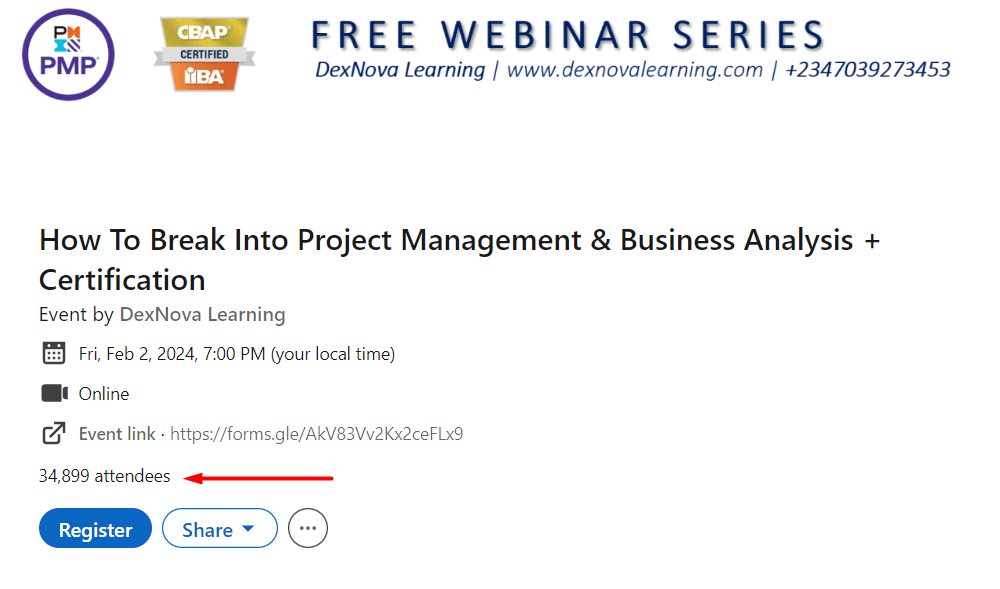
LinkedIn event attendees might not all be connected, but what connects them is what your sales pitch might be. To target prospects at LinkedIn events, focus on events your ideal audience attends. This approach not only groups them in one place but also offers insights into their needs and perspectives, which you can use to get to know them better and connect.
3. Use LinkedIn groups for prospecting
Yes, we know. Most of the LinkedIn groups are dead. However, their members are still there, despite being inactive, gathered around a common interest. This is why targeting LinkedIn groups for LinkedIn prospecting is recommended.
However, if some of these communities are active, make sure you take time and genuinely engage with them. Ask questions, offer advice, share your experience, and answer and comment on posts. Aside from high-quality prospects, you might gain valuable insights into your Buyer Persona’s problems and needs.
Remember: LinkedIn allows you to send a direct LinkedIn message to each group member without being connected to them. This is how you find groups of your interest. 👇
Option 1 - LinkedIn basic and Premium users
#1 Run a blank search or enter a keyword in the LinkedIn search engine. Use other available filters if needed.

#2 Choose your ideal LinkedIn group and click “Request to Join.”
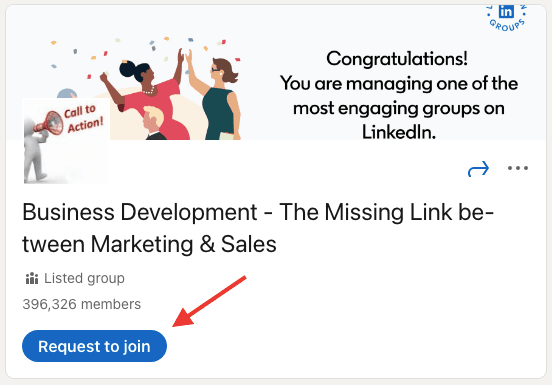
#3 Once you get accepted, this is where you find the list of members - or your prospecting list. 😉

Option 2 - Sales Navigator filters: Group filter
You can find members of different LinkedIn groups through Sales Navigator filters. Unlike other LinkedIn users, you can narrow down LinkedIn group members further to fit your search criteria even better by applying other filters.
#1 Open Lead Filters

#2 Scroll down to the “Groups” filter. Put in a keyword or the exact name of the LinkedIn group.
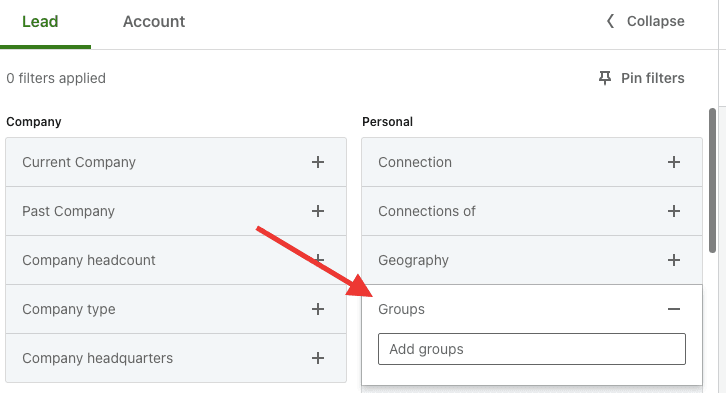
#3 Sales Navigator will suggest other similar groups.
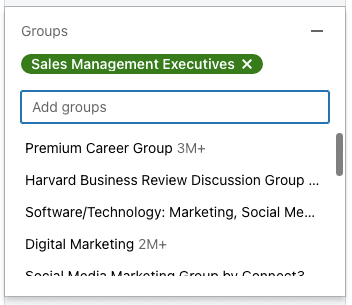
Note: Once you’ve chosen LinkedIn groups of interest, use other Sales Navigator filters to narrow your search results.
4. Take full advantage of free & paid InMails
LinkedIn InMail message is a direct private message to or from a LinkedIn member who is not part of your network. LinkedIn members that are not part of your network can be your 2nd or 3rd-degree connections.
If you’re not yet connected with your prospect, you can still send them messages, and this is where InMails comes in. Make sure to combine both free and paid InMails for a more effective outreach. However, our experience has shown that it is more effective to use InMails as the last resort in outreach if LinkedIn and email combined do not give results.
5. The People Also Viewed feature
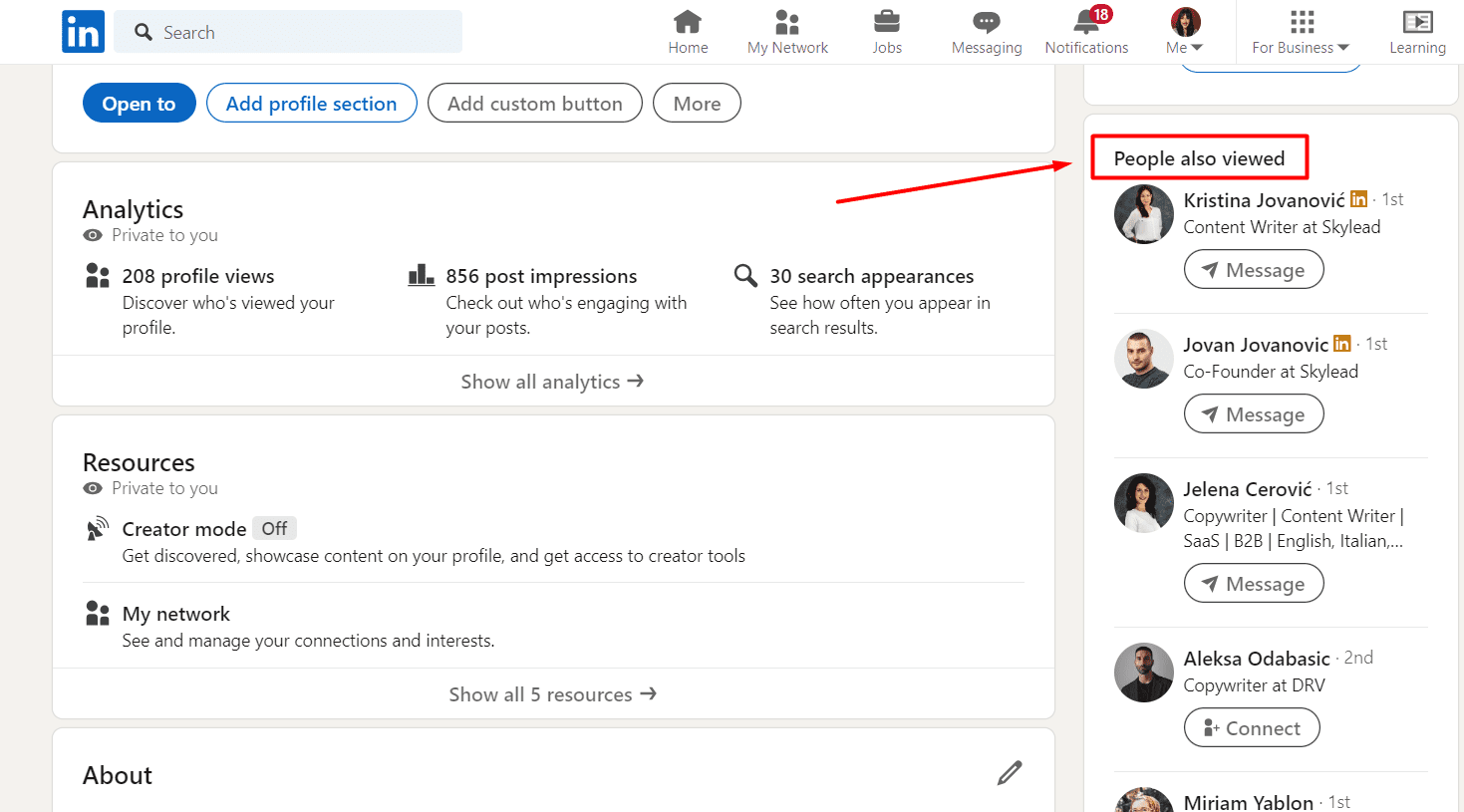
As you may know, the LinkedIn People Also Viewed feature displays a list of LinkedIn members that the platform’s algorithm found important for your LinkedIn experience, whether you are using the platform for networking, job search, or lead generation. Use the algorithm to your advantage and better target your audience.
6. The People You May Know feature
Unlike the People Also Viewed feature, People You May Know suggests LinkedIn members for you to connect with based on commonalities between you and those LinkedIn members.
LinkedIn recommends members who may have shared connections have similar profile information (experiences, company name, company size, industry, or attended the same school). You will see these profiles on the right rail of your LinkedIn profile.
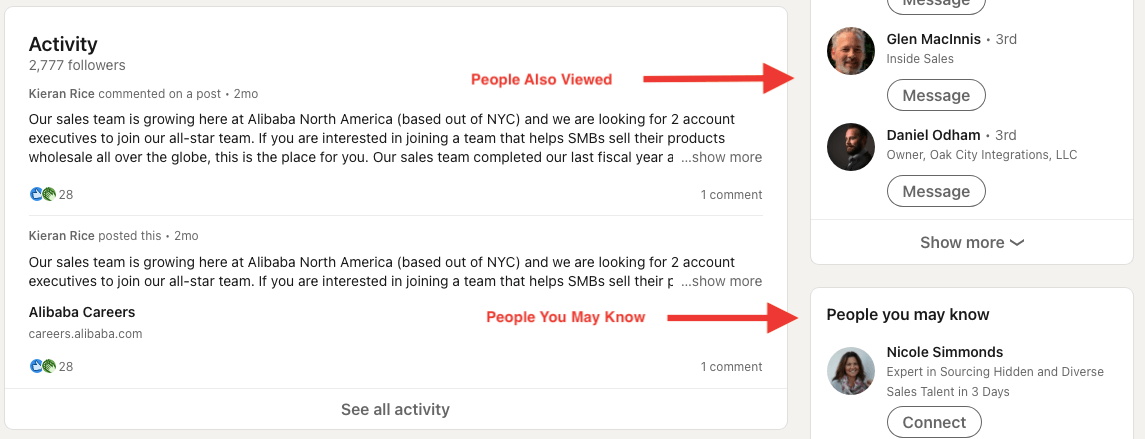
Leveraging mutual connections on LinkedIn is a strategic way to grow your network and connect with potential prospects. Mentioning a common connection can go a long way. It boosts acceptance rates, overall trust and helps build new professional relationships.
Note: Keep in mind that the better your LinkedIn profile is optimized, the more accurately algorithms will suggest members that fit your prospecting preferences.
7. Check your prospects’ Contact Info
We’ve already said that your prospects’ profile acts as a business card. Contact info sections usually contain everything you need to know to reach out. It’s available only for your 1st-degree connections.
“Contact info” can contain your prospects’ business email, private email, phone number, company website, and LinkedIn profile URL. However, not all of this information has to be filled out.
Here’s an example 👇
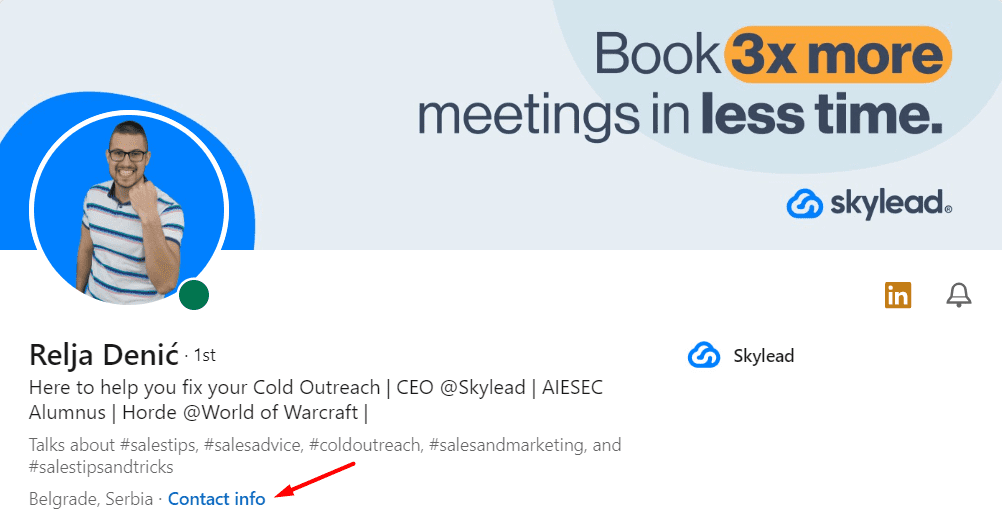
In this case, we see our lead’s business email, company website, and even phone number.
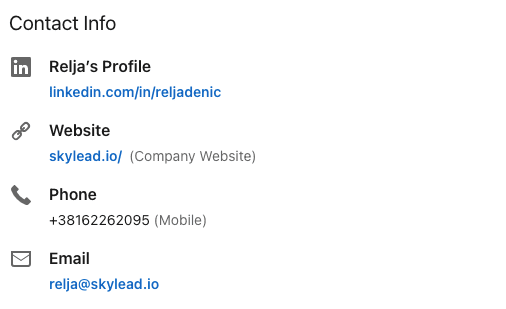
8. Follow job changes on your feed
If your 1st-degree connection changes jobs, you will get a notification. 🔔

It will show up in your feed as well. If your 2nd-degree connection changes jobs and the mutual connection reacts to it or posts a comment, you will also see it in your LinkedIn feed.
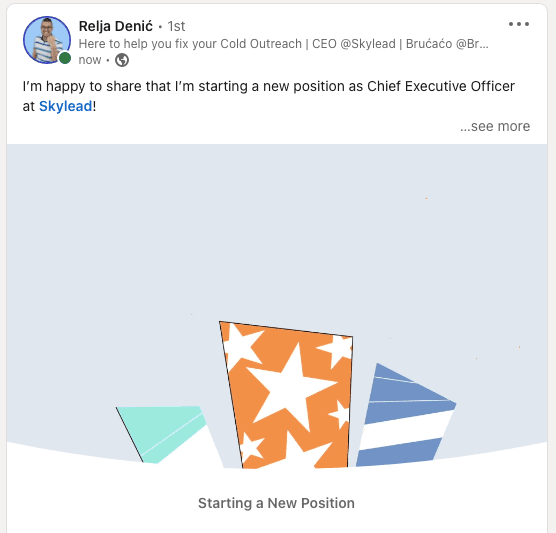
Regular updates on job changes are crucial for the LinkedIn prospecting process because a member's new job title may align with your ideal prospect profile. Additionally, leads in new decision-making roles are often more receptive to sales pitches, so you can use this moment to introduce your product/service to them.
9. The new job position alert
Setting job alerts for specific positions in companies is a long-term LinkedIn prospecting strategy. You'll get notifications about new openings, indicating company growth, investment in departments, or increased demand for their products or services. You can use these signals as an intro for your outreach efforts.
Seems convenient? This is how you set the New Job Position alert on LinkedIn 👇
#1 Write the job position or a keyword you wish to get altered for in the search bar. Then, click “Jobs.” Let’s say you are interested in the “Sales Manager” position opening.

#2 Set up the location (mandatory) first. Then, use any other filter under the “All Filters” option that will get you as close to your ICP as possible.

#3 Finally, turn the alert on.

However, if you have a list of companies you would like to set alerts for, you can manually insert them here. This way, you will create job alerts for those companies only.
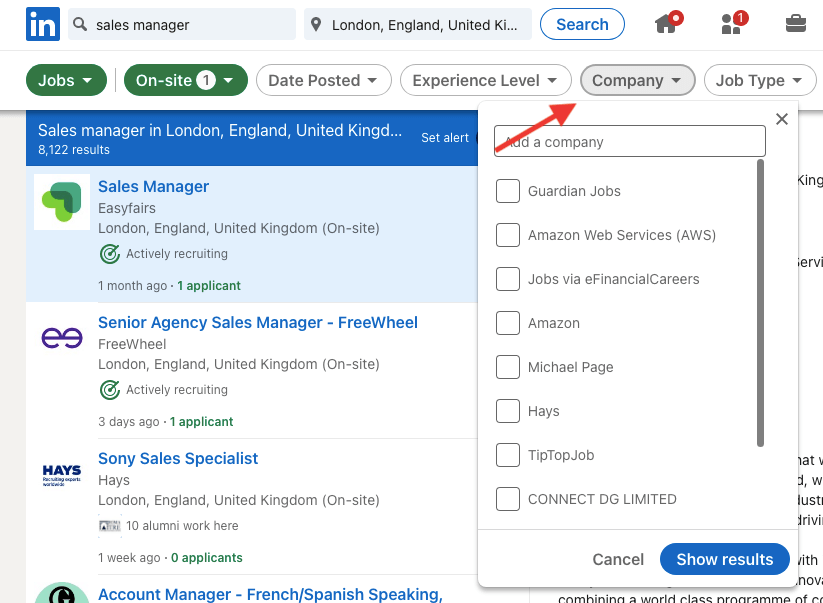
#4 Once you’ve set everything, turn the alert on and receive alerts for multiple companies or a single alert for multiple companies.
10. Target specific job openings
This hack involves searching for job openings and functions, listing companies in a spreadsheet, and contacting decision-makers. It targets current job openings, unlike the long-term strategy of setting alerts and waiting, which offers immediate search results to work with.
This is how you find leads by targeting specific job openings 👇
#1 Put the keyword in the LinkedIn search engine. For example, search for a “Sales Manager”. Set all filters to get as close as possible to your ICP.
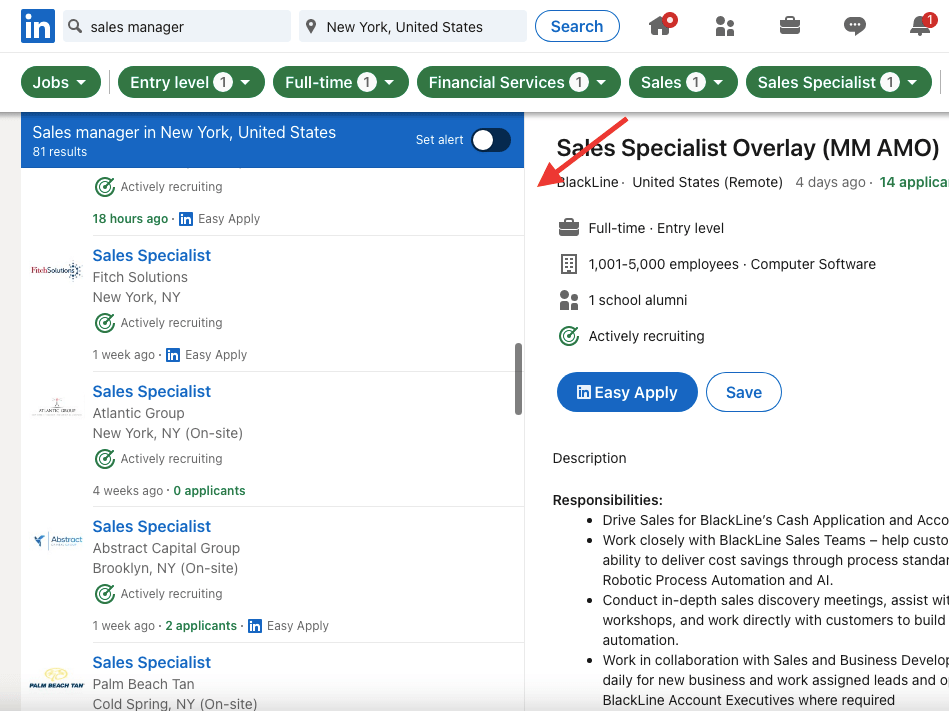
#2 Manually add each company (or handpick your target companies) into a spreadsheet. Then, find decision-makers within these companies and outreach away! ✨
11. Target your competitor’s network
Targeting your competitor’s network on LinkedIn can be an effective prospecting hack, as their connections are likely qualified leads already interested in similar products or services. To put this hack into practice, you have to connect with competitors, as it applies only to your 1st-degree connections.
Option 1 - Go to your competitor’s LinkedIn profile and find their connection list
#1 Go to your competitor’s profile and click on their connection list.
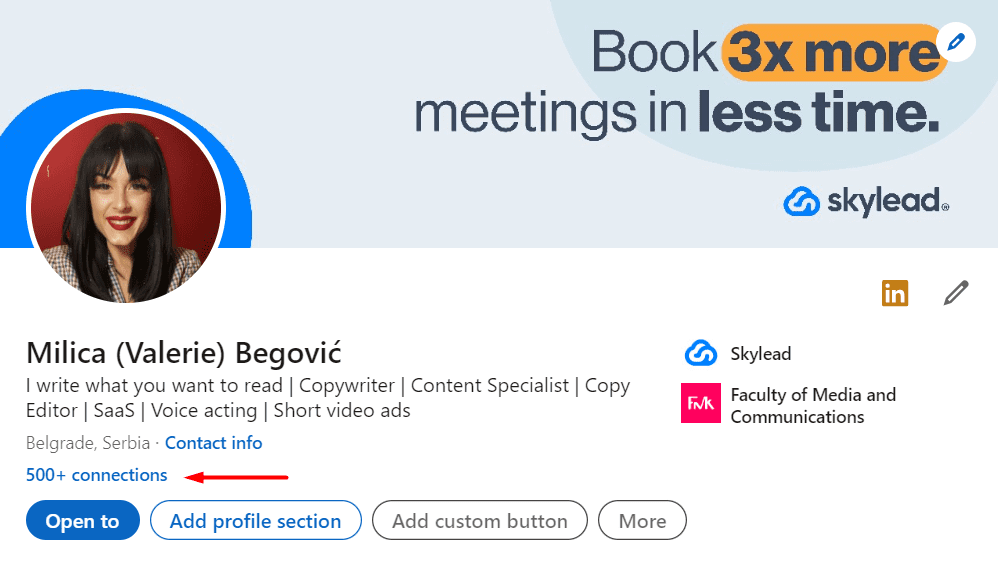
#2 Once you click, you will be able to filter your leads further. You can then hand-pick them or copy-paste the link of your final search result to a sales engagement tool, such as Skylead.
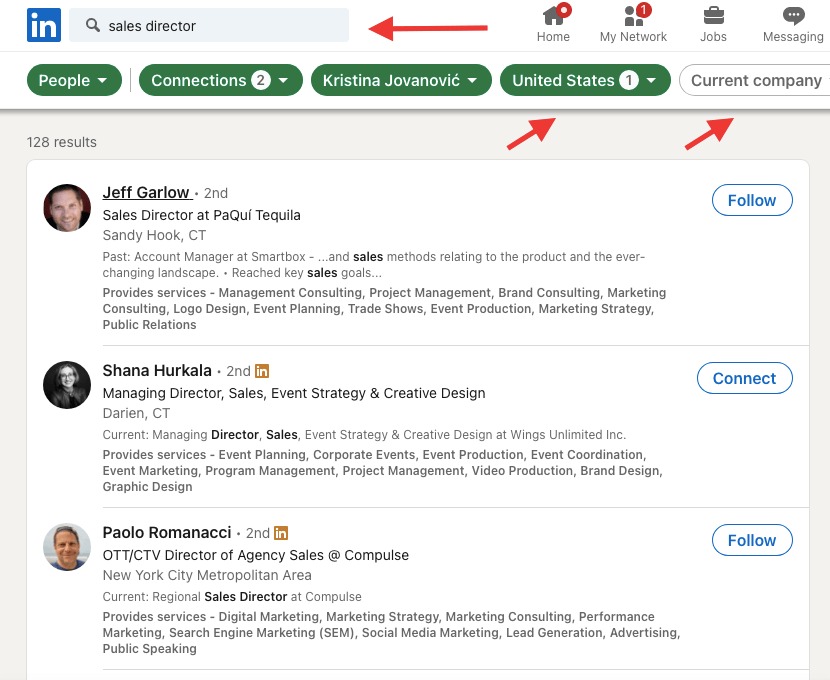
Option 2 - Search for your competitor’s connections through LinkedIn filters
#1 Type a keyword into the search bar or run a blank search. Click “All filters”.

#2 Scroll down to the “Connections Of” filter. You can target one competitor or multiple competitors’ connections. Filter your search results by using other LinkedIn filters.
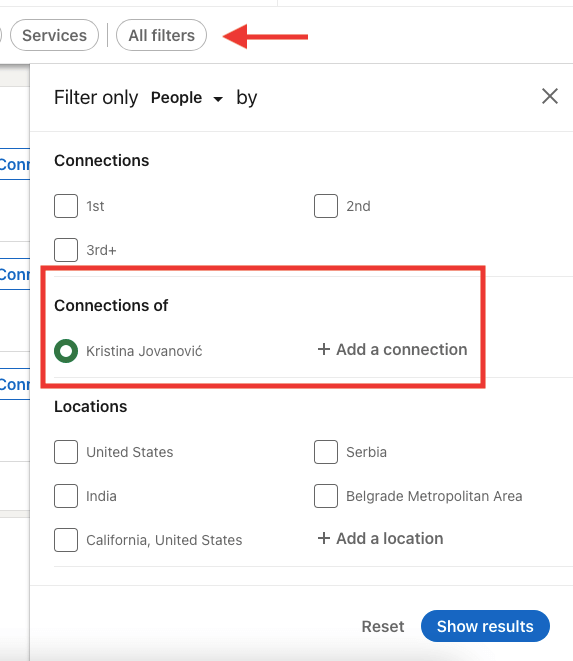
12. Reach out to people who endorsed your competitor or ICP
Keep in mind that people often connect with those similar to themselves in lead generation. Explore the "Skills" section on LinkedIn profiles, both yours and your competitors', to find potential leads through shared connections and endorsements.
#1 Scroll all the way down your potential prospect’s profile.
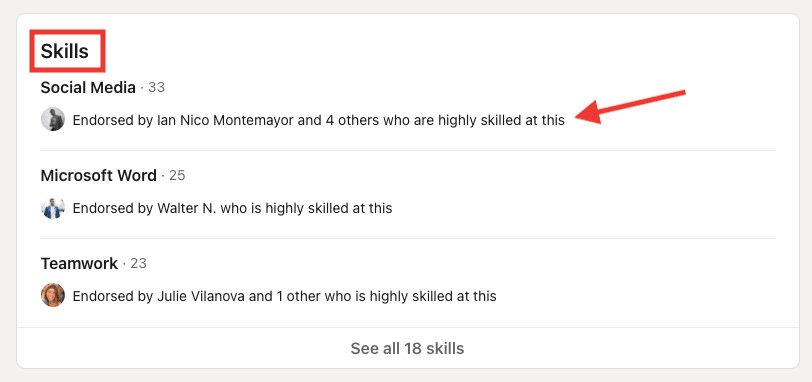
#2 As you may see, there’s a total number of people who endorsed your prospect for a certain skill. LinkedIn automatically shows only those who are categorized as “highly skilled.”
Note: When you have many connections that endorse you for a particular skill, LinkedIn marks you as “highly skilled.” Click on the link as marked above.
This is how it looks 👇
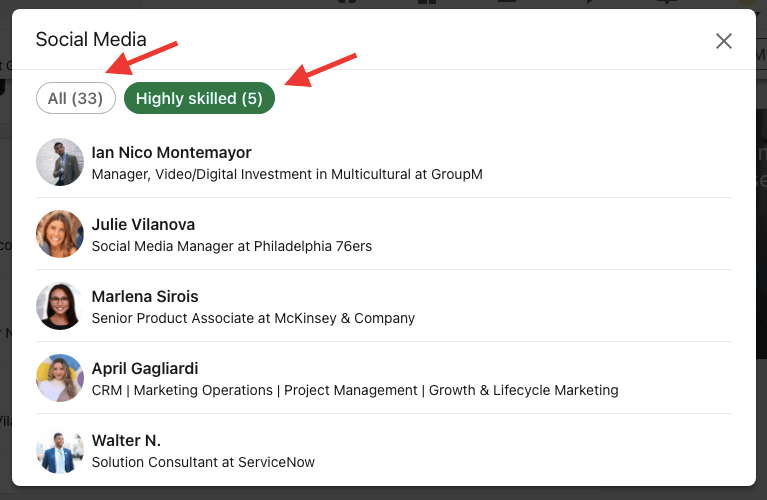
You can target everyone from the list or just the individuals marked as “highly skilled.” They are most likely to be from the same industry or use the services of your prospect.
Note: From our 5-year experience in the market, we found that endorsing someone on LinkedIn doesn’t have the same weight as writing a recommendation. The LinkedIn members you find through the Recommendations section are more likely to be high-quality prospects.
13. Target leads who wrote or received a recommendation
As mentioned above, checking the recommendation section of a prospect's LinkedIn profile is a smart move. It reveals members who have written or received recommendations, along with their names, current titles, and relationship to your prospect. This provides immediate insight into their business connections.
Let’s look at an example 👇
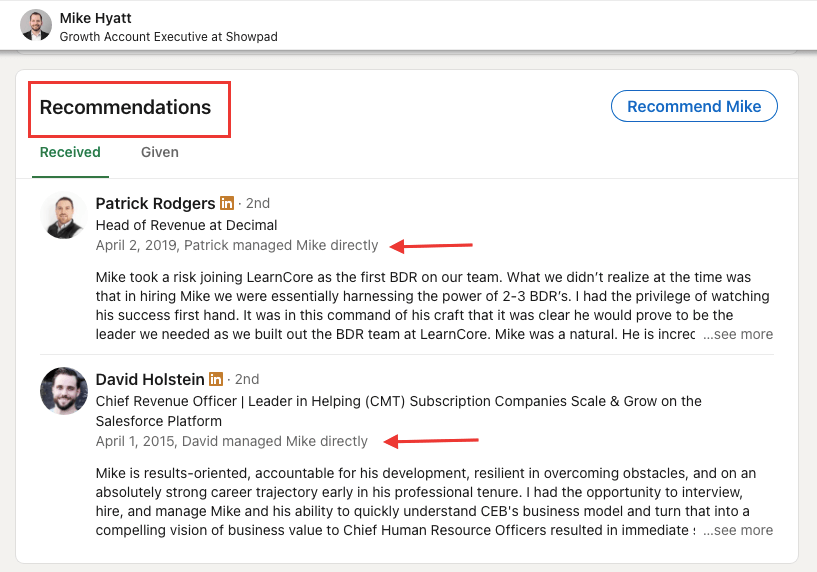
You can check out both your prospect’s recommendations and the ones your prospect wrote for others.

When leaving recommendations, you need to specify the type of business relationships you had with that LinkedIn member, as well as the position you held at the moment.
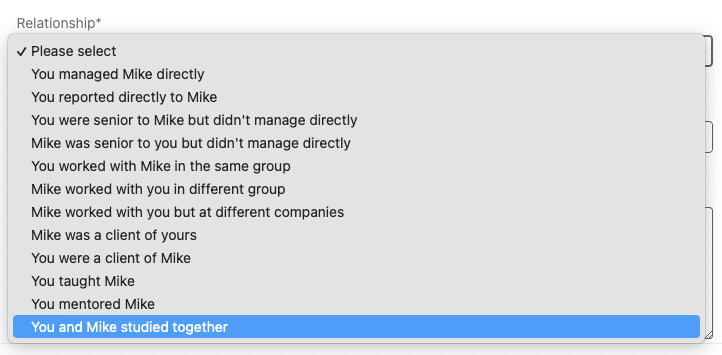
Note: The type of relationship will be displayed together with your recommendation.
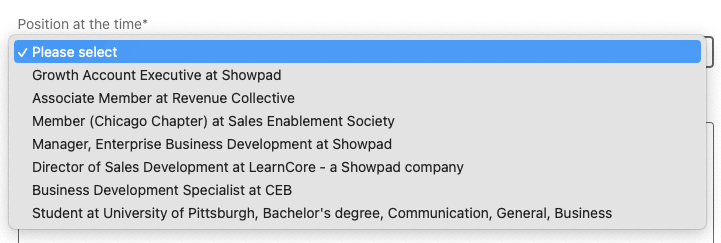
14. Target members who commented or reacted to your ideal prospect's LinkedIn post
For LinkedIn prospecting, only target posts relevant to your business and engaged by members that fit your Buyer Persona. Focus on posts from your industry, similar businesses, or those shared by people targeting or engaging your Buyer persona.
Here are two ways to find a LinkedIn post ideal for prospecting.
Option 1 - Find a LinkedIn member whose posts you want to target
#1 Scroll down through their profile and check out the “Activity” section. Click “See all activity.”
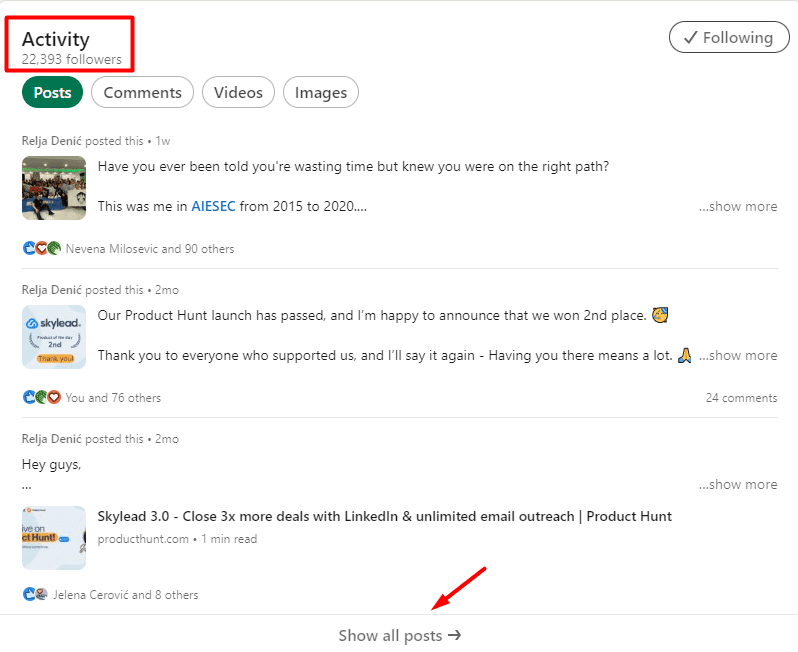
#2 Click “Posts” to see only content posted by that LinkedIn member.

#3 Choose a post that you want to target. If you are doing outreach manually, click here to see who reacted and commented on this particular post.
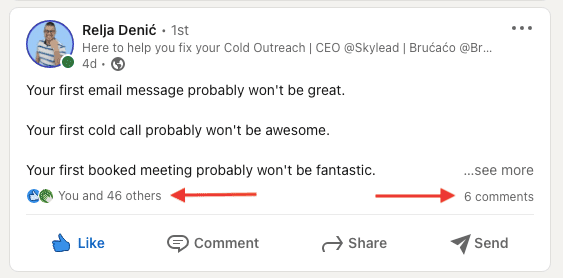
Option 2 - Find a LinkedIn post by using LinkedIn filters
#1 Use LinkedIn's search bar to find posts containing your keyword that interest your ideal prospects.

#2 Filter your posts further if necessary.

#3 Collect prospects and that's it.
15. Reach out to people who reacted or commented on your post
Using LinkedIn content for prospecting allows you to create tailored posts, articles, or LinkedIn polls to attract qualified prospects. Engage with them by asking questions, starting discussions, or teasing about new releases, and then identify potential leads.
16. Check your company’s LinkedIn page followers
Running out of places to look for prospects? Why not target individuals who follow your LinkedIn company page but don't use your services or products? They might be in related industries, seeking information, exploring options, or staying updated just in case they need you someday. The best way to understand their interest is by reaching out to them.
Option 1 - Check out your company page as an admin
Step #1 You need to be your LinkedIn company page admin to see the list of your followers.
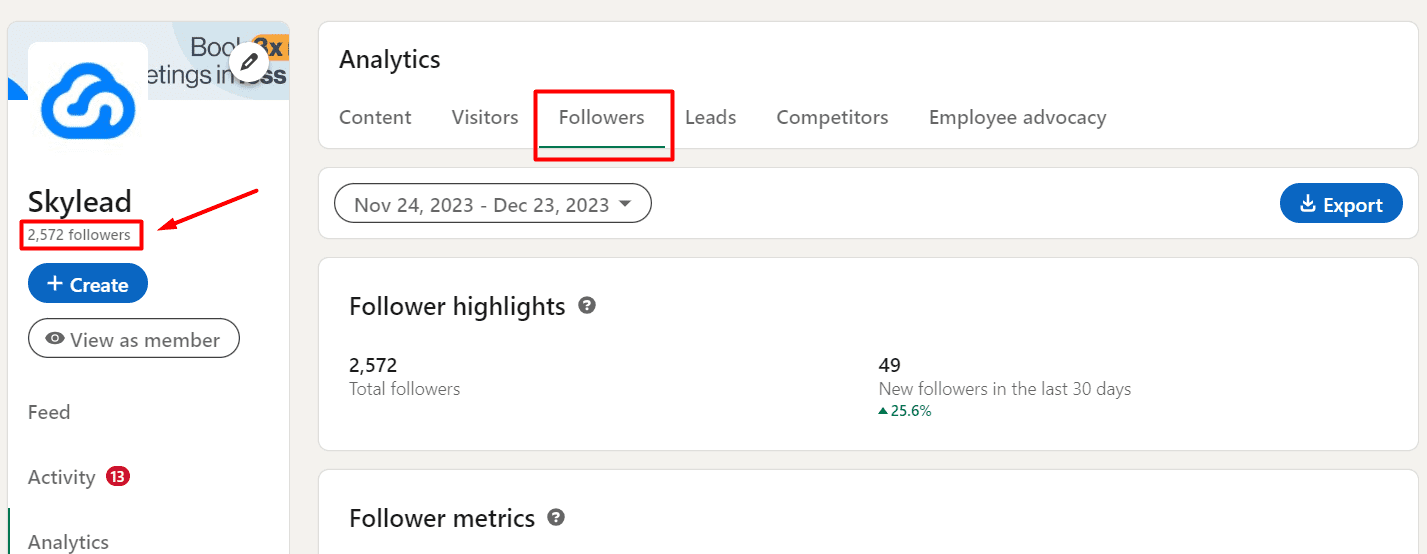
This is how the follower list looks like 👇
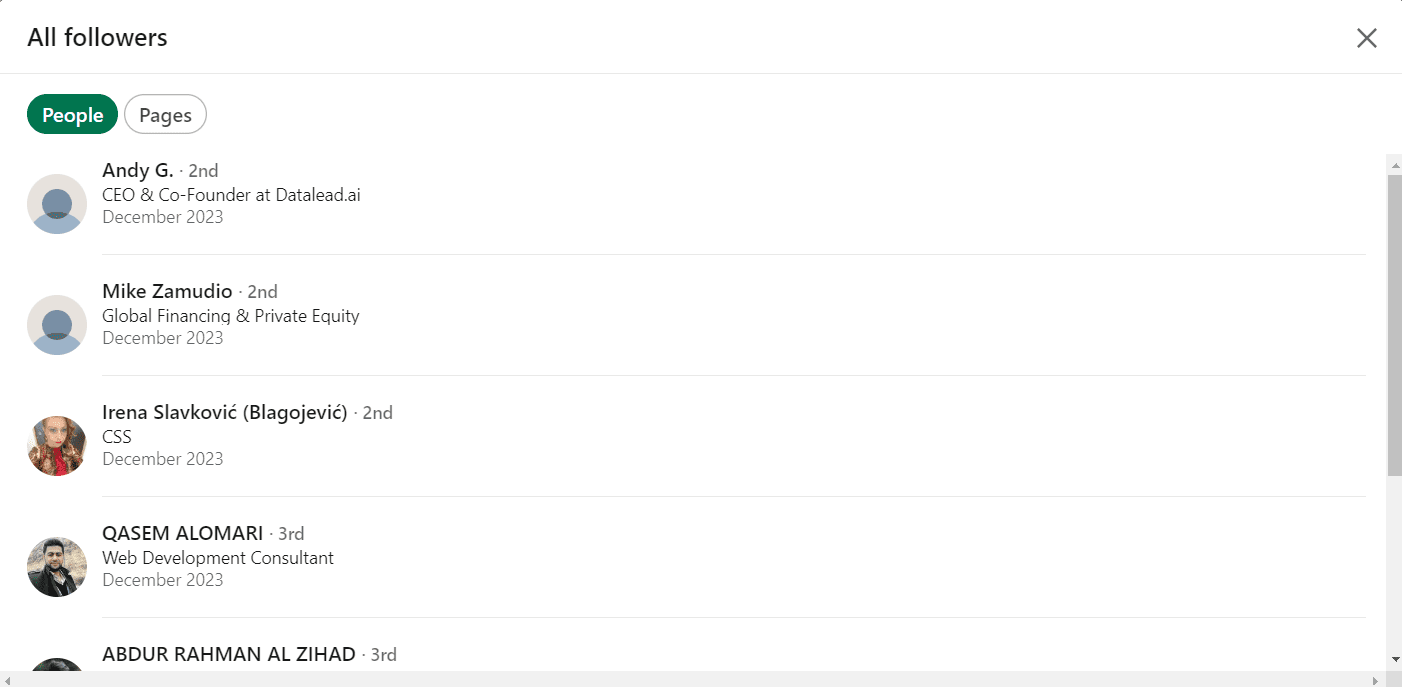
Option 2 - Sales Navigator spotlights filters: Leads that follow your company page
Step #1 Go to Sales Navigator Filters. Click “Lead Filters”.

Step #2 Choose the “Spotlight” filter. Click on “Leads that follow your company on LinkedIn”. You can use other filters to narrow down your search results.
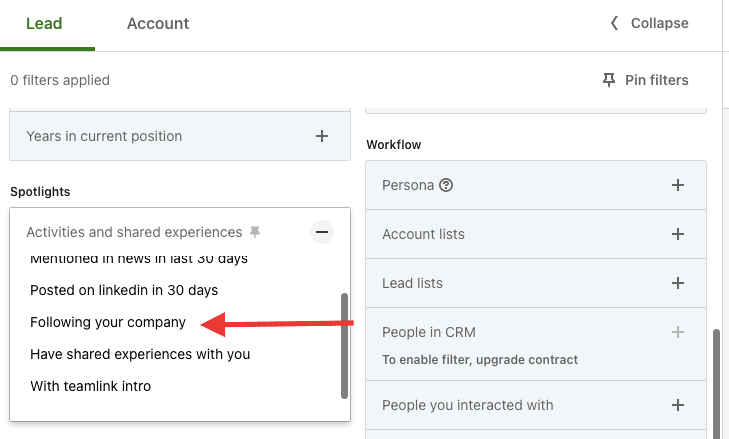
17. Check out the Who’s Viewed Your Profile feature
People view your LinkedIn profile for various reasons. You appeared:
- in their feed
- search results
- recommendations
- company website listings
- through mutual connections.
This indicates potential interest and a good sales rep will take any signal and turn it into a valid reason to reach out. Now go try it out!
This is where you can see who viewed your profile on LinkedIn. 👇
Option 1 - Check your notifications

Option 2 - Check out the Analytics section
The LinkedIn Analytics section is right below the section with your profile picture, name, headline, and other info.
Step #1 Find the “Analytics” section.

Step #2 Check out who viewed your profile.
You’ll find the list of LinkedIn members who viewed your profile. You can use the available filters to narrow down your list.

Interesting Viewers is a category of profile views that LinkedIn's algorithm assumes you'd be most interested in talking to. Aside from that, LinkedIn will categorize certain contacts according to their company, industry, occupation, etc. This can be useful for LinkedIn prospecting.
18. Activate the Bell feature
Did you know you can get notified if your prospect makes an action on their LinkedIn profile? If you activate the Bell feature, you won’t miss an opportunity to talk to your prospects, plus you can learn about their pain points and use that for your outreach messages. How to get the bell to ring? Follow the steps below 👇
Step #1 Go to your prospect’s LinkedIn profile. If you are not connected, click the “Follow” button first, and then turn the bell on. If they are your 1st-degree connection, just click the “Bell” button.
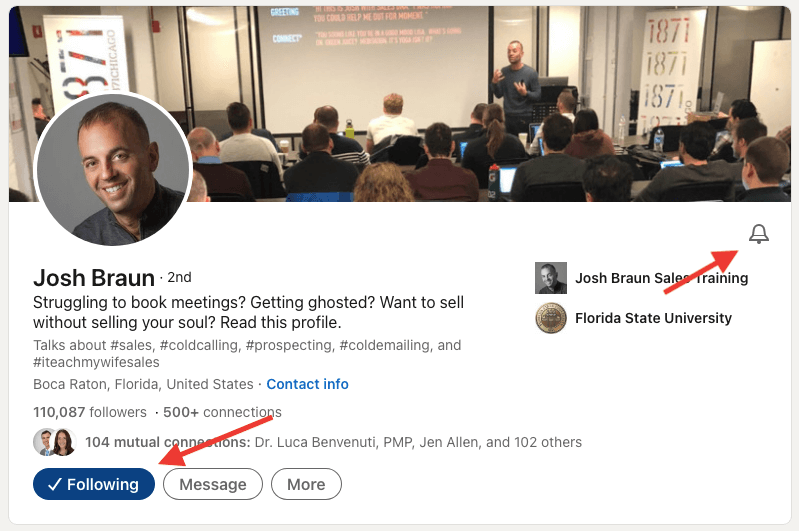
Step #2 You’ll get a notification each time your lead publishes something. It looks like this.

LinkedIn prospecting: The 4 do’s of sales prospecting
Here are the top 4 LinkedIn prospecting tips and best practices to have in mind when prospecting on LinkedIn.
1. Connect on a human level
Successful salespeople remember that prospects are humans and center their sales process, from prospecting to pitching, around this. Social selling, especially on platforms like LinkedIn, is challenging as is and requires frequent follow-ups.
To connect with prospects on a human level, it's important to show genuine care, share personal business struggles or advice, and respect their decision-making time. This approach leads to more positive returns and respects the human aspect of sales. LinkedIn prospecting gives you an insight on what your prospect is all about so you can connect on a deeper level, even online.
2. Provide value
Sales reps should focus on providing value in social selling, both through content and interactions with prospects, regardless of their response to sales pitches. Sharing industry knowledge on LinkedIn positions you as an expert, making prospects more likely to choose you over others.
Also, offering value through direct messages, like recommending resources, sharing ebooks, or giving advice about something they actually need, builds appreciation and trust, no matter their purchase decisions.
3. Personalize
Personalization is crucial in prospecting, and it goes beyond just using the prospect's name. It involves in-depth research to understand and segment prospects.
Image & GIF personalization is another effective technique, using customized images with the recipient’s data to capture attention.
4. Be patient
From what we’ve seen in sales, it’s safe to say with absolute certainty that you shouldn’t be pushy or aggressive with prospects, despite the pressure of monthly or quarterly quotas. Sales reps who focus on nurturing prospects and understanding their stage in the buyer's journey tend to meet their sales quotas more.
Prospects actually value the space to make decisions and appreciate sales approaches that aren't solely focused on closing a sale at any cost, so keep that in mind when reaching out.
LinkedIn prospecting: The don’ts of sales prospecting
Here’s what you should avoid at all costs when prospecting on LinkedIn. 👇
1. Overlooking Profiles Before Reaching Out
Not taking the time to research and go through your prospect’s profile thoroughly before reaching out can lead to irrelevant or inappropriate offers. You need to understand their interests, experiences and needs to help tailor just the right message.
2. Not Following Up
Always keep in mind that messages can be missed or forgotten. Not following up can be a huge mistake and lead to potential client loss. Sometimes, prospects need a little push before they do what you want them to. When writing a follow-up email after no response, make sure not to be too aggressive or pushy.
3. Neglecting LinkedIn Etiquette
Like in the real world, LinkedIn also has a set of rules you need to follow when communicating with people online. Neglecting LinkedIn etiquette could include endorsing people you don't know for skills, joining groups and immediately spamming them with your offers, or not respecting people's time and interests.
4. Ignoring Analytics and Feedback
Lastly, not tracking the performance of your outreach efforts (like response and open rates) could lead to bad outreach results. If you’re not adapting constantly based on real-time metrics and optimizing, you won’t reach any sales goals. So, remember to always look at the numbers and optimize accordingly.
Frequently asked questions about LinkedIn prospecting
How do I measure the success of my LinkedIn prospecting efforts?
Measure success by tracking metrics like connection acceptance, response rates, meetings arranged, and conversion rates. Consistently analyzing these metrics will help you understand the effectiveness of your strategies and make necessary adjustments to improve your prospecting efforts.
How can I ensure my LinkedIn outreach messages stand out from the competition?
Personalize your messages by referencing specific details from prospects' profiles. Create engaging, value-centric messages that invite a response. Tailoring your outreach to each prospect's interests and needs enhances the likelihood of initiating meaningful conversations, fostering professional relationships, and ultimately achieving successful connections.
What are the common pitfalls to avoid in LinkedIn prospecting, and how can I navigate them?
Avoid common pitfalls by steering clear of mass, impersonal messages and neglecting profile optimization. Focus on crafting tailored, value-driven outreach messages and maintaining a professional, up-to-date LinkedIn profile. Personalized communication combined with a polished online presence is key to sidestepping frequent errors and succeeding in your prospecting endeavors.
How to use LinkedIn Sales Navigator for prospecting?
Use Sales Navigator and its multiple features, such as advanced search and filtering, lead suggestions, and advanced notifications to search for the right audience - your ICP and Buyer Persona, then implement an outreach strategy, preferably using multiple channels.
How do you use LinkedIn for sales prospecting?
Optimize your LinkedIn profile, use LinkedIn or LinkedIn Sales Navigator to target specific leads, actively engage in relevant groups, consistently share insightful content, and effectively use InMail for personalized outreach.
How do I use LinkedIn for prospecting?
First, you need to define your Ideal Customer Profile. Then, identify companies matching it. Lastly, find your Buyer Persona within those companies. Use LinkedIn and Sales Navigator search filters to find qualified prospects. In this blog, we listed 19 additional strategies to find prospects on LinkedIn.
Does LinkedIn work for prospecting?
Yes. LinkedIn is a gold mine for finding qualified prospects for the majority of businesses. With the help of advanced search on LinkedIn and Sales Navigator, you can study prospect information to build qualified lead lists and proceed to implement your sales strategy with better results.
Ready to use LinkedIn prospecting for outreach?
If your goal is to grow your business and your business is outreach, LinkedIn prospecting should be an integral part of your outreach strategy.
Just be sure to define your ICP and use LinkedIn filters to really zero in on your target leads.
And if you need any help with your email outreach, try Skylead for free by signing up for a 7-day free trial.
Disclaimer: Skylead is not affiliated, endorsed by, or connected with LinkedIn in any way.
You already have your marketing agency and a few prosperous clients. Lately, you’ve been thinking of expanding your service list and offering more. What is it that would fit your clients’ needs best and still be in line with your industry? It’s outreach. Here’s why.
If you already offer social media management, content writing, copywriting, SEO, web development, or similar, it is high time to start thinking one step ahead of your competitors. By adding outreach, you will undoubtedly keep up with the times and give your customers a valuable reason to stick around longer.
Not only.
There are a series of reasons why incorporating outreach into your Lead Generation Agency would be the right call. Here are a few.
Customer loyalty
By adding the service of identifying and nurturing potential customers for your client’s products or services, you will be covering probably the most important segment of their prospecting. If they confide in the way you do their outreach, the chances of them staying loyal to your Lead Generation Agency increase, as you are controlling an additional sales channel of their business.
Furthermore, incorporating outreach in your marketing business will give your clients a well-rounded experience of generating leads on LinkedIn or via other methods.
Outreach as a new marketing segment
Adding outreach to your service list can also be a great way to attract new customers. Initially, newbies might only be interested in you identifying and nurturing their potential clients. However, if satisfied with your way of doing business, they might extend their request to other services that your Lead Generation Agency offers.
Additional revenue growth
By introducing a new marketing segment, you are raising your revenue stream.
Simply, adding an extra service means company growth. It also implies greater economic security, as your Lead Generation Agency doesn’t depend only on one or a few services.
Stand out in the lead generation industry
By incorporating outreach into your Lead Generation Agency, you might be making one step ahead of your competitors.
In case they thought of it first, draw attention to yourself by offering an impeccable, high-quality service. Better service attracts and retains better clients.
Also, think about your and your competitors’ Value Proposition. What is it that makes your outreach service stand out in comparison to your competition’s?
Outreach is easy to incorporate
You are probably already doing outreach to get more clients for your Lead Generation Agency. Therefore, you are familiar with the entire process of attracting new prospects and nurturing the old ones. All you need to do is expand your expertise to your clients. The more you develop this service for yourself, the better it will become for your customers as well. By growing your Lead Generation Agency, you will be growing an entire service within. Also, the better you become at doing outreach, you will most likely attract more clients for your Marketing Agency as well.
Minimal cost
The only things that you need for outreach are a laptop and an internet connection.
Create your client’s ICP (Ideal customer profile) and a cold outreach template with several follow-ups, and you can already start.
However, if you want to make this process far easier, you will need a tool for sales engagement and an Email Finder.
Luckily for you, there is a Sales Engagement Software that has these incorporated for as low as $100 per month. Long story short, it will save you both time and money.
Namely, Skylead combines multichannel outreach, has an “Email Discovery & Verification” feature for discovering and verifying your leads’ business emails, as well as “Image and GIF hyper-personalization” tool in case you want to do a bit of an unconventional outreach.

If you would like to know more about Skylead or try it out, jump in and test it out by starting a 7-day free trial.
White-labeling a solution
Think about white-labeling the Sales Engagement Tool that you are using.
A white-label product is a product or service produced by one company that other companies rebrand to make it appear as if they had made it.
By white-labeling the lead generation tool of your choice, you will:
- Boost your brand’s visibility;
- Enhance your customers’ loyalty;
- Eliminate the need for a development team of your own;
- Save time and money on your outreach;
- Upgrade your service;
- Scale your business;
- Strengthen your revenue stream.

That being said, know that you can white-label Skylead. To know more about this option, schedule a demo call with our team specialist.
How to start implementing your outreach?
Start with offering your service to the most loyal customers first
The advantage of offering your new service to the already existing and most loyal customers first is that you are very familiar with their business. That is, by handling other marketing segments for their companies, you have already gained a major insight into their business goals, targets, and preferences. This allows you to do prospecting and outreach leads with major precision and manage their outreach with more efficiency.
Furthermore, your already-established business relationship and cooperation will most likely reinforce. Upgrading your customers’ service package increases the possibility of enhancing their loyalty to your marketing agency. Additionally, you will be giving them a well-rounded Lead Generation experience. This approach, often adopted by top advertising agencies in the US, ensures that your clients receive a comprehensive service.
Attract your new customers by offering outreach first
In case you don’t want to introduce a new service before “testing it out”, try attracting new customers by using outreach as a bait. This way you don’t risk losing loyal customers in case something doesn’t go as planned. Additionally, you have space to learn, grow, and perfect your service before you offer it to your long-time clients.
Summary
In conclusion, incorporating outreach into your Lead Generation Agency has more upsides than downsides for sure.
By deciding to go for it you will:
- Enhance your customer loyalty;
- Attract new clients;
- Strengthen your revenue flow for introducing a new marketing segment;
- Stand out in the Lead Generation Industry.
Additionally, you have the option of making your life easier by going for a Sales Engagement Tool that has all the necessary features for a top-notch outreach.
Why Skylead?
For as low as $100 per month, with Skylead you can use multichannel outreach, and an Email Finder, all in one software.
Furthermore, thanks to the implementation of Smart sequences, Skylead allows you to create the highest number of personalizable touchpoints with your prospects.
5X more in comparison to other tools, to be precise.
It gives you the chance to combine two outreach channels, and no need for a separate Email Finder.
Actually, white-label it and make it your secret weapon!
To know more about the advantage of Skylead over other Sales Engagement Tools and to get to know its features, test it out and start a 7-day free trial.

